Paul van Yperen's Blog, page 31
November 30, 2024
Jimmy Durante
Jimmy Durante (1893-1980) was an American singer, pianist, comedian, writer, and actor. His famous nickname was 'The Great Schnozzola', referencing his big nose. He was also known for his deep raspy voice when he said "Ha-Cha-Cha-Chaaaaa!". He won an Emmy Award in 1952.
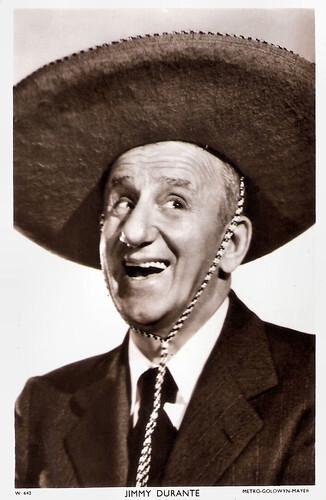
British postcard in the Picturegoer Series, London, no. W 643. Photo: Metro-Goldwyn-Mayer.
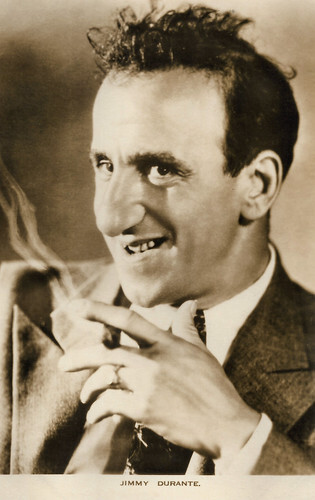
British postcard in the Film Weekly Series, London.
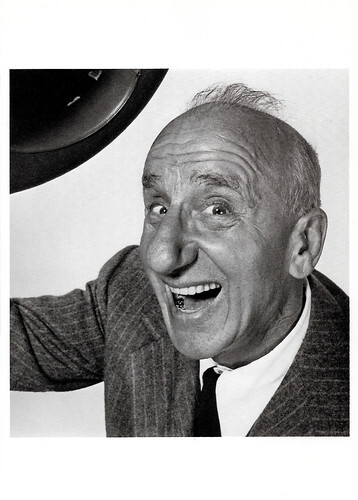
American postcard by Fotofolio, NY, NY, no. PH22. Photo: Philippe Halsman. Caption: Jimmy Durante, 1951.
Stop the music
James Francis 'Jimmy' Durante was born in 1893 in Brooklyn, New York. His family were Italian Catholics. Durante dedicated himself to becoming a piano player, performing in the usual dives, beer halls and public events.
He organised a ragtime band, playing for such spots as the Coney Island College Inn and Harlem's Alamo Club. He secured two long-lasting relationships in 1921 when he married Maud Jeanne Olson and formed a professional partnership with dancer Eddie Jackson.
Two years later Durante and Jackson combined with another dancer, Lou Jackson, to form one of the best-known roughhouse teams of the 1920s. Clayton, Jackson and Durante opened their speakeasy, the Club Durant (they couldn't afford the 'E' on the sign), quickly becoming the 'in' spot for show-business celebrities and the bane of Prohibition agents.
Durante was the star of the proceedings, adopting his lifelong stage character of an aggressive, belligerent singer, yelling "Stop the music"; at the slightest provocation and behaving as though he had to finish his song before the authorities hauled him away for having the nerve to perform.
Durante's trio went uptown in the Ziegfeld musical 'Show Girl' in 1929, the same year that Durante made his screen debut in Roadhouse Nights (Hobart Henley, 1929) starring Helen Morgan.
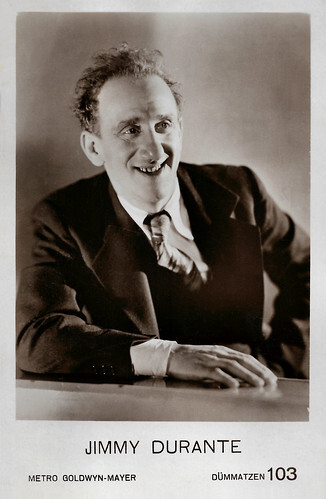
Spanish postcard by Dümmatzen no. 103. Photo: Metro Goldwyn Mayer.
What elephant?
In the 1930s, the megawatt Jimmy Durante acted in a comedy series with stone-faced comedian Buster Keaton . Though popular in personal appearances, Durante's overbearing performing style did not translate well to film.
Hal Erickson at AllMovie : "Though Durante and Keaton liked each other, their comedy styles were not compatible." He later appeared in The Wet Parade (Victor Fleming, 1932) starring Dorothy Jordan , and Broadway to Hollywood (Willard Mack, Jules White, 1933).
Durante reached his peak in films by 1934 and was thereafter used only as a specialty act or in supporting roles. On stage, however, Durante was still a proven audience favourite.
He stopped the show in the 1935 Billy Rose stage musical 'Jumbo', wherein, while leading a live elephant away from his creditors, he was stopped by a cop. "What are you doing with that elephant?" demanded the cop. Durante looked askance and bellowed, "What elephant?"
In hit after hit on Broadway, Durante was a metropolitan success. Later films include The Man Who Came to Dinner (William Keighley, 1942), playing 'Banjo', a character based on Harpo Marx, Ziegfeld Follies (Vincente Minnelli, a.o., 1946), and Billy Rose's Jumbo (Charles Walters, 1962), based on the 1935 musical.
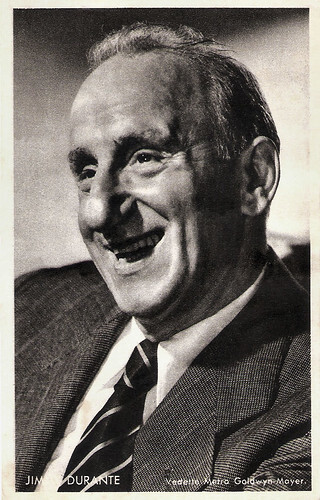
Belgian Collectors Card by Kwatta, Bois d'Haine. Photo: Metro-Goldwyn-Mayer.
Dialling G-O-D, and saying 'Thanks!
In 1943, Jimmy Durante expanded his popularity nationwide with a radio program co-starring young comedian Garry Moore. During the 1950s, Durante continued to thrive on TV.
On 4 August 1955, The Jimmy Durante Show on NBC was the venue of the final role by the famous Brazilian singer Carmen Miranda . Miranda fell to her knees while dancing with Durante, who quickly told the band, "STOP--the music!". He helped Miranda up to her feet as she laughed, "I'm all out of breath!". He replied, "That's OK, honey, I'll take your lines." Miranda laughed again and quickly pulled herself together and finished the show. However, the next morning, Miranda died at home from another heart attack.
Durante's last film was the classic comedy It's a Mad, Mad, Mad, Mad World (Stanley Kramer, 1963) with Spencer Tracy . By the mid-1960s, Durante was capable of fracturing a TV audience simply by mangling the words written for him on cue cards; a perennial of ABC's weekly Hollywood Palace, he took on a weekly series in his 76th year in a variety program co-starring the Lennon Sisters.
Suffering several strokes in the 1970s, Jimmy Durante decided to retire completely, though he occasionally showed up (in a wheelchair) for such celebrations as MGM's 50th anniversary.
Hal Erickson: "Few stars were as beloved as Durante, and even fewer were spoken of so highly and without any trace of jealousy or rancour after he died in 1980; perhaps this adulation was due in part to Durante's ending each performance by finding a telephone, dialling G-O-D, and saying 'Thanks!'"
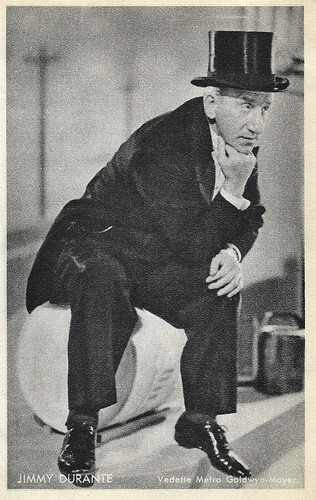
Belgian Collectors Card by Kwatta, Bois d'Haine. Photo: Metro-Goldwyn-Mayer. Collection: Geoffrey Donaldson Institute.
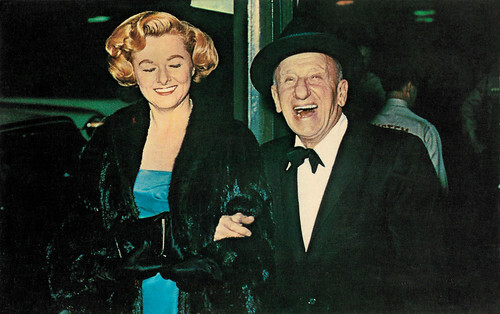
American Plastichrome postcard by Colourpicture Publishers, Boston, Mass. / Mitock & Sons, Sherman Oaks, Calif., no. P59003. Color by Don Andrews. Caption: Jimmy Durante arrives at the glamorous Hollywood Premiere.
Sources: Hal Erickson (AllMovie - now page defunct), Wikipedia and .

British postcard in the Picturegoer Series, London, no. W 643. Photo: Metro-Goldwyn-Mayer.

British postcard in the Film Weekly Series, London.

American postcard by Fotofolio, NY, NY, no. PH22. Photo: Philippe Halsman. Caption: Jimmy Durante, 1951.
Stop the music
James Francis 'Jimmy' Durante was born in 1893 in Brooklyn, New York. His family were Italian Catholics. Durante dedicated himself to becoming a piano player, performing in the usual dives, beer halls and public events.
He organised a ragtime band, playing for such spots as the Coney Island College Inn and Harlem's Alamo Club. He secured two long-lasting relationships in 1921 when he married Maud Jeanne Olson and formed a professional partnership with dancer Eddie Jackson.
Two years later Durante and Jackson combined with another dancer, Lou Jackson, to form one of the best-known roughhouse teams of the 1920s. Clayton, Jackson and Durante opened their speakeasy, the Club Durant (they couldn't afford the 'E' on the sign), quickly becoming the 'in' spot for show-business celebrities and the bane of Prohibition agents.
Durante was the star of the proceedings, adopting his lifelong stage character of an aggressive, belligerent singer, yelling "Stop the music"; at the slightest provocation and behaving as though he had to finish his song before the authorities hauled him away for having the nerve to perform.
Durante's trio went uptown in the Ziegfeld musical 'Show Girl' in 1929, the same year that Durante made his screen debut in Roadhouse Nights (Hobart Henley, 1929) starring Helen Morgan.

Spanish postcard by Dümmatzen no. 103. Photo: Metro Goldwyn Mayer.
What elephant?
In the 1930s, the megawatt Jimmy Durante acted in a comedy series with stone-faced comedian Buster Keaton . Though popular in personal appearances, Durante's overbearing performing style did not translate well to film.
Hal Erickson at AllMovie : "Though Durante and Keaton liked each other, their comedy styles were not compatible." He later appeared in The Wet Parade (Victor Fleming, 1932) starring Dorothy Jordan , and Broadway to Hollywood (Willard Mack, Jules White, 1933).
Durante reached his peak in films by 1934 and was thereafter used only as a specialty act or in supporting roles. On stage, however, Durante was still a proven audience favourite.
He stopped the show in the 1935 Billy Rose stage musical 'Jumbo', wherein, while leading a live elephant away from his creditors, he was stopped by a cop. "What are you doing with that elephant?" demanded the cop. Durante looked askance and bellowed, "What elephant?"
In hit after hit on Broadway, Durante was a metropolitan success. Later films include The Man Who Came to Dinner (William Keighley, 1942), playing 'Banjo', a character based on Harpo Marx, Ziegfeld Follies (Vincente Minnelli, a.o., 1946), and Billy Rose's Jumbo (Charles Walters, 1962), based on the 1935 musical.

Belgian Collectors Card by Kwatta, Bois d'Haine. Photo: Metro-Goldwyn-Mayer.
Dialling G-O-D, and saying 'Thanks!
In 1943, Jimmy Durante expanded his popularity nationwide with a radio program co-starring young comedian Garry Moore. During the 1950s, Durante continued to thrive on TV.
On 4 August 1955, The Jimmy Durante Show on NBC was the venue of the final role by the famous Brazilian singer Carmen Miranda . Miranda fell to her knees while dancing with Durante, who quickly told the band, "STOP--the music!". He helped Miranda up to her feet as she laughed, "I'm all out of breath!". He replied, "That's OK, honey, I'll take your lines." Miranda laughed again and quickly pulled herself together and finished the show. However, the next morning, Miranda died at home from another heart attack.
Durante's last film was the classic comedy It's a Mad, Mad, Mad, Mad World (Stanley Kramer, 1963) with Spencer Tracy . By the mid-1960s, Durante was capable of fracturing a TV audience simply by mangling the words written for him on cue cards; a perennial of ABC's weekly Hollywood Palace, he took on a weekly series in his 76th year in a variety program co-starring the Lennon Sisters.
Suffering several strokes in the 1970s, Jimmy Durante decided to retire completely, though he occasionally showed up (in a wheelchair) for such celebrations as MGM's 50th anniversary.
Hal Erickson: "Few stars were as beloved as Durante, and even fewer were spoken of so highly and without any trace of jealousy or rancour after he died in 1980; perhaps this adulation was due in part to Durante's ending each performance by finding a telephone, dialling G-O-D, and saying 'Thanks!'"

Belgian Collectors Card by Kwatta, Bois d'Haine. Photo: Metro-Goldwyn-Mayer. Collection: Geoffrey Donaldson Institute.

American Plastichrome postcard by Colourpicture Publishers, Boston, Mass. / Mitock & Sons, Sherman Oaks, Calif., no. P59003. Color by Don Andrews. Caption: Jimmy Durante arrives at the glamorous Hollywood Premiere.
Sources: Hal Erickson (AllMovie - now page defunct), Wikipedia and .
Published on November 30, 2024 22:00
November 29, 2024
Grace Kelly
American actress Grace Kelly (1929-1982) had a brief but very successful Hollywood career. She was the sparkling, elegant heroin in three classic Alfred Hitchcock thrillers. Her talents rivalled her beauty, winning her a Best Actress Oscar for The Country Girl in 1954. Then Europe imported her. After marrying Prince Rainier III in April 1956, she became Princess of Monaco and retired from the cinema.
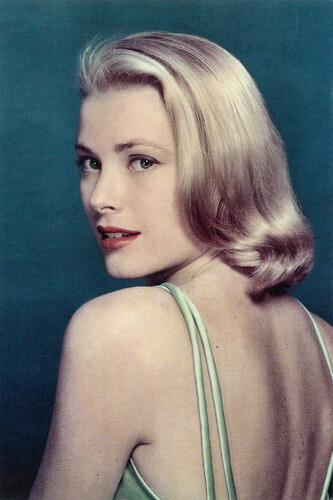
Australian freecard by AvantCard postcard, no. 16219. Photo: Philippe Halsman. This card promoted the exhibition 'Grace Kelly - Style Icon' in the Bendigo Art Gallery in 2012.
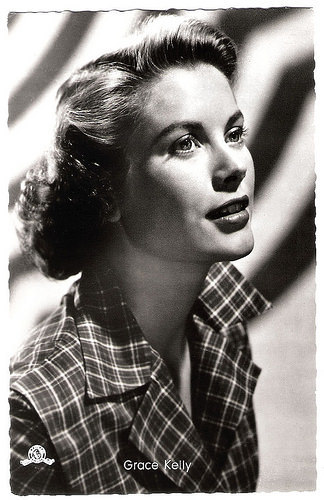
German postcard by Kolibri-Verlag G.m.b.H., Minden Westf., no. 1878. Photo: Metro-Goldwyn-Mayer. Publicity still for Mogambo (John Ford, 1953).
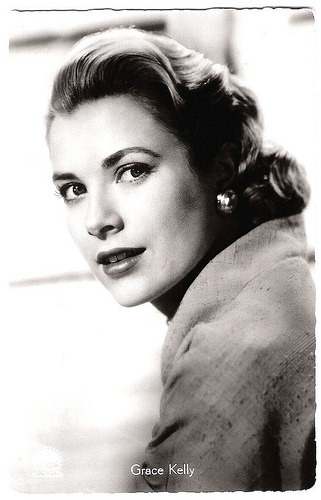
German postcard by Kolibri-Verlag G.m.b.H., Minden Westf., no. 1878. Photo: Paramount. Publicity still for Rear Window (Alfred Hitchcock, 1954).
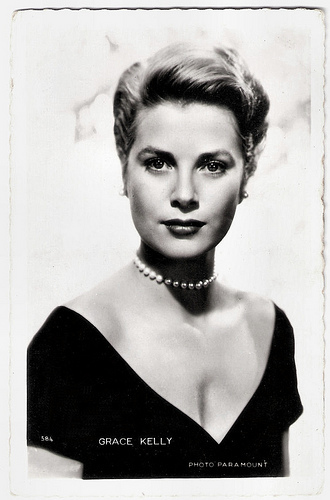
French postcard by Editions P.I., Paris, no. 584, Photo: Paramount, 1954.
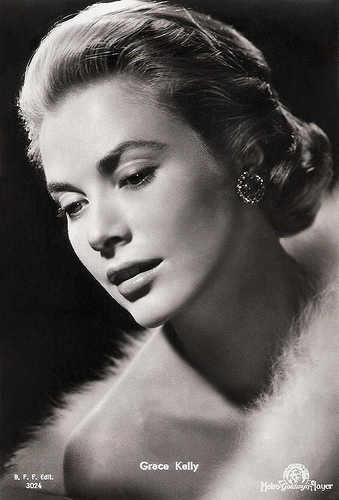
Italian postcard by B.F.F. Edit. (Ballerini & Fratini, Firenze), no. 3024. Photo: Metro-Goldwyn-Mayer.
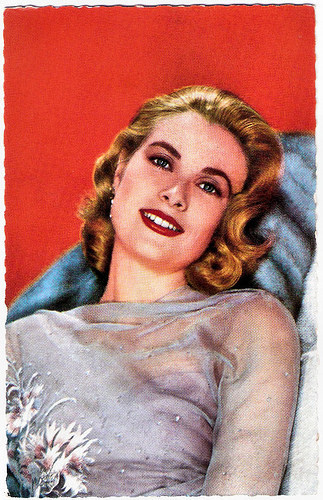
West-German postcard by Kolibri-Verlag G.m.b.H., Minden (Westf.), no. F 38. Photo: Metro-Goldwyn-Mayer (MGM). Publicity still for High Society (Charles Walters, 1956).
Breeding, quality and class
Grace Patricia Kelly was born in 1929 in Philadelphia, Pennsylvania. She was the daughter of Margaret Katherine Majer, who had taught physical education at the University of Pennsylvania, and John Brendan Kelly, Sr., who owned a successful brickwork contracting company and was a three-time Olympic Gold winner for rowing. Her uncle was Pulitzer Prize-winning playwright George Kelly.
At an early age, Grace decided to become an actress. After her high school graduation in 1947, she struck out on her own, heading to New York. Despite her parents' disapproval, she attended and graduated from the American Academy of Dramatic Arts. She worked as a model and in 1949, she made her Broadway debut in a revival of August Strindberg's 'The Father' alongside Raymond Massey.
At 19, her graduation performance was as Tracy Lord in 'The Philadelphia Story'. Grace also made a foray into the infant medium of television and appeared in 60 live drama productions between 1950 and 1953. Her success on television brought her to the attention of Hollywood.
Her first film was Fourteen Hours (Henry Hathaway, 1951) when she was 22. It was a small part, but a start nonetheless. The following year, she landed the role of Amy Kane in the now-classic Western High Noon (Fred Zinnemann, 1952), opposite starring Gary Cooper . The film turned out to be very popular. Curiously, however, she did not benefit from the film's success, and no other offers were immediately forthcoming.
In 1953, Grace appeared in only one film, the popular jungle drama Mogambo (John Ford, 1953). She played Linda Nordley next to Clark Gable and Ava Gardner . Director John Ford said that she showed "breeding, quality and class". Her role won her a Golden Globe Award and an Academy Award nomination for Best Supporting Actress in 1954. Grace signed a seven-year contract with MGM.
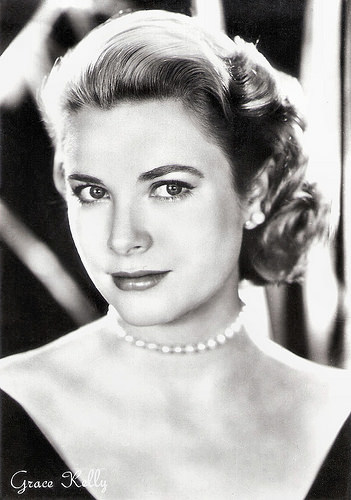
Italian postcard by Rotalfoto, Milano, no. 552.
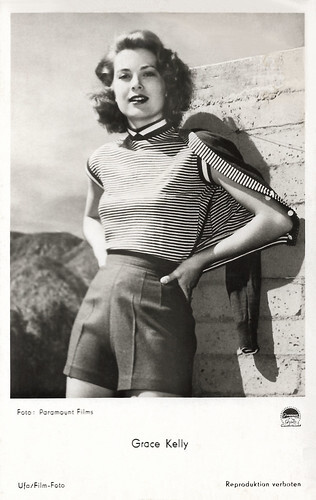
West German postcard by Ufa/Film-Foto, Berlin-Tempelhof, no FK 1909. Photo: Paramount.
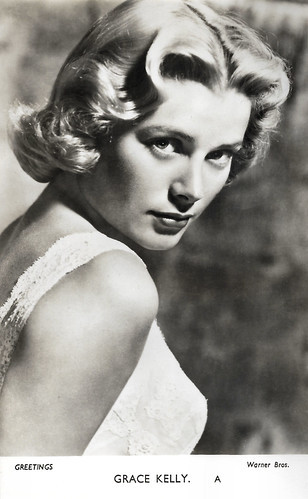
British postcard in the Greetings Series, A. Photo: Warner Bros. Grace Kelly in Dial M for Murder (Alfred Hitchcock, 1954).
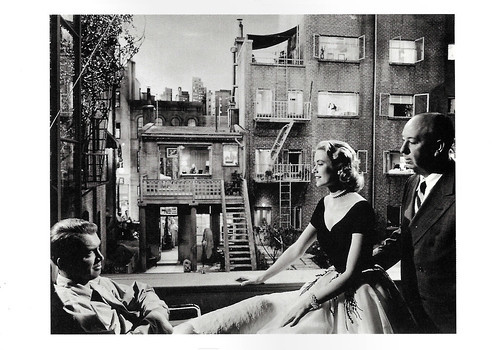
French postcard in the Collection Magie Noire nu Editions Hazan, Paris, no. 6490, 1996. James Stewart , Grace Kelly and Alfred Hitchcock at the set of Rear Window (Alfred Hitchcock, 1954).
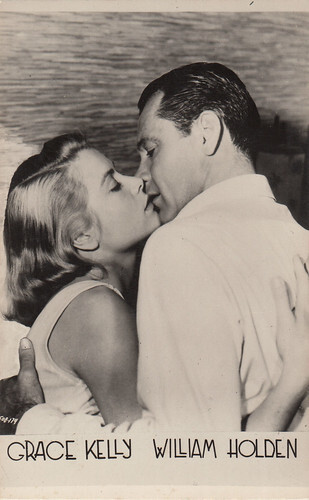
Italian postcard by Grafica Fotocolor, Roma. Grace Kelly and William Holden in The Bridges at Toko-Ri (Mark Robson, 1954). Collection: Marlene Pilaete.
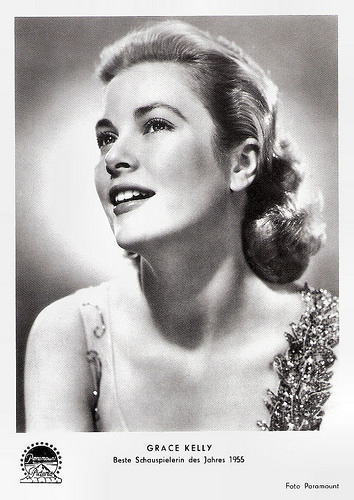
Modern German postcard by K & B / Filmwelt Berlin Archiv für Film-Geschichte, no. KB 55. Photo: Paramount. Publicity still for To Catch a Thief (Alfred Hitchcock, 1955). Caption: Best Actress of the Year 1955.
Hitchcock's perfect blonde
It was master director Alfred Hitchcock who turned Grace Kelly into a major star. She was the perfect blonde he had been seeking throughout his career. Her first film for him was Dial M for Murder (Alfred Hitchcock, 1954), the screen adaptation of Frederick Knott's Broadway hit.
Then followed her standout performance as elegant socialite Lisa Fremont in the brilliant Rear Window (Alfred Hitchcock, 1954). She was cast opposite James Stewart , who played a photographer who witnesses a murder in an apartment across the courtyard while convalescing in a wheelchair. TCM : “The dazzlingly designed Hitchcock classic would showcase Kelly's beauty and her true personality.”
In 1954 Kelly appeared in five films. She won the Academy Award for Best Actress for her portrayal of Georgie Elgin, the wife of a washed-up crooner ( Bing Crosby ) in The Country Girl (George Seaton, 1954) a film version of Clifford Odets' Broadway hit. William Holden played a director of a Broadway play, who falls for Kelly's character after casting her depressed and alcoholic husband, - an uncomfortable love triangle that mirrored real life. Reportedly Kelly had affairs with both Holden and Crosby.
In 1955, Grace teamed for the third and final time with Hitchcock on To Catch a Thief (Alfred Hitchcock, 1955), co-starring Cary Grant . Hal Erickson at AllMovie : “To Catch a Thief is actually as enjoyable and engaging now as it was 40 years ago. Though the Riviera location photography is pleasing, our favourite scene takes place in a Paramount Studios mockup of a luxury hotel suite, where Grant and Kelly make love while a fireworks display orgasmically erupts outside their window.”
In 1956, she again played Tracy Lord, now in the musical comedy High Society (Charles Walters, 1956), based on the Oscar-winning comedy The Philadelphia Story (George Cukor, 1940). The whimsical tale ended with her re-marrying her former husband, played by Bing Crosby . The film was a hit but was her final acting performance.
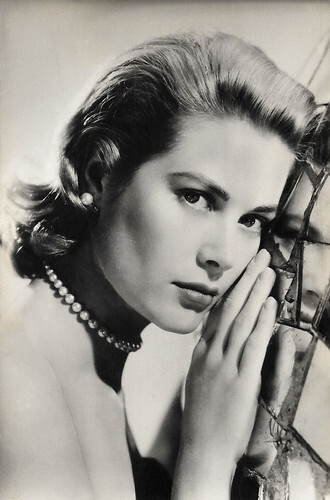
Spanish postcard, no. 1613.
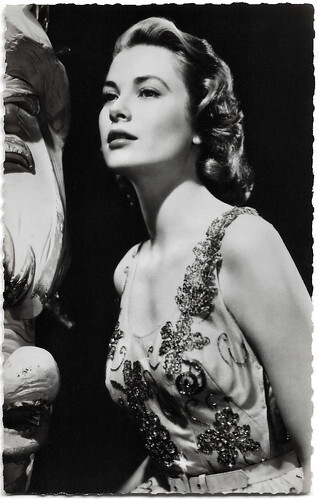
French postcard b Editions du Globe, Paris, no. 383, 1954. Photo: Paramount.
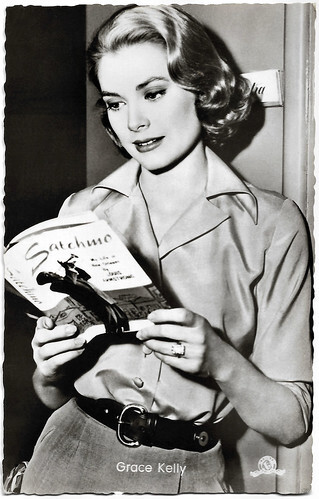
West German postcard by Kolibri Verlag G.m.b.H., Minden/Westf., no. 2506. Photo: MGM. Grace Kelly on the set of High Society (Charles Walters, 1956).
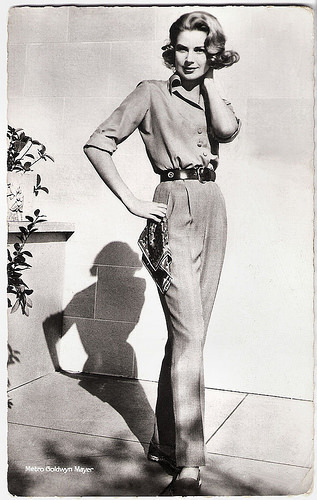
French postcard by Editions du Globe, no. 498, Photo: Virgil Apger / Metro Goldwyn Mayer. Key-set portrait from High Society (Charles Walters, 1956).
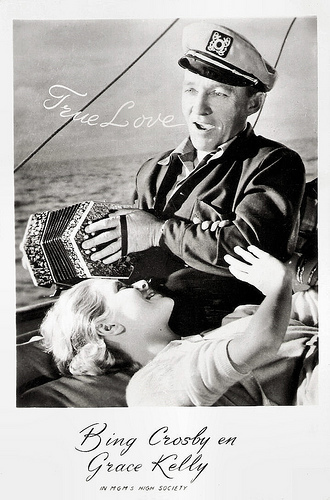
Dutch postcard by Uitg. Takken, Utrecht, no. 3021. Photo: Metro Goldwyn Mayer. Publicity still for High Society (Charles Walters, 1956) with Bing Crosby .
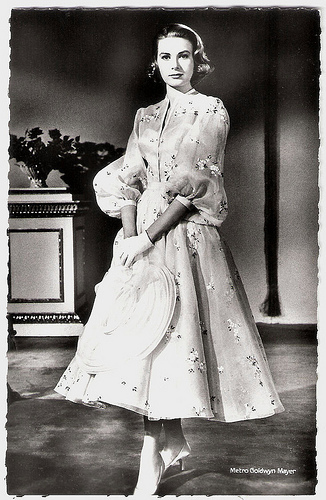
French postcard by Editions du Globe, Paris, no. 496. Photo: Metro Goldwyn Mayer. Publicity still for High Society (Charles Walters, 1956).
A lavish wedding watched by 30 million viewers
In 1955, Grace Kelly met Prince Rainier III of Monaco during the Cannes Film Festival. She broke off her affair with fashion designer Oleg Cassini to marry the Prince.
News of the engagement was a sensation. The lavish wedding in 1956 was estimated to have been watched by over 30 million viewers on live television. Grace and Rainier had three children: Princess Caroline of Monaco (1957), Prince Albert of Monaco (1958) and Princess Stéphanie of Monaco (1965).
Reportedly, Grace hoped to return to acting in Alfred Hitchcock 's Marnie (1964), but Monaco's citizens were outraged about the idea of their princess playing a kleptomaniac and kissing Sean Connery . So, Marnie premiered in 1964 with Tippi Hedren in the role intended for Kelly.
Prince Rainier later dismissed director Herbert Ross's entreaties for Grace to star in his drama The Turning Point (1977). For the rest of her life, Grace was to remain in the news with her marriage and her three children. As Princess of Monaco, she retained her American roots, maintaining dual U.S. and Monegasque citizenship.
In 1982, Princess Grace died in Monaco, a day after suffering a stroke while driving, causing her to crash. She was 52. An estimated 100 million people viewed her funeral on TV. Rainier, who never remarried, was buried alongside her following his death in 2005.
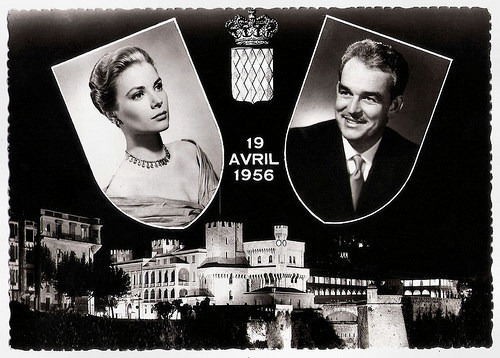
19 April 1956; the wedding with Prince Rainier of Monaco. Monegasque postcard by S.A.P.I., Monaco. Photos: Harcourt and Picédi.
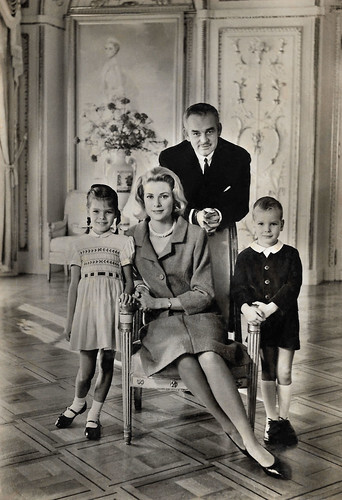
Monegasque postcard of the Collection Archives du Palais Princier, Monaco. Caption: Prince Rainier III. Princess Grace, Prince Albert and Princess Caroline.
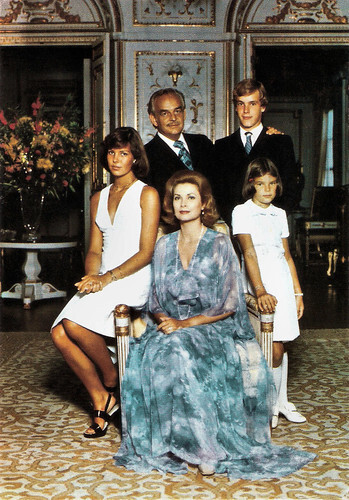
Monegasque postcard by Collection Archives du Palais Princier. Sent by mail in 1975. Photo: Gianni Bozzaccin.
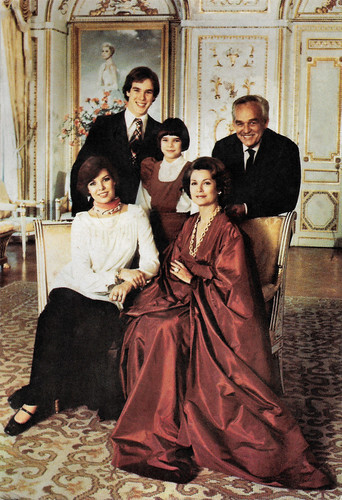
Monegasque postcard of the Collection Archives du Palais Princier, Monaco. Photo: Howell Conant. Caption: Prince Rainier III. Princess Grace, Princess Caroline, Prince Albert and Princess Stephanie. Sent by mail in 1979.
Trailer Mogambo (1953). Source: Movieclips Trailer Vault (YouTube).
Trailer Dial M for Murder (1954). Source: Movieclips Trailer Vault (YouTube).
Trailer Rear Window (1954). Source: Movieclips Trailer Vault (YouTube).
Trailer High Society (1956). Source: Movieclips Trailer Vault (YouTube).
Sources: (IMDb), (IMDb), Jason Ankeny (AllMovie - page now defunct), Hal Erickson (AllMovie - page now defunct), TCM (page now defunct), Wikipedia and .

Australian freecard by AvantCard postcard, no. 16219. Photo: Philippe Halsman. This card promoted the exhibition 'Grace Kelly - Style Icon' in the Bendigo Art Gallery in 2012.

German postcard by Kolibri-Verlag G.m.b.H., Minden Westf., no. 1878. Photo: Metro-Goldwyn-Mayer. Publicity still for Mogambo (John Ford, 1953).

German postcard by Kolibri-Verlag G.m.b.H., Minden Westf., no. 1878. Photo: Paramount. Publicity still for Rear Window (Alfred Hitchcock, 1954).

French postcard by Editions P.I., Paris, no. 584, Photo: Paramount, 1954.

Italian postcard by B.F.F. Edit. (Ballerini & Fratini, Firenze), no. 3024. Photo: Metro-Goldwyn-Mayer.

West-German postcard by Kolibri-Verlag G.m.b.H., Minden (Westf.), no. F 38. Photo: Metro-Goldwyn-Mayer (MGM). Publicity still for High Society (Charles Walters, 1956).
Breeding, quality and class
Grace Patricia Kelly was born in 1929 in Philadelphia, Pennsylvania. She was the daughter of Margaret Katherine Majer, who had taught physical education at the University of Pennsylvania, and John Brendan Kelly, Sr., who owned a successful brickwork contracting company and was a three-time Olympic Gold winner for rowing. Her uncle was Pulitzer Prize-winning playwright George Kelly.
At an early age, Grace decided to become an actress. After her high school graduation in 1947, she struck out on her own, heading to New York. Despite her parents' disapproval, she attended and graduated from the American Academy of Dramatic Arts. She worked as a model and in 1949, she made her Broadway debut in a revival of August Strindberg's 'The Father' alongside Raymond Massey.
At 19, her graduation performance was as Tracy Lord in 'The Philadelphia Story'. Grace also made a foray into the infant medium of television and appeared in 60 live drama productions between 1950 and 1953. Her success on television brought her to the attention of Hollywood.
Her first film was Fourteen Hours (Henry Hathaway, 1951) when she was 22. It was a small part, but a start nonetheless. The following year, she landed the role of Amy Kane in the now-classic Western High Noon (Fred Zinnemann, 1952), opposite starring Gary Cooper . The film turned out to be very popular. Curiously, however, she did not benefit from the film's success, and no other offers were immediately forthcoming.
In 1953, Grace appeared in only one film, the popular jungle drama Mogambo (John Ford, 1953). She played Linda Nordley next to Clark Gable and Ava Gardner . Director John Ford said that she showed "breeding, quality and class". Her role won her a Golden Globe Award and an Academy Award nomination for Best Supporting Actress in 1954. Grace signed a seven-year contract with MGM.

Italian postcard by Rotalfoto, Milano, no. 552.

West German postcard by Ufa/Film-Foto, Berlin-Tempelhof, no FK 1909. Photo: Paramount.

British postcard in the Greetings Series, A. Photo: Warner Bros. Grace Kelly in Dial M for Murder (Alfred Hitchcock, 1954).

French postcard in the Collection Magie Noire nu Editions Hazan, Paris, no. 6490, 1996. James Stewart , Grace Kelly and Alfred Hitchcock at the set of Rear Window (Alfred Hitchcock, 1954).

Italian postcard by Grafica Fotocolor, Roma. Grace Kelly and William Holden in The Bridges at Toko-Ri (Mark Robson, 1954). Collection: Marlene Pilaete.

Modern German postcard by K & B / Filmwelt Berlin Archiv für Film-Geschichte, no. KB 55. Photo: Paramount. Publicity still for To Catch a Thief (Alfred Hitchcock, 1955). Caption: Best Actress of the Year 1955.
Hitchcock's perfect blonde
It was master director Alfred Hitchcock who turned Grace Kelly into a major star. She was the perfect blonde he had been seeking throughout his career. Her first film for him was Dial M for Murder (Alfred Hitchcock, 1954), the screen adaptation of Frederick Knott's Broadway hit.
Then followed her standout performance as elegant socialite Lisa Fremont in the brilliant Rear Window (Alfred Hitchcock, 1954). She was cast opposite James Stewart , who played a photographer who witnesses a murder in an apartment across the courtyard while convalescing in a wheelchair. TCM : “The dazzlingly designed Hitchcock classic would showcase Kelly's beauty and her true personality.”
In 1954 Kelly appeared in five films. She won the Academy Award for Best Actress for her portrayal of Georgie Elgin, the wife of a washed-up crooner ( Bing Crosby ) in The Country Girl (George Seaton, 1954) a film version of Clifford Odets' Broadway hit. William Holden played a director of a Broadway play, who falls for Kelly's character after casting her depressed and alcoholic husband, - an uncomfortable love triangle that mirrored real life. Reportedly Kelly had affairs with both Holden and Crosby.
In 1955, Grace teamed for the third and final time with Hitchcock on To Catch a Thief (Alfred Hitchcock, 1955), co-starring Cary Grant . Hal Erickson at AllMovie : “To Catch a Thief is actually as enjoyable and engaging now as it was 40 years ago. Though the Riviera location photography is pleasing, our favourite scene takes place in a Paramount Studios mockup of a luxury hotel suite, where Grant and Kelly make love while a fireworks display orgasmically erupts outside their window.”
In 1956, she again played Tracy Lord, now in the musical comedy High Society (Charles Walters, 1956), based on the Oscar-winning comedy The Philadelphia Story (George Cukor, 1940). The whimsical tale ended with her re-marrying her former husband, played by Bing Crosby . The film was a hit but was her final acting performance.

Spanish postcard, no. 1613.

French postcard b Editions du Globe, Paris, no. 383, 1954. Photo: Paramount.

West German postcard by Kolibri Verlag G.m.b.H., Minden/Westf., no. 2506. Photo: MGM. Grace Kelly on the set of High Society (Charles Walters, 1956).

French postcard by Editions du Globe, no. 498, Photo: Virgil Apger / Metro Goldwyn Mayer. Key-set portrait from High Society (Charles Walters, 1956).

Dutch postcard by Uitg. Takken, Utrecht, no. 3021. Photo: Metro Goldwyn Mayer. Publicity still for High Society (Charles Walters, 1956) with Bing Crosby .

French postcard by Editions du Globe, Paris, no. 496. Photo: Metro Goldwyn Mayer. Publicity still for High Society (Charles Walters, 1956).
A lavish wedding watched by 30 million viewers
In 1955, Grace Kelly met Prince Rainier III of Monaco during the Cannes Film Festival. She broke off her affair with fashion designer Oleg Cassini to marry the Prince.
News of the engagement was a sensation. The lavish wedding in 1956 was estimated to have been watched by over 30 million viewers on live television. Grace and Rainier had three children: Princess Caroline of Monaco (1957), Prince Albert of Monaco (1958) and Princess Stéphanie of Monaco (1965).
Reportedly, Grace hoped to return to acting in Alfred Hitchcock 's Marnie (1964), but Monaco's citizens were outraged about the idea of their princess playing a kleptomaniac and kissing Sean Connery . So, Marnie premiered in 1964 with Tippi Hedren in the role intended for Kelly.
Prince Rainier later dismissed director Herbert Ross's entreaties for Grace to star in his drama The Turning Point (1977). For the rest of her life, Grace was to remain in the news with her marriage and her three children. As Princess of Monaco, she retained her American roots, maintaining dual U.S. and Monegasque citizenship.
In 1982, Princess Grace died in Monaco, a day after suffering a stroke while driving, causing her to crash. She was 52. An estimated 100 million people viewed her funeral on TV. Rainier, who never remarried, was buried alongside her following his death in 2005.

19 April 1956; the wedding with Prince Rainier of Monaco. Monegasque postcard by S.A.P.I., Monaco. Photos: Harcourt and Picédi.

Monegasque postcard of the Collection Archives du Palais Princier, Monaco. Caption: Prince Rainier III. Princess Grace, Prince Albert and Princess Caroline.

Monegasque postcard by Collection Archives du Palais Princier. Sent by mail in 1975. Photo: Gianni Bozzaccin.

Monegasque postcard of the Collection Archives du Palais Princier, Monaco. Photo: Howell Conant. Caption: Prince Rainier III. Princess Grace, Princess Caroline, Prince Albert and Princess Stephanie. Sent by mail in 1979.
Trailer Mogambo (1953). Source: Movieclips Trailer Vault (YouTube).
Trailer Dial M for Murder (1954). Source: Movieclips Trailer Vault (YouTube).
Trailer Rear Window (1954). Source: Movieclips Trailer Vault (YouTube).
Trailer High Society (1956). Source: Movieclips Trailer Vault (YouTube).
Sources: (IMDb), (IMDb), Jason Ankeny (AllMovie - page now defunct), Hal Erickson (AllMovie - page now defunct), TCM (page now defunct), Wikipedia and .
Published on November 29, 2024 22:00
November 28, 2024
Hans Nielsen
Hans Nielsen (1911-1965) was a German actor and assistant director. He was known for such films as Titanic (1943), Nachtwache (1949) and Town Without Pity (1961). He appeared in more than 130 films between 1937 and 1965.
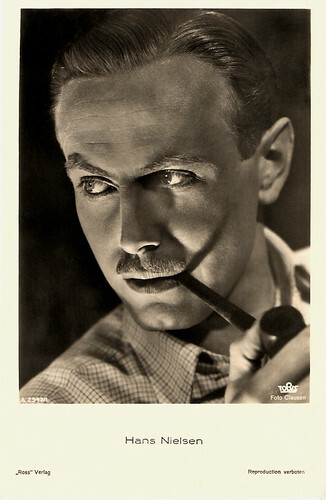
German postcard by Ross Verlag, no. A 2543/1, 1939-1940. Photo: Clausen / Tobis.
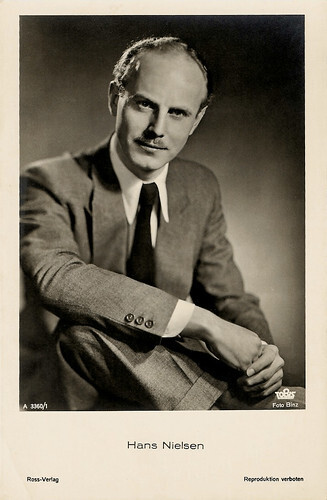
German postcard by Ross Verlag, no. A 3360/1, 1941-1944. Photo: Binz / Tobis.
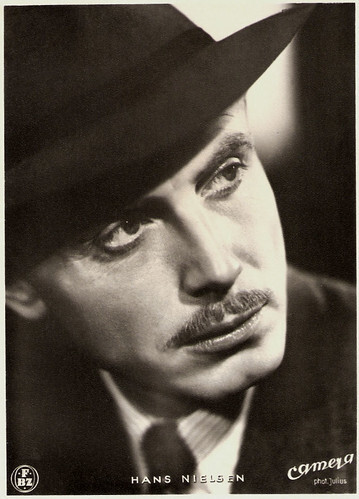
German postcard by F.B.Z. Photo: Camera Film / Kurt Julies (Julius).
Titanic
Hans Albert Nielsen was born in 1911 as the son of a merchant in Hamburg, Germany. After attending secondary school he took an apprenticeship as a merchant. He only completed it for the sake of his parents, because he took acting lessons with Albrecht Schoenhals and Erich Ziegel and also trained in singing. In 1932, Nielsen made his theatre debut at the Hamburger Kammerspiele. Further engagements took him to Augsburg, Kiel and Leipzig in the following months. Many actors and performing artists fled Nazi Germany, but Nielsen remained. In 1938, Nielsen went to Berlin and performed at various theatres.
The talented actor had already attracted the attention of the film industry in the mid-1930s and Nielsen made his screen debut with a small part in the romantic comedy Daphne und der Diplomat/Daphne and the Diplomat (Robert A. Stemmle, 1937) in the same year he appeared as pilot Billy Sefton in the melodrama Tango Notturno (Fritz Kirchhoff, 1937). A year later, he took on the role of Max von Wendlowsky in the Zarah Leander film Heimat (Carl Froelich, 1938), based on the play by Hermann Sudermann.
Productions such as the initially banned historical drama Preußische Liebesgeschichte/A Prussian Love Story (Paul Martin, 1938), the adventure Aufruhr in Damaskus/Uproar in Damascus (Gustacv Ucicky, 1939), and the crime thriller Alarm auf Station III/Alarm at Station III (Philipp Lothar Mayring, 1939) followed until the end of the 1930s. In the 1940s, Nielsen appeared in the euthanasia drama Ich klage an/I Accuse (Wolfgang Liebeneiner,1941) as Dr Höfer, which is still considered a ”reserved film’ today.
In the drama Titanic (Herbert Selpin, 1943) about the sinking of the luxury liner RMS Titanic in 1912, Nielsen played the German first officer Petersen. Titanic was commissioned by Nazi Propaganda Minister Joseph Goebbels with the intent of showing not only the superiority of German filmmaking but also as a propaganda vehicle which would depict British and American capitalism as being responsible for the disaster. The addition of an entirely fictional heroic German officer, Petersen, to the ship's crew, was intended to demonstrate the superior bravery and selflessness of German men as compared to the British officers. The film's original director, Herbert Selpin, was arrested during production after making disparaging comments about the German army and the war in the East. He was found hanged in prison, and the film was completed by Werner Klingler, who was not credited.
Although the film had a brief theatrical run in parts of German-occupied Europe starting in November 1943, it was not shown within Germany by order of Goebbels, who feared that it would weaken the German citizenry's morale instead of improving it, as heavy Allied bombing raids made a film depicting mass panic and death unappealing. Goebbels later banned the film's playing entirely, and it did not have a second run. Until the end of the war, Nielsen appeared in productions including the drama Der große König/The Great King (Veit Harlan, 1942) starring Otto Gebühr . The comedy Dr. Phil. Döderlein (1945) remained unfinished.
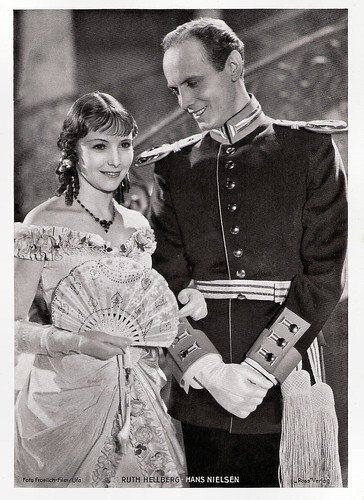
Big German card by Ross Verlag. Photo: Froelich-Film / Ufa. Ruth Hellberg and Hans Nielsen in Heimat (Carl Froelich, 1938).
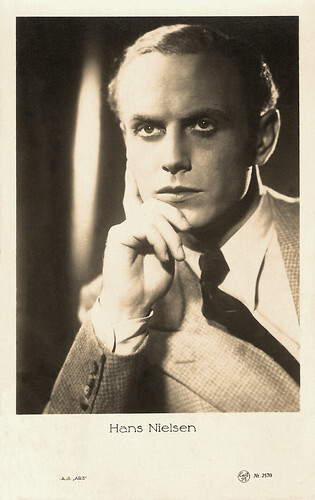
Latvian postcard by E&B, Riga, no. 2570. Photo: A.S. "Ars". Sent by mail in 1938.
Different from you and me
After the end of the Second World War, Hans Nielsen was able to continue his earlier successes on the big screen with mostly high-profile supporting roles, but also leading roles. He appeared, for example, as King Peter Petroni in the comedy of mistaken identity Herzkönig/King of Hearts (Helmut Weiss, 1947) and as Wolfgang Grunelius in the episodic film In jenen Tagen/In Those Days (1947) directed by Helmuth Käutner . It was one of the cycle of Rubble films made in the wake of Germany's defeat during World War II.
In 1949, he shone alongside Luise Ullrich and Dieter Borsche in the drama Nachtwache/Keepers of the Night (Harald Braun, 1949). He impressively portrayed the pastor Johannes Heger, who finds himself in a conflict of conscience. In 1950, he was seen in the role of chief inspector Thomsen in Kurt Hoffmann's crime thriller Fünf unter Verdacht/Five Suspects (1950), based on the novel ‘Thomas verhört die Prima’ by Herbert Moll and Rudolf Becker.
He often played good-natured, likeable and elegant roles, like the presiding judge in the satire Hokuspokus/Hocuspocus (Kurt Hoffmann, 1953). He usually appeared older in his roles than he was, often playing the benevolent head of the family. However, many of the productions in which Nielsen appeared were successful not least because of him.
In the criminal melodrama Teufel in Seide/Devil in Silk (Rolf Hansen, 1955) with Lilli Palmer and Curd Jürgens , he was the committed defence lawyer, as well as in the legal drama Gestehen Sie, Dr. Corda!/Confess, Doctor Corda! (Josef von Báky, 1958) with Hardy Krüger and Kriegsgericht/Court Martial (Kurt Meisel, 1959), based on the story ‘Kreuzer Pommern’ by Willi Berthold with Karlheinz Böhm , Christian Wolff and Klaus Kammer as three shipwrecked German marines. In Wolfgang Liebeneiner 's romanticised historical film Königin Luise/Queen Luise (1957), he lent character to Minister Karl August von Hardenberg alongside Ruth Leuwerik as Queen Luise.
His role as Max Mertens in Anders als du und ich/Different from You and Me (Veit Harlan, 1957) is rather negligible. As Filmdienst.de notes: ‘The film by no means sees homosexuality as a positive alternative to life, and also defames abstract painting and atonal music, which it portrays as the expression of such an ‘attitude to life’.
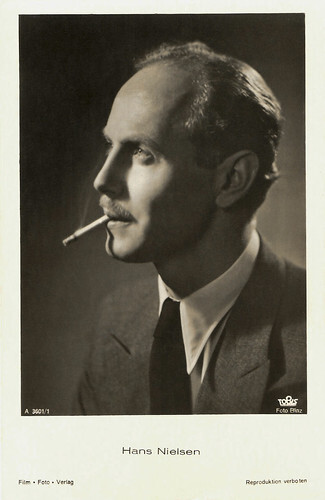
German postcard by Film-Foto-Verlag, no. A 3601/1. Photo: Tobis / Binz.
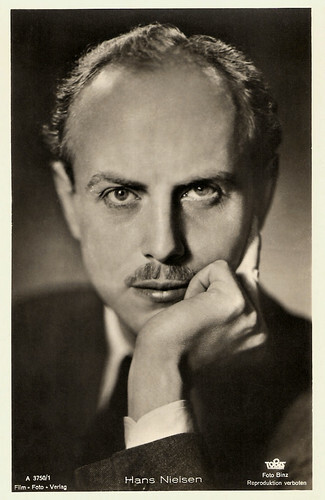
German postcard by Film-Foto-Verlag, no. A 3750/1, 1941-1944. Photo: Tobis / Binz.
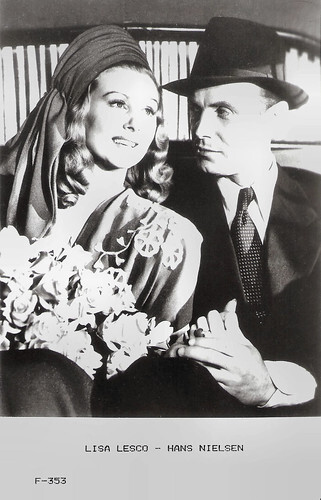
German postcard by Netter's Starverlag, Berlin, no. F-353. Lisa Lesco and Hans Nielsen in Herzkönig/King of Hearts (Helmut Weiss, 1947).
Scotland Yard vs. Dr Mabuse
Hans Nielsen did not become a real screen star in German post-war films, probably because he was confined to the type of dignified grand seigneur, the ‘actor of sober businessmen and grumpy but spirited clergymen’, as one critic once described him. He founded a cabaret group, ‘Die Außenseiter’ (The Outsider) after the war, and appeared in revues by Günter Neumann.
Engagements took him to the Düsseldorfer Schauspielhaus, the Renaissance-Theater and the Theater am Kurfürstendamm in Berlin, among others. One of his most important theatre roles was that of the Cardinal in the 1963 premiere of Rolf Hochhuth's play ‘Der Stellvertreter’, directed by Erwin Piscator at Berlin's Theater am Kurfürstendamm, with Dieter Borsche as Pope Pius XII.
During the 1960s, he also appeared in films like Sherlock Holmes und das Halsband des Todes/Sherlock Holmes and the Deadly Necklace (Terence Fisher, 1963) with Christopher Lee , Scotland Yard jagt Dr. Mabuse/Scotland Yard Hunts Dr. Mabuse or Scotland Yard vs. Dr Mabuse (Paul May, 1963) starring Peter van Eyck , and Das indische Touch/The Indian Scarf (Alfred Vohrer, 1963). His only Hollywood film was Town Without Pity (Gottfried Reinhardt, 1961) with Kirk Douglas .
In addition to his extensive acting work for theatre and film, Hans Nielsen was also a sought-after dubbing actor. He was the German voice of Errol Flynn , Tyrone Power , Trevor Howard , James Stewart , Fred Astaire and Spencer Tracy . His final film was the Western Die Hölle von Manitoba/The Hell of Manitoba (Sheldon Reynolds, 1965) starring Lex Barker and Pierre Brice .
Hans Nielsen died in 1965 in West Berlin at the age of just 53. He had previously been admitted to hospital with back problems and was diagnosed with leukaemia on examination. The popular actor was laid to rest in the Heerstraße Cemetery in the Berlin district of Westend. The actor had been married to Anna Katharina Elisabeth Novian since 1937. Despite having a daughter together, the marriage failed. After the divorce, Nielsen married his second wife Annemarie Giersch, who brought a son into the marriage. Wife number 3 was Jutta Jusseit. The couple married a few months before his death in 1965. In 2023, film historian Thomas Barthol published a biography of the artist entitled ‘Hans Nielsen: Der charmante Kavalier’. Nielsen never played in the top league of film stars, but ‘knew how to convince with his acting and vocal skills’.
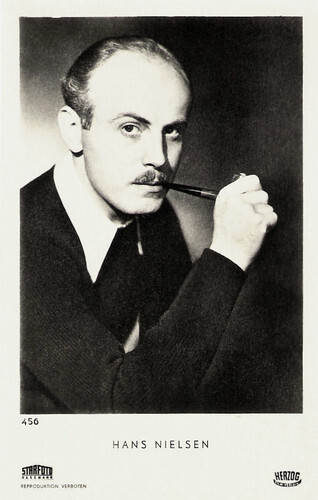
German postcard by Starfoto Hasemann, no. 456. Photo: Herzog.
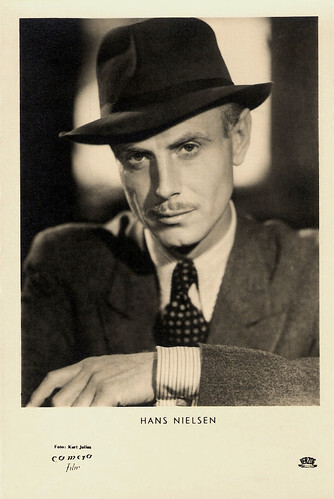
German postcard by Photo-Kitt, München, no. 503. Photo: Camera Film / Kurt Julies / Herzog.
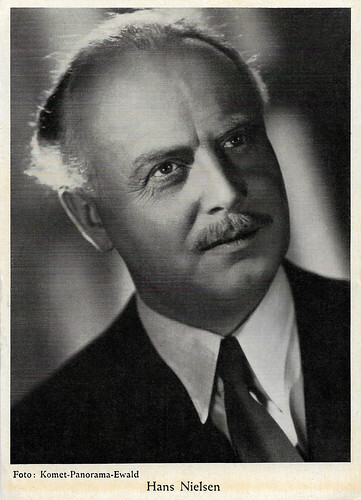
West German card. Photo: Komet / Panorama / Ewald. Hans Nielsen in Die blaue Stunde/The Blue Hour (Veit Harlan, 1953).
Sources: Stephanie D’heil (Steffi-Line - German), Wikipedia, and .

German postcard by Ross Verlag, no. A 2543/1, 1939-1940. Photo: Clausen / Tobis.

German postcard by Ross Verlag, no. A 3360/1, 1941-1944. Photo: Binz / Tobis.

German postcard by F.B.Z. Photo: Camera Film / Kurt Julies (Julius).
Titanic
Hans Albert Nielsen was born in 1911 as the son of a merchant in Hamburg, Germany. After attending secondary school he took an apprenticeship as a merchant. He only completed it for the sake of his parents, because he took acting lessons with Albrecht Schoenhals and Erich Ziegel and also trained in singing. In 1932, Nielsen made his theatre debut at the Hamburger Kammerspiele. Further engagements took him to Augsburg, Kiel and Leipzig in the following months. Many actors and performing artists fled Nazi Germany, but Nielsen remained. In 1938, Nielsen went to Berlin and performed at various theatres.
The talented actor had already attracted the attention of the film industry in the mid-1930s and Nielsen made his screen debut with a small part in the romantic comedy Daphne und der Diplomat/Daphne and the Diplomat (Robert A. Stemmle, 1937) in the same year he appeared as pilot Billy Sefton in the melodrama Tango Notturno (Fritz Kirchhoff, 1937). A year later, he took on the role of Max von Wendlowsky in the Zarah Leander film Heimat (Carl Froelich, 1938), based on the play by Hermann Sudermann.
Productions such as the initially banned historical drama Preußische Liebesgeschichte/A Prussian Love Story (Paul Martin, 1938), the adventure Aufruhr in Damaskus/Uproar in Damascus (Gustacv Ucicky, 1939), and the crime thriller Alarm auf Station III/Alarm at Station III (Philipp Lothar Mayring, 1939) followed until the end of the 1930s. In the 1940s, Nielsen appeared in the euthanasia drama Ich klage an/I Accuse (Wolfgang Liebeneiner,1941) as Dr Höfer, which is still considered a ”reserved film’ today.
In the drama Titanic (Herbert Selpin, 1943) about the sinking of the luxury liner RMS Titanic in 1912, Nielsen played the German first officer Petersen. Titanic was commissioned by Nazi Propaganda Minister Joseph Goebbels with the intent of showing not only the superiority of German filmmaking but also as a propaganda vehicle which would depict British and American capitalism as being responsible for the disaster. The addition of an entirely fictional heroic German officer, Petersen, to the ship's crew, was intended to demonstrate the superior bravery and selflessness of German men as compared to the British officers. The film's original director, Herbert Selpin, was arrested during production after making disparaging comments about the German army and the war in the East. He was found hanged in prison, and the film was completed by Werner Klingler, who was not credited.
Although the film had a brief theatrical run in parts of German-occupied Europe starting in November 1943, it was not shown within Germany by order of Goebbels, who feared that it would weaken the German citizenry's morale instead of improving it, as heavy Allied bombing raids made a film depicting mass panic and death unappealing. Goebbels later banned the film's playing entirely, and it did not have a second run. Until the end of the war, Nielsen appeared in productions including the drama Der große König/The Great King (Veit Harlan, 1942) starring Otto Gebühr . The comedy Dr. Phil. Döderlein (1945) remained unfinished.

Big German card by Ross Verlag. Photo: Froelich-Film / Ufa. Ruth Hellberg and Hans Nielsen in Heimat (Carl Froelich, 1938).

Latvian postcard by E&B, Riga, no. 2570. Photo: A.S. "Ars". Sent by mail in 1938.
Different from you and me
After the end of the Second World War, Hans Nielsen was able to continue his earlier successes on the big screen with mostly high-profile supporting roles, but also leading roles. He appeared, for example, as King Peter Petroni in the comedy of mistaken identity Herzkönig/King of Hearts (Helmut Weiss, 1947) and as Wolfgang Grunelius in the episodic film In jenen Tagen/In Those Days (1947) directed by Helmuth Käutner . It was one of the cycle of Rubble films made in the wake of Germany's defeat during World War II.
In 1949, he shone alongside Luise Ullrich and Dieter Borsche in the drama Nachtwache/Keepers of the Night (Harald Braun, 1949). He impressively portrayed the pastor Johannes Heger, who finds himself in a conflict of conscience. In 1950, he was seen in the role of chief inspector Thomsen in Kurt Hoffmann's crime thriller Fünf unter Verdacht/Five Suspects (1950), based on the novel ‘Thomas verhört die Prima’ by Herbert Moll and Rudolf Becker.
He often played good-natured, likeable and elegant roles, like the presiding judge in the satire Hokuspokus/Hocuspocus (Kurt Hoffmann, 1953). He usually appeared older in his roles than he was, often playing the benevolent head of the family. However, many of the productions in which Nielsen appeared were successful not least because of him.
In the criminal melodrama Teufel in Seide/Devil in Silk (Rolf Hansen, 1955) with Lilli Palmer and Curd Jürgens , he was the committed defence lawyer, as well as in the legal drama Gestehen Sie, Dr. Corda!/Confess, Doctor Corda! (Josef von Báky, 1958) with Hardy Krüger and Kriegsgericht/Court Martial (Kurt Meisel, 1959), based on the story ‘Kreuzer Pommern’ by Willi Berthold with Karlheinz Böhm , Christian Wolff and Klaus Kammer as three shipwrecked German marines. In Wolfgang Liebeneiner 's romanticised historical film Königin Luise/Queen Luise (1957), he lent character to Minister Karl August von Hardenberg alongside Ruth Leuwerik as Queen Luise.
His role as Max Mertens in Anders als du und ich/Different from You and Me (Veit Harlan, 1957) is rather negligible. As Filmdienst.de notes: ‘The film by no means sees homosexuality as a positive alternative to life, and also defames abstract painting and atonal music, which it portrays as the expression of such an ‘attitude to life’.

German postcard by Film-Foto-Verlag, no. A 3601/1. Photo: Tobis / Binz.

German postcard by Film-Foto-Verlag, no. A 3750/1, 1941-1944. Photo: Tobis / Binz.

German postcard by Netter's Starverlag, Berlin, no. F-353. Lisa Lesco and Hans Nielsen in Herzkönig/King of Hearts (Helmut Weiss, 1947).
Scotland Yard vs. Dr Mabuse
Hans Nielsen did not become a real screen star in German post-war films, probably because he was confined to the type of dignified grand seigneur, the ‘actor of sober businessmen and grumpy but spirited clergymen’, as one critic once described him. He founded a cabaret group, ‘Die Außenseiter’ (The Outsider) after the war, and appeared in revues by Günter Neumann.
Engagements took him to the Düsseldorfer Schauspielhaus, the Renaissance-Theater and the Theater am Kurfürstendamm in Berlin, among others. One of his most important theatre roles was that of the Cardinal in the 1963 premiere of Rolf Hochhuth's play ‘Der Stellvertreter’, directed by Erwin Piscator at Berlin's Theater am Kurfürstendamm, with Dieter Borsche as Pope Pius XII.
During the 1960s, he also appeared in films like Sherlock Holmes und das Halsband des Todes/Sherlock Holmes and the Deadly Necklace (Terence Fisher, 1963) with Christopher Lee , Scotland Yard jagt Dr. Mabuse/Scotland Yard Hunts Dr. Mabuse or Scotland Yard vs. Dr Mabuse (Paul May, 1963) starring Peter van Eyck , and Das indische Touch/The Indian Scarf (Alfred Vohrer, 1963). His only Hollywood film was Town Without Pity (Gottfried Reinhardt, 1961) with Kirk Douglas .
In addition to his extensive acting work for theatre and film, Hans Nielsen was also a sought-after dubbing actor. He was the German voice of Errol Flynn , Tyrone Power , Trevor Howard , James Stewart , Fred Astaire and Spencer Tracy . His final film was the Western Die Hölle von Manitoba/The Hell of Manitoba (Sheldon Reynolds, 1965) starring Lex Barker and Pierre Brice .
Hans Nielsen died in 1965 in West Berlin at the age of just 53. He had previously been admitted to hospital with back problems and was diagnosed with leukaemia on examination. The popular actor was laid to rest in the Heerstraße Cemetery in the Berlin district of Westend. The actor had been married to Anna Katharina Elisabeth Novian since 1937. Despite having a daughter together, the marriage failed. After the divorce, Nielsen married his second wife Annemarie Giersch, who brought a son into the marriage. Wife number 3 was Jutta Jusseit. The couple married a few months before his death in 1965. In 2023, film historian Thomas Barthol published a biography of the artist entitled ‘Hans Nielsen: Der charmante Kavalier’. Nielsen never played in the top league of film stars, but ‘knew how to convince with his acting and vocal skills’.

German postcard by Starfoto Hasemann, no. 456. Photo: Herzog.

German postcard by Photo-Kitt, München, no. 503. Photo: Camera Film / Kurt Julies / Herzog.

West German card. Photo: Komet / Panorama / Ewald. Hans Nielsen in Die blaue Stunde/The Blue Hour (Veit Harlan, 1953).
Sources: Stephanie D’heil (Steffi-Line - German), Wikipedia, and .
Published on November 28, 2024 22:00
November 27, 2024
Directed by Lupu Pick
Lupu Pick (1886-1931) was a Romanian-German actor, film director, producer, and screenwriter of the silent era. His style as director differed substantially from the macabre, expressionist fantasies prevalent in German cinema at the time. Together with screenwriter Carl Mayer, he introduced Kammerspielfilme (chamber drama films), intimate psychological dramas about ordinary people in extraordinary circumstances. In the mid-1920s, he briefly returned to acting and then made films in England and France.
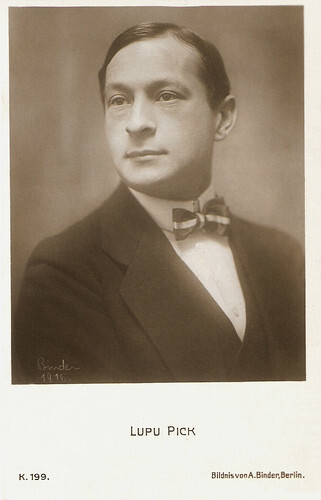
German postcard by Verlag Photochemie, Berlin, no. K. 199. Photo: Alex Binder, 1916.

German postcard by Photochemie, Berlin, K. 2855. Photo: Rex-Film. Bernd Aldor in Die Liebe des van Royk (Lupu Pick, 1917).
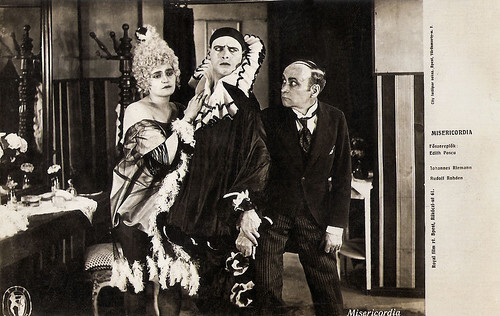
Hungarian postcard by City fotóipar soksz, Budapest. Photo: Rex-Film / Royal Film, Budapest. Johannes Riemann , Edith Posca and Rudolph Klein-Rohden in Tötet nicht mehr/Don't kill any more (Lupu Pick, 1919).
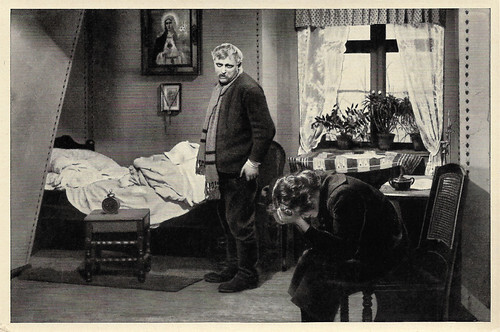
German photocard for the album 'Vom Werden deutscher Filmkunst 'by Ross Verlag. Photo: Ufa. Publicity still with Werner Krauss in the classic German Kammerspiel film Scherben/Shattered (Lupu Pick, 1921). The woman is Edith Posca, who plays the daughter.
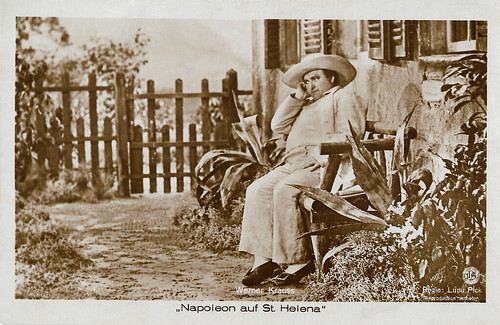
German postcard by Ross Verlag, no. 115/2. Photo: D.L.S. Werner Krauss in Napoleon auf St. Helena/Napoleon at St. Helena (Lupu Pick, 1929). The outfit of Krauss is that of Goethe in the famous painting 'Goethe in the Campagna' (1787) by Tischbein.
Shaky, toothless old men
Lupu Ludwig Pick was born in Iaşi, Romania, in 1886. His father was a Jewish Austrian merchant and his mother was of Romanian origin. From the age of eleven, he grew up in Berlin. Already in elementary school, he was a member of a theatre group and gave violin concerts. He attended the Sophien-Realgymnasium and completed an apprenticeship as a salesman, but at the same time, he took acting lessons as a member of an amateur theatre group.
In 1909, he joined the ensemble of the Schillertheater in Altona. From 1910, he played at the Sommertheater in Flensburg, where he directed for the first time. There he met actress Edith Posca, whom he married in 1914.
Lupu Pick made his film debut in Japanisches Opfer/Japanese Victim (Adolf Gärtner, 1910) with Max Mack. In 1913, Pick came to the Deutsches Theater in Berlin with a performance of ‘Die Schiffbrüchigen’ (Eugène Brieux), where he experienced his breakthrough in the role of the doctor. He stayed in Berlin and worked for six years at the Kleines Theater Unter den Linden as an actor, director and stage manager. His greatest success was the role of Uncle Eli in ‘Jettchen Gebert’.
Pick usually slipped into the roles of shaky, toothless old men, whom he knew how to embody excellently. After WWI, he only sporadically appeared on the stage, and in 1930, he retired from theatre acting. From 1915 on, Pick worked regularly as a screen actor. After his role in Richard Oswald ’s Und wandern sollst Du ruhelos/And You Shall Wander Restlessly (Richard Oswald, 1915), he became a fixture in Oswald’s following films.
He appeared in such classic silent films of the 1910s as Hoffmanns Erzählungen/Tales of Hoffmann (Richard Oswald, 1915), Homunculus (Otto Rippert,1917) starring Olaf Fönss , and Das Bildnis des Dorian Gray/The Picture of Dorian Gray (Richard Oswald, 1917) with Bernd Aldor . He was a regular in films by Conrad Veidt and Reinhold Schünzel and also worked with Gerhard Lamprecht, Henrik Galeen, and Fritz Lang . He appeared in 50 silent films between 1910 and 1928.
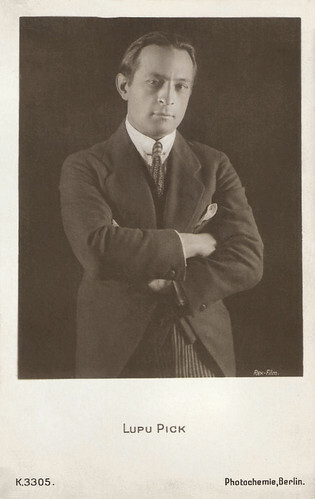
German postcard by Verlag Photochemie, Berlin, no. K. 3305. Photo: Rex-Film.
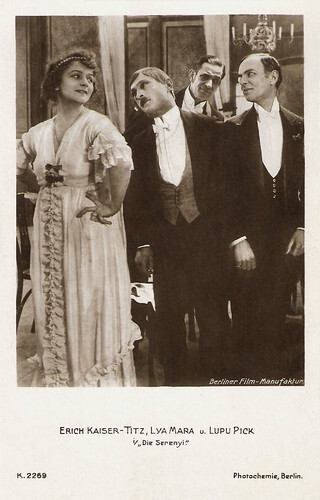
German postcard by Photochemie, Berlin, no. K. 2269. Photo: Berliner Film-Manufaktur. Lya Mara , Erich Kaiser-Titz (background), and Lupu Pick in Die Serenyi/The Serenyi (Alfred Halm, 1918). This is one of two cards Photchemie issued on this film.
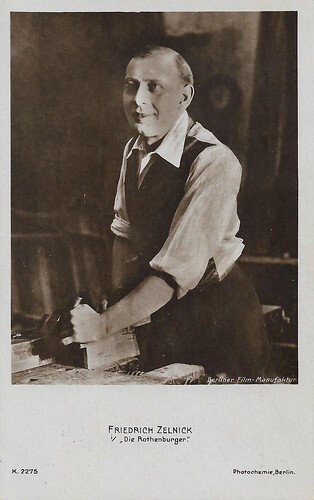
German postcard by Photochemie, Berlin, no. K. 2275. Photo: Berliner Film-Manufaktur. Friedrich Zelnik in Die Rothenburger (Lupu Pick, 1918).
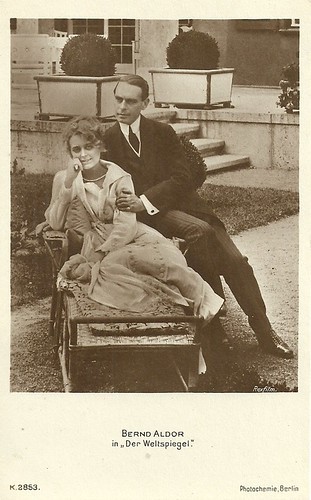
German postcard by Photochemie, Berlin, no. K. 2853. Bernd Aldor in Der Weltspiegel (Lupu Pick, 1918). The woman could be Gertrud Welcker.

German postcard by Photochemie, Berlin, no. K. 2856. Photo: Rex-Film. Bernd Aldor in Die tolle Heirat von Laló/The Great Marriage of Laló (Lupu Pick, 1918).
The unchained camera
In 1918, Lupu Pick and Arthur Spitz founded the production company Rex-Film. Pick also became its managing director. He directed entertainment fare like the crime caper Mr. Wu (Lupu Pick, 1918) with Carl Meinhard and Manja Tzatschewa. Pick was socially committed and in 1919 he pleaded against the death penalty in his film Tötet nicht mehr!/No More Killing (Lupu Pick, 1919).
In 1920, Pick collaborated for the first time with author Carl Mayer on Der Dummkopf/The Fool (Lupu Pick, 1921) starring Max Adalbert. Their second feature film was Scherben/Shattered (Lupu Pick, 1921) with Werner Krauss which is today considered the archetypical 'Kammerspielfilm' (Chamber drama film), an intimate drama that offers an intimate, cinematic portrait of lower-middle-class life.
Pick directed his film Aus den Erinnerungen eines Frauenarztes/Flying Shadows (Gerhard Lamprecht, Lupu Pick, 1922) against 'Paragraph 218'. In Germany, abortion is punishable by Section 218 of the German Criminal Code. Pick’s gothic tale Grausige Nächte/Nights of Terror (Lupu Pick, 1921) with Edith Posca, was followed by the acclaimed Kammerspielfilm Sylvester/New Year's Eve (Lupu Pick, 1924), his last film based on a screenplay by Mayer. Both Scherben and Sylvester were innovative in their extensive use of ‘Entfesselte Kamera’ (the unchained camera), using tracking and gliding techniques as opposed to keeping the camera stationary. Both films also didn’t use intertitles.
As an actor, Lupu Pick made another impressive appearance as a cab driver in Die letzte Droschke von Berlin/The Last Horse Carriage in Berlin (Carl Boese, 1926), produced by his company Rex-Film, and as the Japanese diplomat Matsumoto in Spione/Spies (Fritz Lang, 1928). Pick continued to direct films for Rex-Film, including Das Haus der Lüge/The House of Lies (Lupu Pick, 1925), Das Panzergewölbe/Wolves of the Underworld (Lupu Pick, 1926) starring Ernst Reicher and A Knight in London/Eine Nacht in London (Lupu Pick, 1928) with Lilian Harvey . Pick was also heavily involved in film politics. He served on the board of the Film Association of Industrialists (Vorstand des Verbandes der Filmindustriellen), SPIO and the Film Directors Association of Germany (Verbandes der Filmregisseure Deutschlands) and worked intensively to establish the union-based umbrella organization of Filmmakers in Germany (Filmschaffenden Deutschlands - Dacho). He was the organisation's first chairman.
His last silent film was the psychological historical film Napoleon auf St. Helena/Napoleon on St Helena (Lupu Pick, 1929) starring Werner Krauss and made in France. The film was based on an expose by Abel Gance . Pick made only one sound film, Gassenhauer/The Street Song (Lupu Pick, 1931) with Ernst Busch. The film was a considerable public success and one of its songs, 'Marie, Marie', by the Comedian Harmonists, became a hit record. Lupu Pick died unexpectedly in 1931 from a stomach ailment in Berlin. He was 45. His wife Edith Posca took her own life just four months after his death.
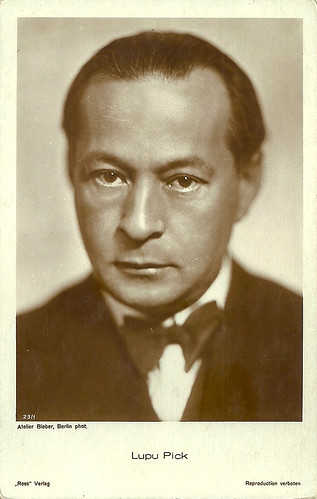
German postcard by Ross Verlag, no. 23/1. Photo: Atelier Bieber, Berlin.
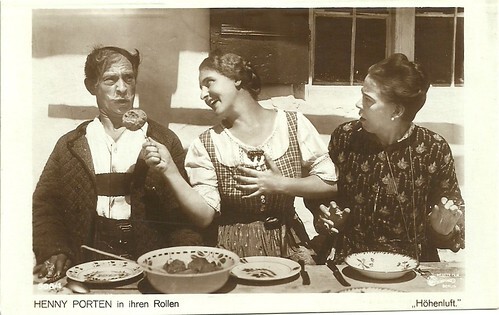
German postcard in the Film-Sterne series by Rotophot, no. 508/1. Photo: Messter-Film. Lupu Pick, Henny Porten , and Emmy Wyda in the comedy Höhenluft/Mountain Air (Rudolf Biebrach, 1917).
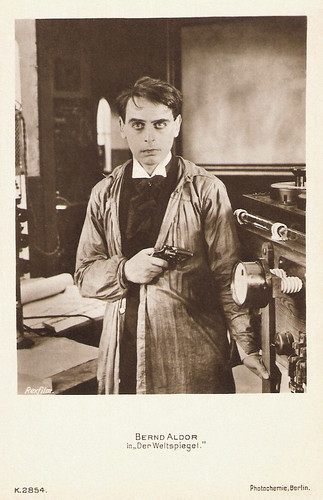
German postcard by Photochemie, Berlin, no. K. 2854. Photo: Rexfilm. Bernd Aldor in Der Weltspiegel (Lupu Pick, 1918).
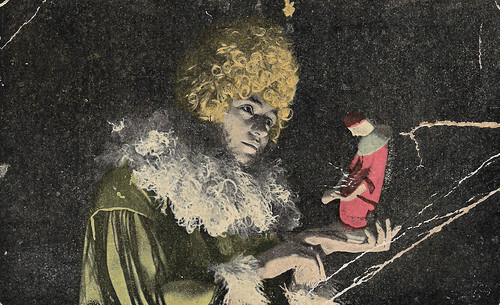
Spanish collector card by Chocolat Imperiale, Barcelona, Card 3 of 6. Photo: Rex-Film / Distr. J. Verdaguer S.A., Barcelona. Edith Posca in Tötet nicht mehr!/Misericordia (Lupu Pick, 1919).
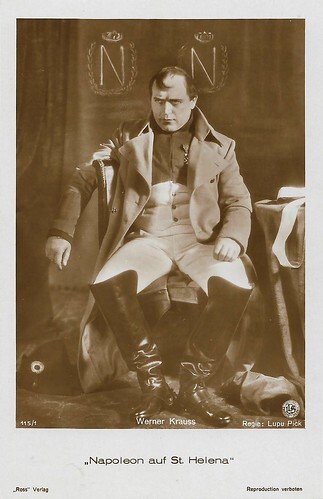
German postcard by Ross Verlag, no. 115/1. Photo: D.L.S. (Deutsche Licht-Spiele). Werner Krauss in Napoleon auf St. Helena/Napoleon at St. Helena (Lupu Pick, 1929).
Sources: Filmportal.de, Wikipedia (German and English), and .

German postcard by Verlag Photochemie, Berlin, no. K. 199. Photo: Alex Binder, 1916.

German postcard by Photochemie, Berlin, K. 2855. Photo: Rex-Film. Bernd Aldor in Die Liebe des van Royk (Lupu Pick, 1917).

Hungarian postcard by City fotóipar soksz, Budapest. Photo: Rex-Film / Royal Film, Budapest. Johannes Riemann , Edith Posca and Rudolph Klein-Rohden in Tötet nicht mehr/Don't kill any more (Lupu Pick, 1919).

German photocard for the album 'Vom Werden deutscher Filmkunst 'by Ross Verlag. Photo: Ufa. Publicity still with Werner Krauss in the classic German Kammerspiel film Scherben/Shattered (Lupu Pick, 1921). The woman is Edith Posca, who plays the daughter.

German postcard by Ross Verlag, no. 115/2. Photo: D.L.S. Werner Krauss in Napoleon auf St. Helena/Napoleon at St. Helena (Lupu Pick, 1929). The outfit of Krauss is that of Goethe in the famous painting 'Goethe in the Campagna' (1787) by Tischbein.
Shaky, toothless old men
Lupu Ludwig Pick was born in Iaşi, Romania, in 1886. His father was a Jewish Austrian merchant and his mother was of Romanian origin. From the age of eleven, he grew up in Berlin. Already in elementary school, he was a member of a theatre group and gave violin concerts. He attended the Sophien-Realgymnasium and completed an apprenticeship as a salesman, but at the same time, he took acting lessons as a member of an amateur theatre group.
In 1909, he joined the ensemble of the Schillertheater in Altona. From 1910, he played at the Sommertheater in Flensburg, where he directed for the first time. There he met actress Edith Posca, whom he married in 1914.
Lupu Pick made his film debut in Japanisches Opfer/Japanese Victim (Adolf Gärtner, 1910) with Max Mack. In 1913, Pick came to the Deutsches Theater in Berlin with a performance of ‘Die Schiffbrüchigen’ (Eugène Brieux), where he experienced his breakthrough in the role of the doctor. He stayed in Berlin and worked for six years at the Kleines Theater Unter den Linden as an actor, director and stage manager. His greatest success was the role of Uncle Eli in ‘Jettchen Gebert’.
Pick usually slipped into the roles of shaky, toothless old men, whom he knew how to embody excellently. After WWI, he only sporadically appeared on the stage, and in 1930, he retired from theatre acting. From 1915 on, Pick worked regularly as a screen actor. After his role in Richard Oswald ’s Und wandern sollst Du ruhelos/And You Shall Wander Restlessly (Richard Oswald, 1915), he became a fixture in Oswald’s following films.
He appeared in such classic silent films of the 1910s as Hoffmanns Erzählungen/Tales of Hoffmann (Richard Oswald, 1915), Homunculus (Otto Rippert,1917) starring Olaf Fönss , and Das Bildnis des Dorian Gray/The Picture of Dorian Gray (Richard Oswald, 1917) with Bernd Aldor . He was a regular in films by Conrad Veidt and Reinhold Schünzel and also worked with Gerhard Lamprecht, Henrik Galeen, and Fritz Lang . He appeared in 50 silent films between 1910 and 1928.

German postcard by Verlag Photochemie, Berlin, no. K. 3305. Photo: Rex-Film.

German postcard by Photochemie, Berlin, no. K. 2269. Photo: Berliner Film-Manufaktur. Lya Mara , Erich Kaiser-Titz (background), and Lupu Pick in Die Serenyi/The Serenyi (Alfred Halm, 1918). This is one of two cards Photchemie issued on this film.

German postcard by Photochemie, Berlin, no. K. 2275. Photo: Berliner Film-Manufaktur. Friedrich Zelnik in Die Rothenburger (Lupu Pick, 1918).

German postcard by Photochemie, Berlin, no. K. 2853. Bernd Aldor in Der Weltspiegel (Lupu Pick, 1918). The woman could be Gertrud Welcker.

German postcard by Photochemie, Berlin, no. K. 2856. Photo: Rex-Film. Bernd Aldor in Die tolle Heirat von Laló/The Great Marriage of Laló (Lupu Pick, 1918).
The unchained camera
In 1918, Lupu Pick and Arthur Spitz founded the production company Rex-Film. Pick also became its managing director. He directed entertainment fare like the crime caper Mr. Wu (Lupu Pick, 1918) with Carl Meinhard and Manja Tzatschewa. Pick was socially committed and in 1919 he pleaded against the death penalty in his film Tötet nicht mehr!/No More Killing (Lupu Pick, 1919).
In 1920, Pick collaborated for the first time with author Carl Mayer on Der Dummkopf/The Fool (Lupu Pick, 1921) starring Max Adalbert. Their second feature film was Scherben/Shattered (Lupu Pick, 1921) with Werner Krauss which is today considered the archetypical 'Kammerspielfilm' (Chamber drama film), an intimate drama that offers an intimate, cinematic portrait of lower-middle-class life.
Pick directed his film Aus den Erinnerungen eines Frauenarztes/Flying Shadows (Gerhard Lamprecht, Lupu Pick, 1922) against 'Paragraph 218'. In Germany, abortion is punishable by Section 218 of the German Criminal Code. Pick’s gothic tale Grausige Nächte/Nights of Terror (Lupu Pick, 1921) with Edith Posca, was followed by the acclaimed Kammerspielfilm Sylvester/New Year's Eve (Lupu Pick, 1924), his last film based on a screenplay by Mayer. Both Scherben and Sylvester were innovative in their extensive use of ‘Entfesselte Kamera’ (the unchained camera), using tracking and gliding techniques as opposed to keeping the camera stationary. Both films also didn’t use intertitles.
As an actor, Lupu Pick made another impressive appearance as a cab driver in Die letzte Droschke von Berlin/The Last Horse Carriage in Berlin (Carl Boese, 1926), produced by his company Rex-Film, and as the Japanese diplomat Matsumoto in Spione/Spies (Fritz Lang, 1928). Pick continued to direct films for Rex-Film, including Das Haus der Lüge/The House of Lies (Lupu Pick, 1925), Das Panzergewölbe/Wolves of the Underworld (Lupu Pick, 1926) starring Ernst Reicher and A Knight in London/Eine Nacht in London (Lupu Pick, 1928) with Lilian Harvey . Pick was also heavily involved in film politics. He served on the board of the Film Association of Industrialists (Vorstand des Verbandes der Filmindustriellen), SPIO and the Film Directors Association of Germany (Verbandes der Filmregisseure Deutschlands) and worked intensively to establish the union-based umbrella organization of Filmmakers in Germany (Filmschaffenden Deutschlands - Dacho). He was the organisation's first chairman.
His last silent film was the psychological historical film Napoleon auf St. Helena/Napoleon on St Helena (Lupu Pick, 1929) starring Werner Krauss and made in France. The film was based on an expose by Abel Gance . Pick made only one sound film, Gassenhauer/The Street Song (Lupu Pick, 1931) with Ernst Busch. The film was a considerable public success and one of its songs, 'Marie, Marie', by the Comedian Harmonists, became a hit record. Lupu Pick died unexpectedly in 1931 from a stomach ailment in Berlin. He was 45. His wife Edith Posca took her own life just four months after his death.

German postcard by Ross Verlag, no. 23/1. Photo: Atelier Bieber, Berlin.

German postcard in the Film-Sterne series by Rotophot, no. 508/1. Photo: Messter-Film. Lupu Pick, Henny Porten , and Emmy Wyda in the comedy Höhenluft/Mountain Air (Rudolf Biebrach, 1917).

German postcard by Photochemie, Berlin, no. K. 2854. Photo: Rexfilm. Bernd Aldor in Der Weltspiegel (Lupu Pick, 1918).

Spanish collector card by Chocolat Imperiale, Barcelona, Card 3 of 6. Photo: Rex-Film / Distr. J. Verdaguer S.A., Barcelona. Edith Posca in Tötet nicht mehr!/Misericordia (Lupu Pick, 1919).

German postcard by Ross Verlag, no. 115/1. Photo: D.L.S. (Deutsche Licht-Spiele). Werner Krauss in Napoleon auf St. Helena/Napoleon at St. Helena (Lupu Pick, 1929).
Sources: Filmportal.de, Wikipedia (German and English), and .
Published on November 27, 2024 22:00
November 26, 2024
Ross Verlag, Part 12: Edition Ross
Last week EFSP did a post on the the Foreign Series by Ross Verlag with tinted postcards aimed at the British market. In total, Ross produced three postcard series presumably for distribution solely in their respective countries. For Hungary, Ross Verlag produced the B series and for France the F series. For the French market, the name Edition Ross was used instead of Ross Verlag. Apart from the F series, Ross produced several other series for France. Here are 15 Edition Ross postcards from our collections.
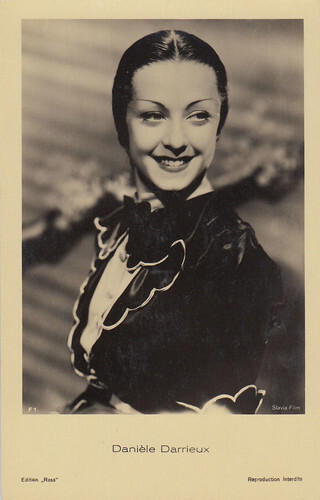
French postcard by Edition Ross, no. F1. Photo: Slavia Film. Danielle Darrieux , as the Japanese character Youki, in the French-language version of Port Arthur (Nicolas Farkas, 1936). Collection: Marlene Pilaete.
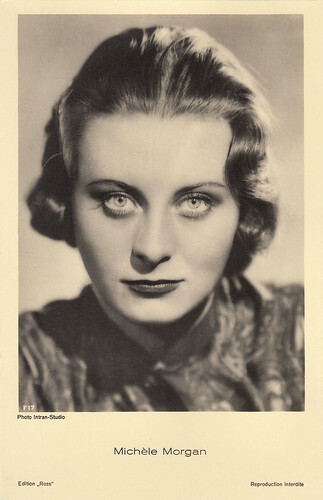
French postcard by Edition Ross, no. F17. Photo: Intran-Studio. Collection: Marlène Pilaete. Michèle Morgan .
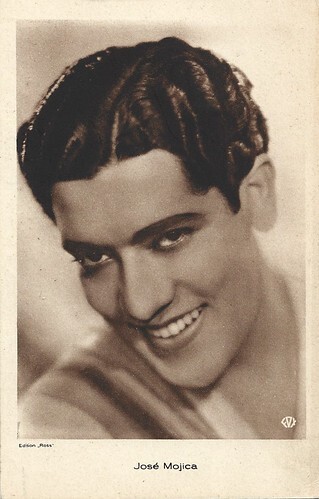
A curiosity. This unnumbered Edition Ross postcard contains a Portuguese text (translated): "From 16 May, the most sympathetic film actor-singer José Mojica , who at the Trindade presents his excellent films of Fox, will perform and sing in Spanish in 'O bandido mascarado." Cinema Trindade was and is a cinema in Porto, Portugal. The Masked Bandit may refer to Mojica's Dick Turpin film El caballero de la noche (James Tinling, 1932). Photo: Fox.
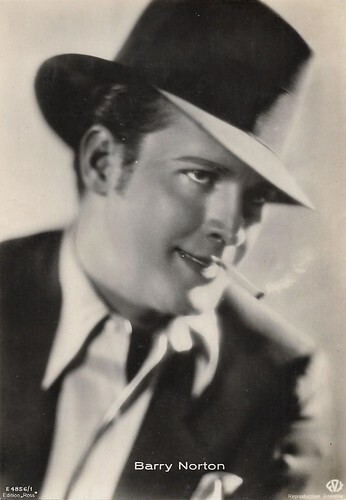
French postcard by Edition Ross, no. E 4856-1. Photo: Fox. Barry Norton .

French postcard by Edition Ross in the Luxus series, no. 500. Photo: Clarence Sinclair Bull. Greta Garbo in the German version of Anna Christie (Jacques Feyder, 1930).
Luxus, E and F series
Hans Schnepper writes on the Ross Postcards website that it is impossible to establish when Edition Ross cards were first published. The postcards were made for the French market as the use of 'Edition Ross' and 'reproduction interdite' indicates.
The Edition Ross cards used portraits already published in the German Ross Verlag series, using numbers roughly between 4000 to 8500. That the Edition Ross cards were considered equal to the Ross Luxus cards is evident from the use of the golden Luxus sticker on the backs of the cards, many of which have survived. The size was also in 'Weltformat' (world size), 10,5 x 14,8 cm, and the postcards were printed in high-gloss black (Schwarz-Hochglanz).
The lowest Edition Ross number which Schnepper recorded is Rudolph Valentino , no. 4083/1. Ross Verlag usually didn’t publish postcards of deceased actors, and card 4083/1 in the regular series was published in 1929 by which time Valentino had been dead for about three years. This issue may have been connected with a re-release of one of Valentino’s films, as several European countries re-released various Valentino films in the late 1920s. He writes that the Edition Ross cards were first published somewhere around 1930. The series probably started around the publication of the first German Luxus cards. Our oldest card, no. 4340/1 contains, a still of Clara Bow and Richard Arlen in Ladies of the Mob (William A. Wellman, 1928). According to IMDb, this film premiered in Western Europe in 1929.
Most Edition Ross cards used numbers and portraits from the main Ross Verlag series, but Schnepper also found Edition Ross postcards with E-numbers and with special numbering without a letter. 'Luxus' class postcards from the original Luxus series were, as written, also published as Edition Ross, but most of the Edition Ross cards were printed in black chamois (chambray) instead of the high-gloss black of the German Luxus cards. He also found a few postcards in black chamois and cards on cardboard, in a light sepia tint.
The highest Edition Ross numbers that Hans Schnepper recorded are Lilian Harvey , no. 8431/1 and -/2, both using portraits from I Am Suzanne!, which was released in the US in December 1933. so the Edition Ross series appears to have run simultaneously with the Luxus series. 1933 was also the last year Luxus cards were published. The last Luxus card was no. 803 Lilian Harvey . Schnepper, however, does not mention the F series which must have been produced later in the decade, as card no. F1 contains a photo of Danielle Darrieux , as the Japanese character Youki, in the French-language version of Port Arthur (Nicolas Farkas, 1936).
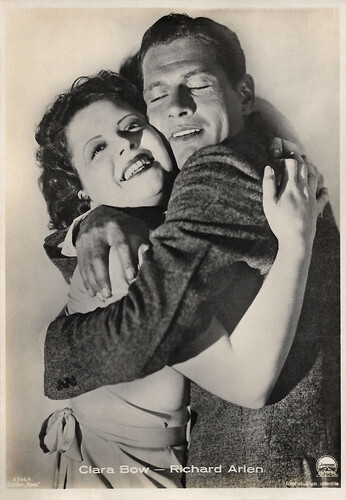
French postcard by Edition Ross, no. 4340/1. Photo: Paramount. Clara Bow and Richard Arlen in Ladies of the Mob (William A. Wellman, 1928).
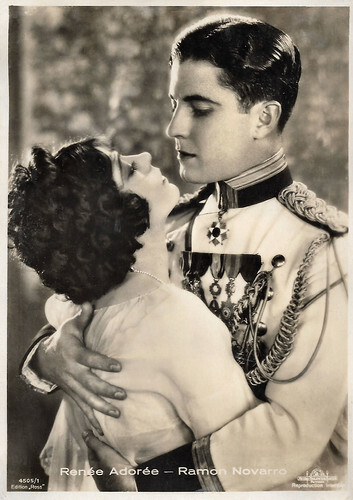
French postcard by Edition Ross, no. 4505/1. Photo: Metro-Goldwyn-Mayer. Renée Adorée and Ramon Novarro in Forbidden Hours (Harry Beaumont, 1928).
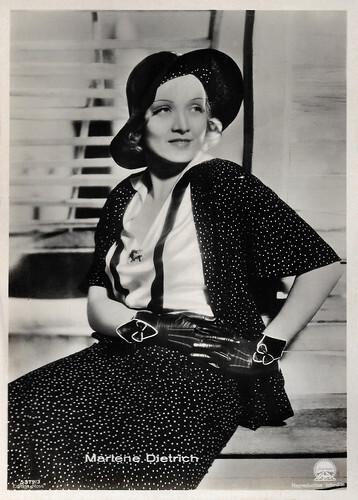
French postcard by Edition Ross, no. 5379/3. Photo: Paramount. Marlene Dietrich .
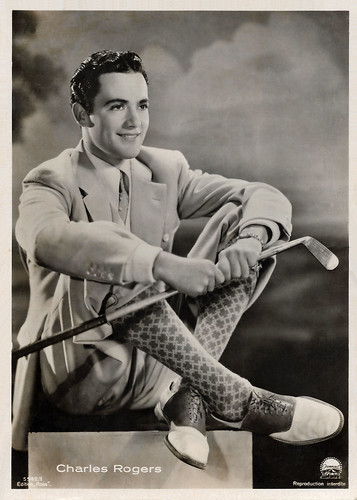
French postcard by Edition Ross, no. 5542/1. Photo: Paramount. Charles Rogers in Follow Thru (Lloyd Corrigan, Laurence Schwab, 1930).
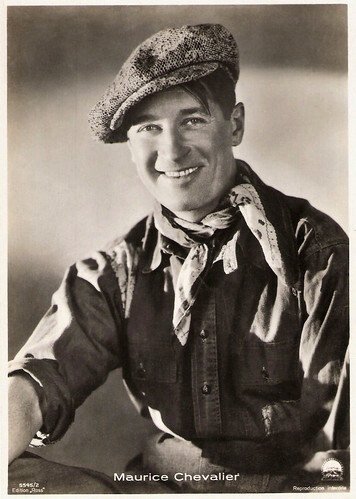
French postcard by Edition Ross, no. 5545/2. Photo: Paramount. Maurice Chevalier .
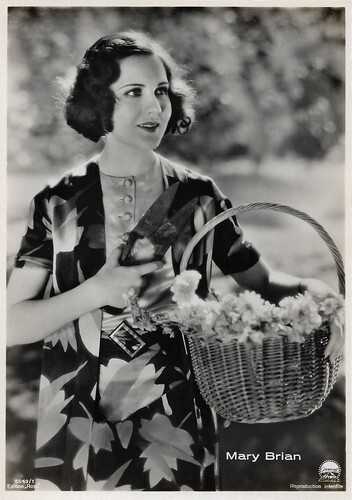
French postcard by Edition Ross, no. 5549/1. Photo: Paramount. Mary Brian .
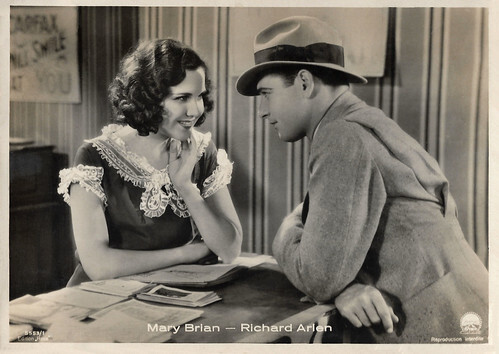
French postcard by Edition Ross, no. 5553/1. Photo: Paramount. Mary Brian and Richard Arlen in the car-racing drama Burning Up (A. Edward Sutherland, 1930).
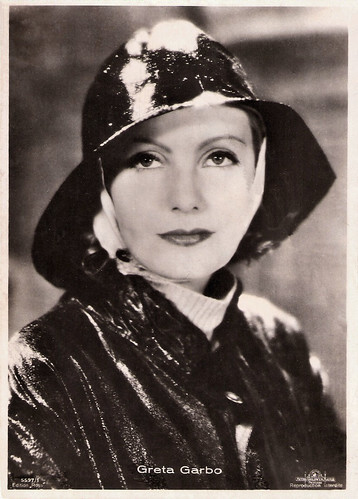
French postcard by Edition Ross, no. 5597/1. Photo: Metro-Goldwyn-Mayer / Clarence Sinclair Bull. Greta Garbo in Anna Christie (Jacques Feyder, 1930).
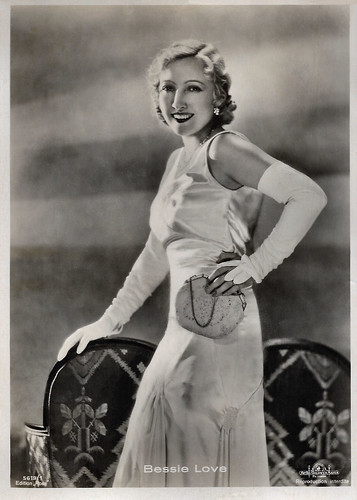
French postcard by Edition Ross, no. 5619/1. Photo: Metro-Goldwyn-Mayer. Bessie Love .
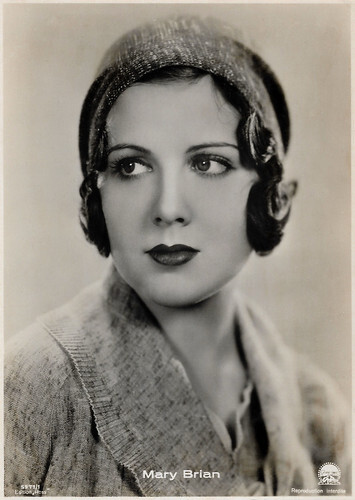
French postcard by Edition Ross, no. 5971/1. Photo: Paramount. Mary Brian .
Source: Hans Schnepper (Ross Postcards), Ross Postcards and IMDb.
With thanks to Jean Ritsema and Ivo Blom! Our Ross Verlag Tribute will be continued next week and please, remember to check out the Ross Verlag Movie Stars Postcards website.

French postcard by Edition Ross, no. F1. Photo: Slavia Film. Danielle Darrieux , as the Japanese character Youki, in the French-language version of Port Arthur (Nicolas Farkas, 1936). Collection: Marlene Pilaete.

French postcard by Edition Ross, no. F17. Photo: Intran-Studio. Collection: Marlène Pilaete. Michèle Morgan .

A curiosity. This unnumbered Edition Ross postcard contains a Portuguese text (translated): "From 16 May, the most sympathetic film actor-singer José Mojica , who at the Trindade presents his excellent films of Fox, will perform and sing in Spanish in 'O bandido mascarado." Cinema Trindade was and is a cinema in Porto, Portugal. The Masked Bandit may refer to Mojica's Dick Turpin film El caballero de la noche (James Tinling, 1932). Photo: Fox.

French postcard by Edition Ross, no. E 4856-1. Photo: Fox. Barry Norton .

French postcard by Edition Ross in the Luxus series, no. 500. Photo: Clarence Sinclair Bull. Greta Garbo in the German version of Anna Christie (Jacques Feyder, 1930).
Luxus, E and F series
Hans Schnepper writes on the Ross Postcards website that it is impossible to establish when Edition Ross cards were first published. The postcards were made for the French market as the use of 'Edition Ross' and 'reproduction interdite' indicates.
The Edition Ross cards used portraits already published in the German Ross Verlag series, using numbers roughly between 4000 to 8500. That the Edition Ross cards were considered equal to the Ross Luxus cards is evident from the use of the golden Luxus sticker on the backs of the cards, many of which have survived. The size was also in 'Weltformat' (world size), 10,5 x 14,8 cm, and the postcards were printed in high-gloss black (Schwarz-Hochglanz).
The lowest Edition Ross number which Schnepper recorded is Rudolph Valentino , no. 4083/1. Ross Verlag usually didn’t publish postcards of deceased actors, and card 4083/1 in the regular series was published in 1929 by which time Valentino had been dead for about three years. This issue may have been connected with a re-release of one of Valentino’s films, as several European countries re-released various Valentino films in the late 1920s. He writes that the Edition Ross cards were first published somewhere around 1930. The series probably started around the publication of the first German Luxus cards. Our oldest card, no. 4340/1 contains, a still of Clara Bow and Richard Arlen in Ladies of the Mob (William A. Wellman, 1928). According to IMDb, this film premiered in Western Europe in 1929.
Most Edition Ross cards used numbers and portraits from the main Ross Verlag series, but Schnepper also found Edition Ross postcards with E-numbers and with special numbering without a letter. 'Luxus' class postcards from the original Luxus series were, as written, also published as Edition Ross, but most of the Edition Ross cards were printed in black chamois (chambray) instead of the high-gloss black of the German Luxus cards. He also found a few postcards in black chamois and cards on cardboard, in a light sepia tint.
The highest Edition Ross numbers that Hans Schnepper recorded are Lilian Harvey , no. 8431/1 and -/2, both using portraits from I Am Suzanne!, which was released in the US in December 1933. so the Edition Ross series appears to have run simultaneously with the Luxus series. 1933 was also the last year Luxus cards were published. The last Luxus card was no. 803 Lilian Harvey . Schnepper, however, does not mention the F series which must have been produced later in the decade, as card no. F1 contains a photo of Danielle Darrieux , as the Japanese character Youki, in the French-language version of Port Arthur (Nicolas Farkas, 1936).

French postcard by Edition Ross, no. 4340/1. Photo: Paramount. Clara Bow and Richard Arlen in Ladies of the Mob (William A. Wellman, 1928).

French postcard by Edition Ross, no. 4505/1. Photo: Metro-Goldwyn-Mayer. Renée Adorée and Ramon Novarro in Forbidden Hours (Harry Beaumont, 1928).

French postcard by Edition Ross, no. 5379/3. Photo: Paramount. Marlene Dietrich .

French postcard by Edition Ross, no. 5542/1. Photo: Paramount. Charles Rogers in Follow Thru (Lloyd Corrigan, Laurence Schwab, 1930).

French postcard by Edition Ross, no. 5545/2. Photo: Paramount. Maurice Chevalier .

French postcard by Edition Ross, no. 5549/1. Photo: Paramount. Mary Brian .

French postcard by Edition Ross, no. 5553/1. Photo: Paramount. Mary Brian and Richard Arlen in the car-racing drama Burning Up (A. Edward Sutherland, 1930).

French postcard by Edition Ross, no. 5597/1. Photo: Metro-Goldwyn-Mayer / Clarence Sinclair Bull. Greta Garbo in Anna Christie (Jacques Feyder, 1930).

French postcard by Edition Ross, no. 5619/1. Photo: Metro-Goldwyn-Mayer. Bessie Love .

French postcard by Edition Ross, no. 5971/1. Photo: Paramount. Mary Brian .
Source: Hans Schnepper (Ross Postcards), Ross Postcards and IMDb.
With thanks to Jean Ritsema and Ivo Blom! Our Ross Verlag Tribute will be continued next week and please, remember to check out the Ross Verlag Movie Stars Postcards website.
Published on November 26, 2024 22:00
November 25, 2024
La Collectionneuse: Gertrude Olmsted
Gertrude Olmsted never quite reached the first rank of Hollywood silent film stars. Nevertheless, she was in high demand in the 1920s and was featured in about sixty films. After ten years of intense activity, she decided it was time to retire and enjoy a happy married life.
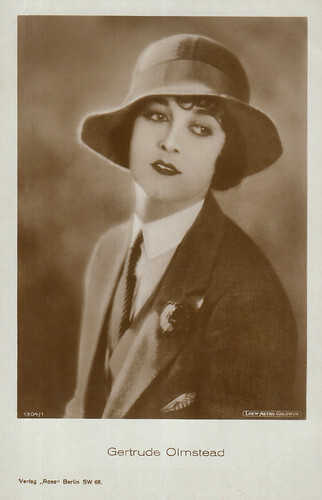
German postcard by Ross Verlag, no. 1304/1, 1927-1928. Photo: Loew Metro Goldwyn.
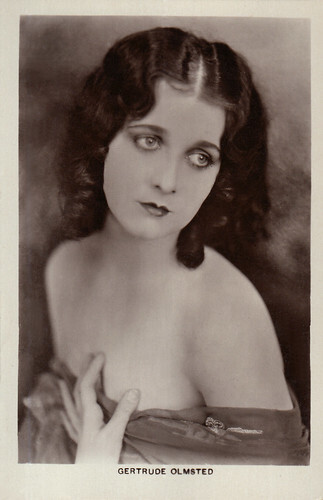
British postcard in the Picturegoer Series, London, no. 265.
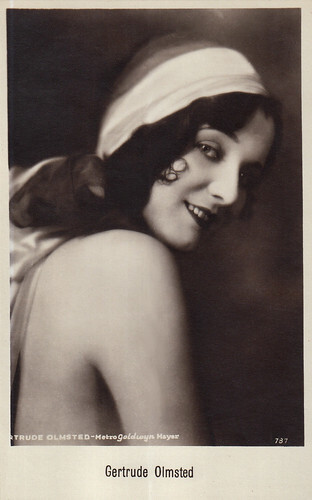
Italian postcard by G.B. Falci, Editore, Milano, no. 787.
Beauty contest winner
Gertrude Olmsted (The spelling 'Olmstead' has also been used) was born on the 13th of November 1904 in Chicago, U.S.A. Some sources give the year as 1897 but the 1920 U.S. Census lists her as a 16-year-old girl and articles published in 1920 refer to her as a teenager.
Her parents were Adelbert Thomas Olmsted and Minnie Sellers.
In 1920, she won a beauty contest and was chosen to represent the 'Spirit of America' in the parade at the Elk’s National Convention in July in Chicago. As a result, she was signed by Universal.
In the first years of her film career, she was often used as a leading lady to Western stars such as Hoot Gibson in Tipped Off (1920), Kickaroo (1921), The Fightin’ Fury (1921), The Cactus Kid (1921) and The Loaded Door (1922), Harry Carey in The Fox (1921) or Roy Stewart in The Guilty Hand (1923), Hard to Beat (1923), The Fight for a Mine (1923) and Better Than Gold (1923).
After she had left Universal, she got a big break when she was cast as John Gilbert ’s love interest in John Ford’s Cameo Kirby (1923).
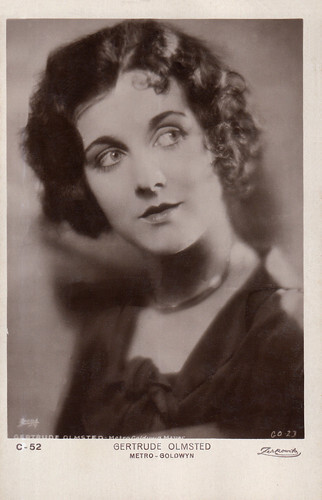
Spanish postcard by Ediciones Adolfo Zerkowitz, no. C-52.
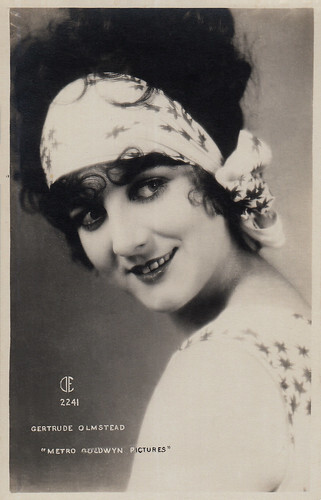
Mexican postcard by CIF, no. 2241.
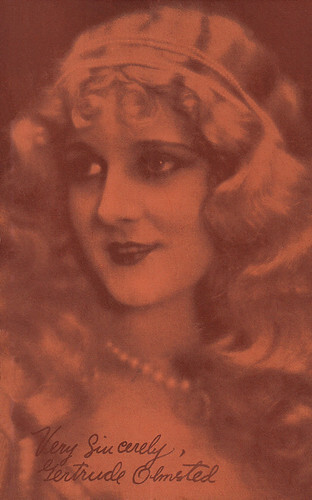
American postcard by Exhibit Supply Co., Chicago. There are several Ben Hur publicity portraits of May McAvoy wearing a similar wig as Gertrude Olmsted on this postcard and a similar headband was issued by M.G.M. at the time (see for example McAvoy’s Wikipedia page). May McAvoy later stated that the blonde wigs which had been originally created for Gertrude Olmsted for the role of Esther were too big for her, as the two actresses didn’t have the same size, and had to be remade when she was finally chosen to play in Ben Hur . So, it’s possible that the photo used on this Exhibit Supply postcard was a publicity shot of Gertrude taken at the time she was expected to appear in Ben Hur .
Ben Hur
In the early stages of the production of Ben Hur , George Walsh and Gertrude Olmsted were slated to play the leads but were soon replaced by Ramon Novarro and May MacAvoy .
According to film historian Anthony Slide, she later would philosophically state: "I was out. It was as simple as that. There was nothing to be said."
Would the role of Esther, Ben Hur’s beloved, have changed the course of her career? We will never know.
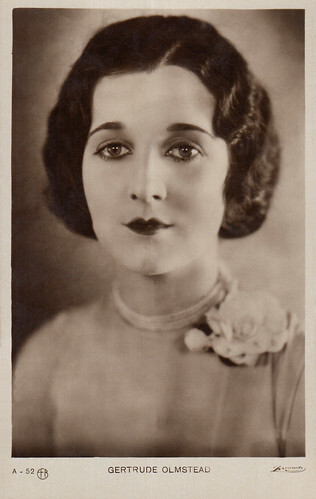
Spanish postcard by Editorial Fotografica Barcelona, no. A-52.
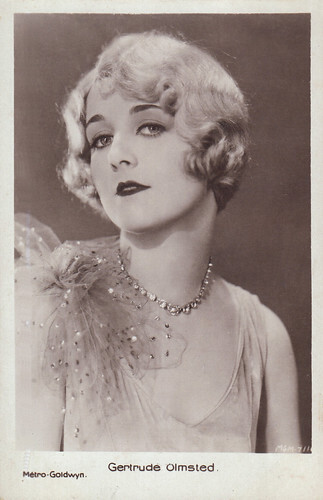
French postcard. Photo: Metro Goldwyn.
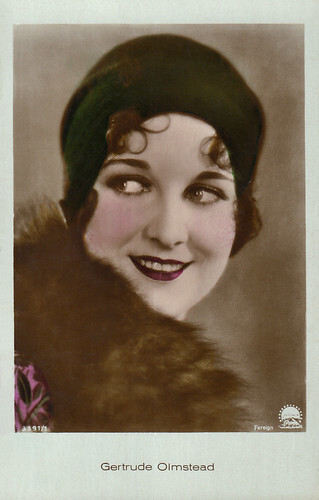
German postcard by Ross Foreign, no. 3391/1, produced for the British market. Photo: Paramount.
A very busy actress
However, after having lost the opportunity to appear in M.G.M.’s famous biblical epic, Gertrude Olmsted certainly didn’t stay idle and her filming schedule was fully booked.
She played for example opposite Rudolph Valentino in Cobra (1925) and Lon Chaney in The Monster (1925) and Mr. Wu (1927).
Her other films include Time, The Comedian (1925), Monte Carlo (1926), The Boob (1926), Puppets (1926), Sweet Adeline (1926), The Cheerful Fraud (1926), Buttons (1927), etc.
At the end of the 1920s, she mostly worked for minor Hollywood studios such as Gotham in The Cheer Leader (1928) and Midnight Life (1928), Tiffany-Stahl in A Woman Against the World (1928) and Green Grass Widows (1928), F.B.O. in Hit of the Show (1928) and Hey Rube! (1928), Trem Carr Pictures in Sweet Sixteen (1928) and Excellent Pictures in Passion Song (1928).
Her first talkie was Columbia’s The Lone Wolf’s Daughter (1929), as a reformed cracksman‘s adopted daughter. It was followed by Sonny Boy (1929), with child star Davey Lee , and The Time, The Place and the Girl (1929), supporting Betty Compson and Grant Withers. Her movie career ended with a musical number in Warner’s Show of Shows (1929).
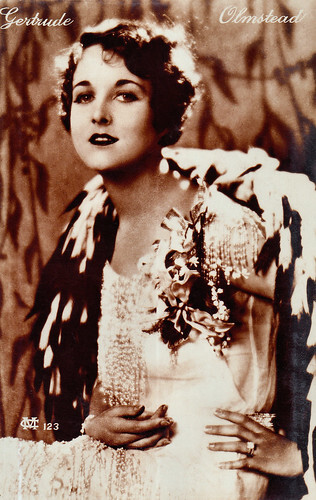
Spanish postcard by M.C. Barcelona, no. 123.
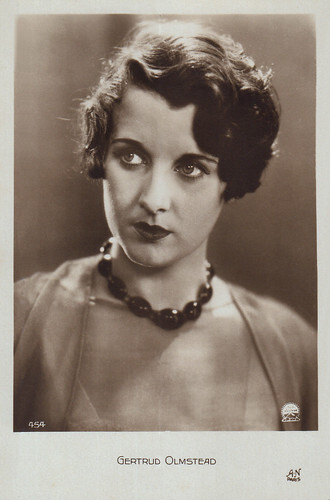
French postcard by A.N., Paris, no. 454. Photo: Paramount.
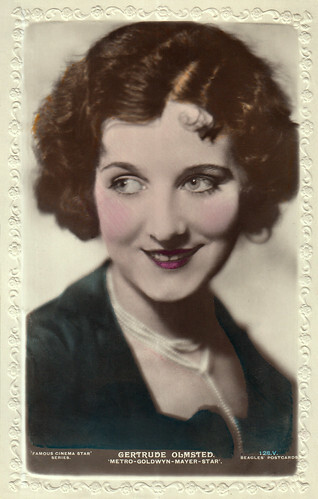
British postcard in the Famous Cinema Stars Series by Beagles, no. 128-V. Photo: Metro-Goldwyn-Mayer.
Farewell to the cinema
Gertrude Olmsted then decided to retire.
For about ten years, she had been a prolific, competent, versatile and reliable actress, who never took herself seriously and had accepted whatever roles assigned to her.
Since 1926, she had been director Robert Z. Leonard’s wife.
Previously, he had been temperamental Mae Murray ’s husband from 1918 to 1925 and must have found life with easy-going Gertrude a welcome change from his former marriage.
It was a happy union which lasted until his death in 1968. Gertrude Olmsted passed away on the 18th of January 1975.
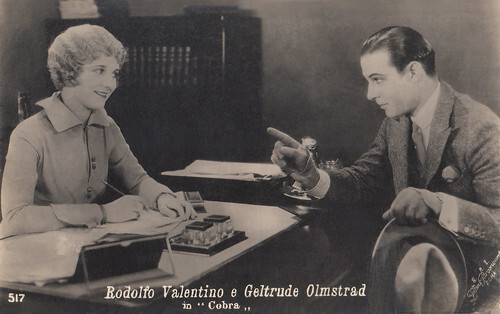
Italian postcard by Ballerini & Fratini, Firenze, no. 517. Photo: Films Paramount, Roma. Gertrude Olmsted and Rudolph Valentino in Cobra (Joseph Henabery, 1925).
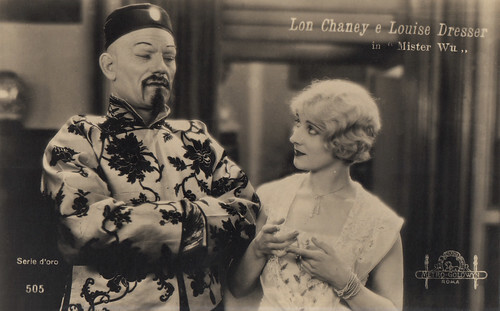
Italian postcard in the “Serie d’Oro” by Ballerini & Fratini, Firenze, no. 505. Photo: Metro-Goldwyn, Roma. Gertrude Olmsted (wrongly captioned as Louise Dresser) and Lon Chaney in Mr. Wu (William Nigh, 1927).
Text and postcards: Marlene Pilaete.

German postcard by Ross Verlag, no. 1304/1, 1927-1928. Photo: Loew Metro Goldwyn.

British postcard in the Picturegoer Series, London, no. 265.

Italian postcard by G.B. Falci, Editore, Milano, no. 787.
Beauty contest winner
Gertrude Olmsted (The spelling 'Olmstead' has also been used) was born on the 13th of November 1904 in Chicago, U.S.A. Some sources give the year as 1897 but the 1920 U.S. Census lists her as a 16-year-old girl and articles published in 1920 refer to her as a teenager.
Her parents were Adelbert Thomas Olmsted and Minnie Sellers.
In 1920, she won a beauty contest and was chosen to represent the 'Spirit of America' in the parade at the Elk’s National Convention in July in Chicago. As a result, she was signed by Universal.
In the first years of her film career, she was often used as a leading lady to Western stars such as Hoot Gibson in Tipped Off (1920), Kickaroo (1921), The Fightin’ Fury (1921), The Cactus Kid (1921) and The Loaded Door (1922), Harry Carey in The Fox (1921) or Roy Stewart in The Guilty Hand (1923), Hard to Beat (1923), The Fight for a Mine (1923) and Better Than Gold (1923).
After she had left Universal, she got a big break when she was cast as John Gilbert ’s love interest in John Ford’s Cameo Kirby (1923).

Spanish postcard by Ediciones Adolfo Zerkowitz, no. C-52.

Mexican postcard by CIF, no. 2241.

American postcard by Exhibit Supply Co., Chicago. There are several Ben Hur publicity portraits of May McAvoy wearing a similar wig as Gertrude Olmsted on this postcard and a similar headband was issued by M.G.M. at the time (see for example McAvoy’s Wikipedia page). May McAvoy later stated that the blonde wigs which had been originally created for Gertrude Olmsted for the role of Esther were too big for her, as the two actresses didn’t have the same size, and had to be remade when she was finally chosen to play in Ben Hur . So, it’s possible that the photo used on this Exhibit Supply postcard was a publicity shot of Gertrude taken at the time she was expected to appear in Ben Hur .
Ben Hur
In the early stages of the production of Ben Hur , George Walsh and Gertrude Olmsted were slated to play the leads but were soon replaced by Ramon Novarro and May MacAvoy .
According to film historian Anthony Slide, she later would philosophically state: "I was out. It was as simple as that. There was nothing to be said."
Would the role of Esther, Ben Hur’s beloved, have changed the course of her career? We will never know.

Spanish postcard by Editorial Fotografica Barcelona, no. A-52.

French postcard. Photo: Metro Goldwyn.

German postcard by Ross Foreign, no. 3391/1, produced for the British market. Photo: Paramount.
A very busy actress
However, after having lost the opportunity to appear in M.G.M.’s famous biblical epic, Gertrude Olmsted certainly didn’t stay idle and her filming schedule was fully booked.
She played for example opposite Rudolph Valentino in Cobra (1925) and Lon Chaney in The Monster (1925) and Mr. Wu (1927).
Her other films include Time, The Comedian (1925), Monte Carlo (1926), The Boob (1926), Puppets (1926), Sweet Adeline (1926), The Cheerful Fraud (1926), Buttons (1927), etc.
At the end of the 1920s, she mostly worked for minor Hollywood studios such as Gotham in The Cheer Leader (1928) and Midnight Life (1928), Tiffany-Stahl in A Woman Against the World (1928) and Green Grass Widows (1928), F.B.O. in Hit of the Show (1928) and Hey Rube! (1928), Trem Carr Pictures in Sweet Sixteen (1928) and Excellent Pictures in Passion Song (1928).
Her first talkie was Columbia’s The Lone Wolf’s Daughter (1929), as a reformed cracksman‘s adopted daughter. It was followed by Sonny Boy (1929), with child star Davey Lee , and The Time, The Place and the Girl (1929), supporting Betty Compson and Grant Withers. Her movie career ended with a musical number in Warner’s Show of Shows (1929).

Spanish postcard by M.C. Barcelona, no. 123.

French postcard by A.N., Paris, no. 454. Photo: Paramount.

British postcard in the Famous Cinema Stars Series by Beagles, no. 128-V. Photo: Metro-Goldwyn-Mayer.
Farewell to the cinema
Gertrude Olmsted then decided to retire.
For about ten years, she had been a prolific, competent, versatile and reliable actress, who never took herself seriously and had accepted whatever roles assigned to her.
Since 1926, she had been director Robert Z. Leonard’s wife.
Previously, he had been temperamental Mae Murray ’s husband from 1918 to 1925 and must have found life with easy-going Gertrude a welcome change from his former marriage.
It was a happy union which lasted until his death in 1968. Gertrude Olmsted passed away on the 18th of January 1975.

Italian postcard by Ballerini & Fratini, Firenze, no. 517. Photo: Films Paramount, Roma. Gertrude Olmsted and Rudolph Valentino in Cobra (Joseph Henabery, 1925).

Italian postcard in the “Serie d’Oro” by Ballerini & Fratini, Firenze, no. 505. Photo: Metro-Goldwyn, Roma. Gertrude Olmsted (wrongly captioned as Louise Dresser) and Lon Chaney in Mr. Wu (William Nigh, 1927).
Text and postcards: Marlene Pilaete.
Published on November 25, 2024 22:00
November 24, 2024
Blondie Johnson (1933)
Sexy, wisecracking blonde Joan Blondell starred in the pre-code gangster film Blondie Johnson (Ray Enright, 1933). Her co-stars were 'tough guy' Chester Morris with his chiselled jaw and Earle Foxe, who was one of the attractive and wicked screen gigolos of the 1920s. Film Weekly published a series of cards for this First National production. A marvelous piece of film fun, according to an IMDb reviewer.
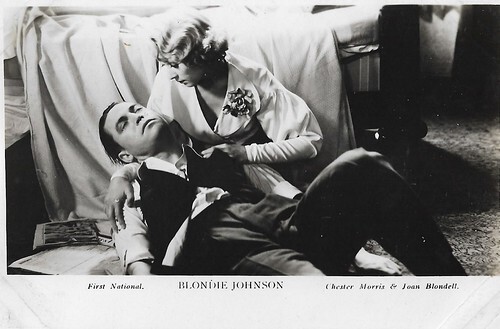
British postcard by Film Weekly. Photo: First National. Joan Blondell and Chester Morris in Blondie Johnson (Ray Enright, 1933).
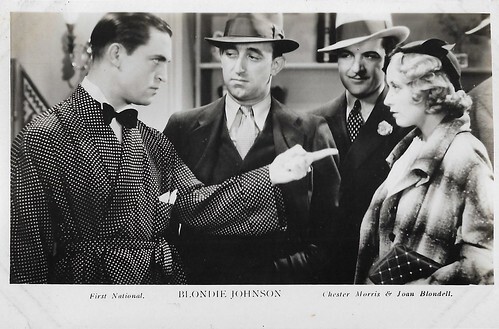
British postcard by Film Weekly. Photo: First National. Chester Morris and Joan Blondell in Blondie Johnson (Ray Enright, 1933).
Too much of a good thing is wonderful
Blondie Johnson (Ray Enright, 1933) is set during the Great Depression. Blondie Johnson ( Joan Blondell ) quits her job after her boss sexually harasses her. She and her sick mother are then evicted from their apartment and are unable to get any government relief funds.
After her mother dies, Blondie is determined to become rich. She soon gets involved in a criminal organisation and falls in love with Danny, one of its members (Chester Morris). Later she convinces him to take down his boss, Max Wagner (Arthur Vinton). Blondie eventually climbs up the criminal ladder, becoming the boss of the "little navy" gang before the gang is exposed. When Danny opposes Blondie, she avenges and the gang thinks he ratted about the killing of Max. Blondie arrives too late to hold back the thugs, but Danny is not mortally wounded. Instead, the gang is arrested. Blondie is convicted too and sent to prison for six years, but she and Danny promise each other that they will make a fresh start after paying their debts to society.
The story and screenplay of Blondie Johnson was written by Earl Baldwin. Joan Blondell makes the most of his put-downs:
Danny: If you was my dame I’d break your neck.
Blondie: If I was your dame I’d deserve it.
Danny: What are you trying to do? Put ideas in my head?
Blondie: There's certainly plenty of room for ’em.
'Blondell is her usual wisecracking, tear-jerking, tough, funny, sexy self, but the film gives her more dramatic scope than usual and an edge of bitterness lacking in her wised-up-but-good-hearted sidekick roles.', Imogensera Smith writes at IMDb . Another IMDb reviewer, Glennstenb: ' Joan Blondell Shines as Blondie! Blondie Johnson is a marvellous piece of film fun, made just before the era of the speakeasy was to conclude. The story is engaging and is a so-called 'gangster movie' with a difference. The fun dialogue goes on relentlessly with generous helpings of stellar interactions. This movie contains, additionally, an eye-boggling march across the screen of sparkling Art-Deco interiors and Depression-era fashions.'
Imogensara Smith: 'Blondie Johnson is obviously derivative of the previous year's Blonde Crazy, but here is a case where, in the words of Mae West , "too much of a good thing is wonderful." The only flaw is that Chester Morris is no Jimmy Cagney ; he is convincing as a rather dim bulb and shares none of the chemistry with Blondell that lit up Blonde Crazy. The supporting cast helps fill the breach, with Allen Jenkins earning a laugh at his first appearance just by being Allen Jenkins; Mae Busch as Jenkins's world-weary girlfriend; the lovely and sardonic Toshia Mori; and the inevitable 'other woman', Claire Dodd.'
: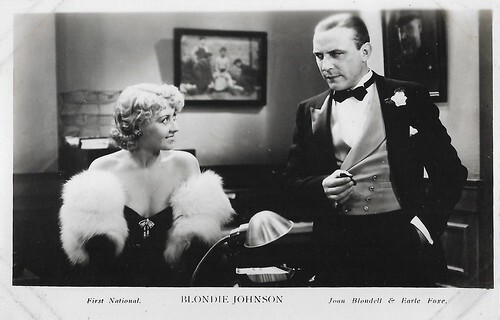
British postcard by Film Weekly. Photo: First National. Joan Blondell and Earle Foxe in Blondie Johnson (Ray Enright, 1933).
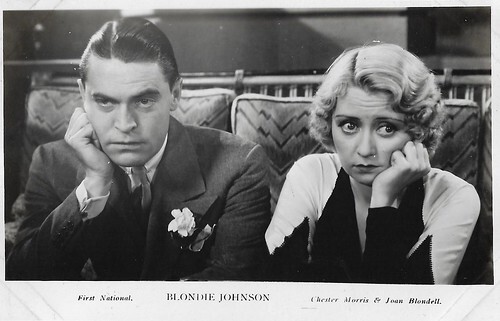
British postcard by Film Weekly. Photo: First National. Chester Morris and Joan Blondell in Blondie Johnson (Ray Enright, 1933).
Sources: Imogensara Smith (IMDb), Glennstenb (IMDb), Wikipedia and IMDb.

British postcard by Film Weekly. Photo: First National. Joan Blondell and Chester Morris in Blondie Johnson (Ray Enright, 1933).

British postcard by Film Weekly. Photo: First National. Chester Morris and Joan Blondell in Blondie Johnson (Ray Enright, 1933).
Too much of a good thing is wonderful
Blondie Johnson (Ray Enright, 1933) is set during the Great Depression. Blondie Johnson ( Joan Blondell ) quits her job after her boss sexually harasses her. She and her sick mother are then evicted from their apartment and are unable to get any government relief funds.
After her mother dies, Blondie is determined to become rich. She soon gets involved in a criminal organisation and falls in love with Danny, one of its members (Chester Morris). Later she convinces him to take down his boss, Max Wagner (Arthur Vinton). Blondie eventually climbs up the criminal ladder, becoming the boss of the "little navy" gang before the gang is exposed. When Danny opposes Blondie, she avenges and the gang thinks he ratted about the killing of Max. Blondie arrives too late to hold back the thugs, but Danny is not mortally wounded. Instead, the gang is arrested. Blondie is convicted too and sent to prison for six years, but she and Danny promise each other that they will make a fresh start after paying their debts to society.
The story and screenplay of Blondie Johnson was written by Earl Baldwin. Joan Blondell makes the most of his put-downs:
Danny: If you was my dame I’d break your neck.
Blondie: If I was your dame I’d deserve it.
Danny: What are you trying to do? Put ideas in my head?
Blondie: There's certainly plenty of room for ’em.
'Blondell is her usual wisecracking, tear-jerking, tough, funny, sexy self, but the film gives her more dramatic scope than usual and an edge of bitterness lacking in her wised-up-but-good-hearted sidekick roles.', Imogensera Smith writes at IMDb . Another IMDb reviewer, Glennstenb: ' Joan Blondell Shines as Blondie! Blondie Johnson is a marvellous piece of film fun, made just before the era of the speakeasy was to conclude. The story is engaging and is a so-called 'gangster movie' with a difference. The fun dialogue goes on relentlessly with generous helpings of stellar interactions. This movie contains, additionally, an eye-boggling march across the screen of sparkling Art-Deco interiors and Depression-era fashions.'
Imogensara Smith: 'Blondie Johnson is obviously derivative of the previous year's Blonde Crazy, but here is a case where, in the words of Mae West , "too much of a good thing is wonderful." The only flaw is that Chester Morris is no Jimmy Cagney ; he is convincing as a rather dim bulb and shares none of the chemistry with Blondell that lit up Blonde Crazy. The supporting cast helps fill the breach, with Allen Jenkins earning a laugh at his first appearance just by being Allen Jenkins; Mae Busch as Jenkins's world-weary girlfriend; the lovely and sardonic Toshia Mori; and the inevitable 'other woman', Claire Dodd.'
:

British postcard by Film Weekly. Photo: First National. Joan Blondell and Earle Foxe in Blondie Johnson (Ray Enright, 1933).

British postcard by Film Weekly. Photo: First National. Chester Morris and Joan Blondell in Blondie Johnson (Ray Enright, 1933).
Sources: Imogensara Smith (IMDb), Glennstenb (IMDb), Wikipedia and IMDb.
Published on November 24, 2024 22:00
November 23, 2024
Gordon MacRae
With his handsome boy-next-door looks, deep baritone, and glorious smile, Gordon MacRae (1920-1986) was successful as a singer and musical actor. He was best known for five films with Doris Day and his roles in the film versions of two Rodgers and Hammerstein musicals, Oklahoma! (1955) and Carousel (1956).
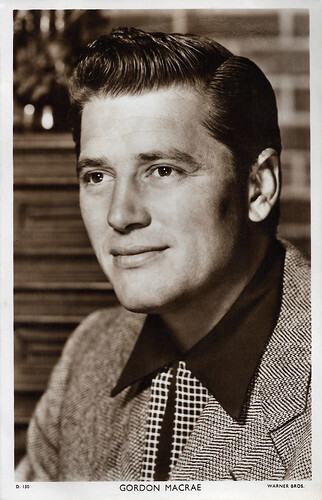
British postcard in the Picturegoer Series, London, no. D. 150. Photo: Warner Bros.
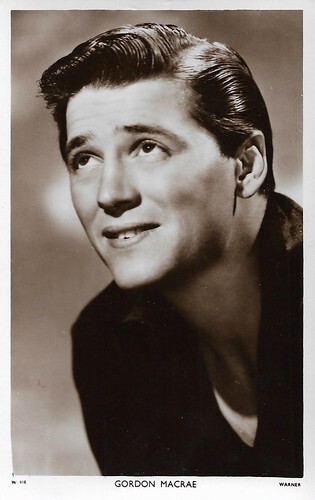
British postcard in the Picturegoer Series, London, no. W 918. Photo: Warner Bros.
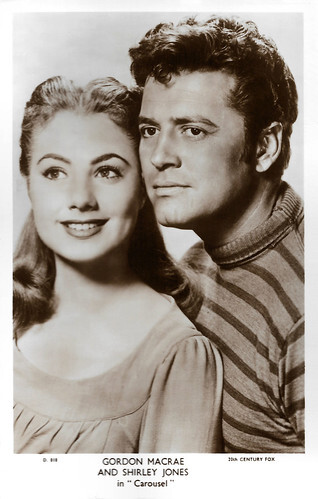
British postcard in the Picturegoer Series, London, no. D 818. Photo: 20th Century Fox. Gordon MacRae and Shirley Jones in Carousel (1956).
Performing at the New York World's Fair
Albert Gordon MacRae was born in East Orange, New Jersey, in 1920. He was the son of radio singer and tool maker ‘Wee Willie’ MacRae, and Helen Violet Sonn, a concert pianist. When he was very young, his family moved to Syracuse, NY, where he attended Nottingham High School, participating in the Drama Club. It was during this time that he also learned to play the piano, the clarinet and the saxophone.
He graduated from Deerfield Academy in Massachusetts, in 1940 and won a singing contest sponsored by Picture Magazine at age 19,. The prize was a two-week engagement at the New York World's Fair performing with the Harry James and Les Brown bands. Shortly afterwards, he obtained work as a singer with the Horace Heidt Band in New York City. The singer stayed with Heidt's outfit for a couple of years before enlisting in the armed forces.
In 1941, he wed actress and singer Sheila Margot Stephens. They would have four children: Meredith, Heather, William and Robert, and both, Meredith and Heather MacRae would pursue acting careers. During World War II, he joined the Army Air Force, serving as a navigator for two years. At the end of the war, he returned to New York City, where he made his Broadway debut in the show ‘Junior Miss’, as a replacement in the role of Tommy Arbuckle.
In 1946, he appeared in Ray Bolger's Broadway revue ‘Three to Make Ready’. A Capitol Records talent scout saw him in it and signed him to a long-term recording contract. He would stay with Capitol Records for the next twenty years. Beginning in 1947, MacRae's releases for Capitol were quite successful. Through 1954 he scored numerous hits, among them ‘Rambling Rose’, ‘So in Love’, ‘It's Magic’, ‘I Still Get Jealous’, ‘Hair of Gold, Eyes of Blue’, and ‘At the Candlelight Café’.
Following an absence of four years from the charts, ‘The Secret’ brought about his return. Many of his hit recordings were made with Jo Stafford. MacRae also put out an album in collaboration with his wife, Sheila MacRae. During the late 1940s MacRae landed a starring role in the music-based program ‘The Railroad Hour’, where he remained through 1954 despite a change of networks. It presented operettas and musicals, all starring MacRae and many different leading ladies.
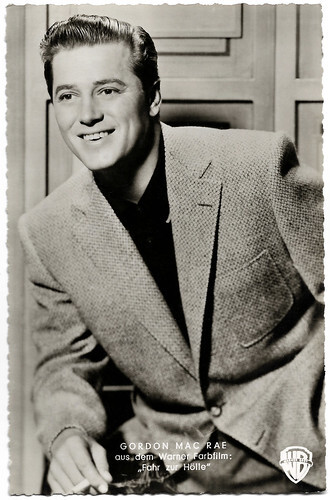
West German postcard by Kunst und Bild, Berlin-Charlottenburg, no I 281. Photo: Warner Bros. Gordon MacRae in Return of the Frontiersman (Richard L. Bare, 1950).
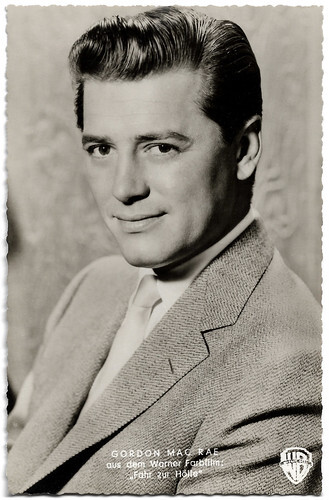
West German postcard by Kunst und Bild, Berlin-Charlottenburg, no T 880. Photo: Warner Bros. Gordon MacRae in Return of the Frontiersman (Richard L. Bare, 1950).
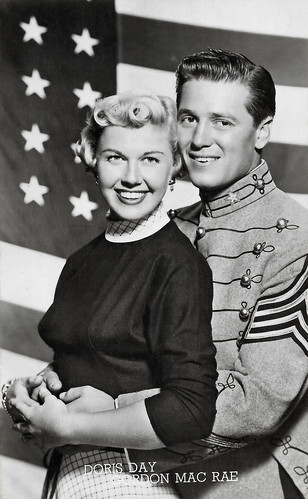
Vintage postcard, no. 352. Photo: Warner Bros. Doris Day and Gordon MacRae in The West Point Story (Roy Del Ruth, 1950).
Five fondly remembered films with Doris Day
In 1948, Gordon MacRae signed a seven-year contract with Warner Brothers Studio. His first film was a non-musical boxing drama, The Big Punch (Sherry Shourds, 1948), opposite Lois Maxwell, later known as Miss Moneypenny in the James Bond films. His next film was a musical with June Haver and Ray Bolger, Look for the Silver Lining (David Butler, 1949). Several musical films were soon to follow which highlighted his singing talent.
He starred in five fondly remembered films with Doris Day , beginning with Tea for Two (David Butler, 1950) and The West Point Story (Roy Del Ruth, 1950). In 1951, they starred in On Moonlight Bay (Roy Del Ruth, 1951, followed by the sequel By the Light of the Silvery Moon (David Butler, 1953).
That same year, he also starred opposite Kathryn Grayson in the third film version of The Desert Song (H. Bruce Humberstone, 1953). This was followed by his two best-remembered roles as Curly in Oklahoma! (Fred Zinnemann, 1955), and as Billy Bigelow in Carousel (Henry King, 1956).
In both Rodgers and Hammerstein musicals, he had appeared previously on Broadway and in both films, he co-starred with Shirley Jones. While appearing in a nightclub act with his wife at Lake Tahoe, he received an emergency phone call to replace Frank Sinatra as Billy Bigelow in the film version of Rodgers and Hammerstein's stage hit 'Carousel'.
Frank Sinatra walked out on the filming when he discovered that every scene was to be filmed twice - once for regular CinemaScope and once for CinemaScope 55. Within three days MacRae, who had wanted to play the role, reported to the set. Ironically, the producers then discovered a way to shoot in CinemaScope 55 and then convert it to regular CinemaScope without shooting the film twice.
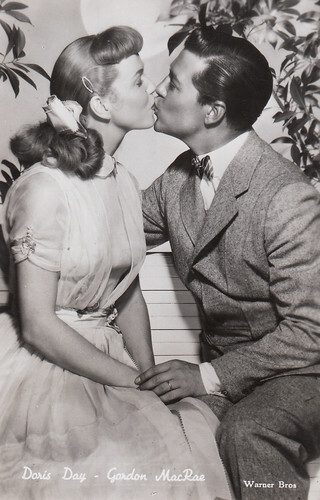
Belgian postcard. Photo: Warner Bros. Doris Day and Gordon MacRea in On Moonlight Bay (Roy Del Ruth, 1951). Collection: Marlene Pilaete.
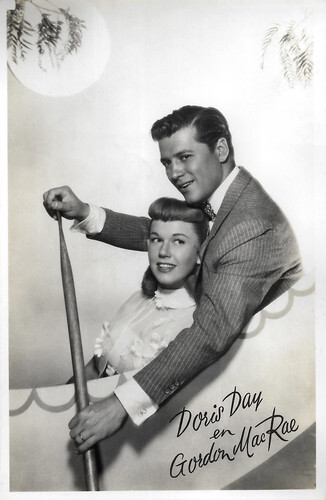
Dutch postcard by Takken, no. F 97. Photo: Warner Bros. Doris Day and Gordon MacRae in By the Light of the Silvery Moon (David Butler, 1953).
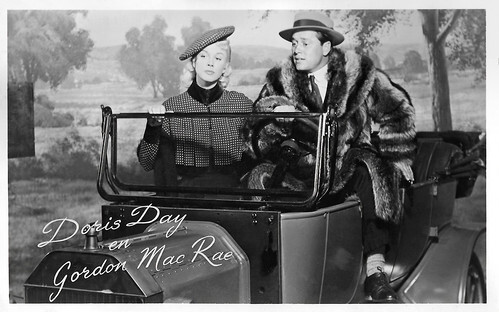
Dutch postcard by Takken / 't Sticht, no. 1176. Doris Day and Gordon MacRae in By the Light of the Silvery Moon (David Butler, 1953). Sent by mail in 1954.
Alcohol addiction
In 1956, Gordon MacRae moved to television with his own show, The Gordon MacRae Show which lasted only one season. He also frequently turned up on such popular television shows as The Colgate Comedy Hour. At this stage, he began drinking heavily, eventually becoming an alcoholic which may have cost him his marriage. Sheila divorced him in 1967.
MacRae remarried just four months later to Elizabeth ‘Liz’ Lambert Schrafft. She would remain with him until the end of his life and the couple raised one daughter, Amanda Mercedes MacRae born in 1968. During the 1960s he appeared often on the Ed Sullivan Show.
In 1974, he appeared as a sheriff on an episode of the TV series McCloud, starring Dennis Weaver. By the late 1970s he claimed to have wrested control over his alcohol addiction and he went on to counsel other alcoholics.
His last film appearance was in 1979. He played the supporting role of Joe Barnes in the drama The Pilot (Cliff Robertson, 1980) in which Cliff Robertson held the lead role of an alcoholic pilot.
In 1982, MacRae suffered a stroke. With the support of his wife and children, he kept touring and singing hits from his earlier years. In the fall of 1985, he underwent a carotid artery operation. At that time, he was diagnosed with cancer and was forced to retire completely. Gordon MacRae died in 1986 of pneumonia, from complications due to cancer of the mouth and jaw at his home in Lincoln, Nebraska. He was only 64. The actor was interred at the Wyuka Cemetery in Lincoln, Nebraska.
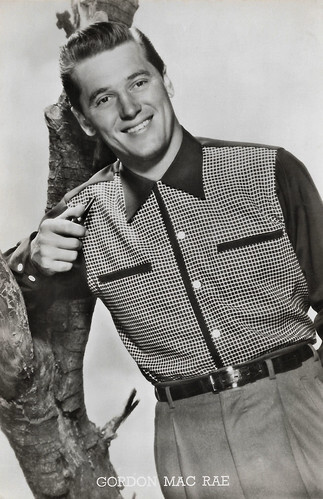
Belgian postcard, no. 452. Photo: Warner Bros.
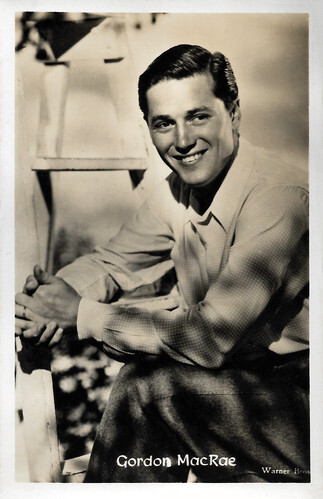
Vintage postcard. Photo: Warner Bros.
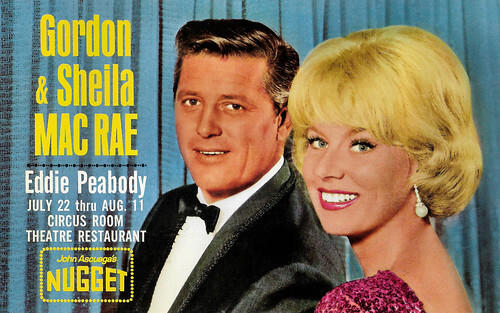
American postcard by Mike Roberts Color Production, Berkely. California, no. SC 9603. Gordon MacRae and Sheila MacRae performed at John Ascuaga's Nugget, Sparks (East Reno).
Sources: Kit and Morgan Benson (Find A Grave), Linda Seida (AllMusic), (IMDb), Hollywood – Walk of Fame, Wikipedia and .

British postcard in the Picturegoer Series, London, no. D. 150. Photo: Warner Bros.

British postcard in the Picturegoer Series, London, no. W 918. Photo: Warner Bros.

British postcard in the Picturegoer Series, London, no. D 818. Photo: 20th Century Fox. Gordon MacRae and Shirley Jones in Carousel (1956).
Performing at the New York World's Fair
Albert Gordon MacRae was born in East Orange, New Jersey, in 1920. He was the son of radio singer and tool maker ‘Wee Willie’ MacRae, and Helen Violet Sonn, a concert pianist. When he was very young, his family moved to Syracuse, NY, where he attended Nottingham High School, participating in the Drama Club. It was during this time that he also learned to play the piano, the clarinet and the saxophone.
He graduated from Deerfield Academy in Massachusetts, in 1940 and won a singing contest sponsored by Picture Magazine at age 19,. The prize was a two-week engagement at the New York World's Fair performing with the Harry James and Les Brown bands. Shortly afterwards, he obtained work as a singer with the Horace Heidt Band in New York City. The singer stayed with Heidt's outfit for a couple of years before enlisting in the armed forces.
In 1941, he wed actress and singer Sheila Margot Stephens. They would have four children: Meredith, Heather, William and Robert, and both, Meredith and Heather MacRae would pursue acting careers. During World War II, he joined the Army Air Force, serving as a navigator for two years. At the end of the war, he returned to New York City, where he made his Broadway debut in the show ‘Junior Miss’, as a replacement in the role of Tommy Arbuckle.
In 1946, he appeared in Ray Bolger's Broadway revue ‘Three to Make Ready’. A Capitol Records talent scout saw him in it and signed him to a long-term recording contract. He would stay with Capitol Records for the next twenty years. Beginning in 1947, MacRae's releases for Capitol were quite successful. Through 1954 he scored numerous hits, among them ‘Rambling Rose’, ‘So in Love’, ‘It's Magic’, ‘I Still Get Jealous’, ‘Hair of Gold, Eyes of Blue’, and ‘At the Candlelight Café’.
Following an absence of four years from the charts, ‘The Secret’ brought about his return. Many of his hit recordings were made with Jo Stafford. MacRae also put out an album in collaboration with his wife, Sheila MacRae. During the late 1940s MacRae landed a starring role in the music-based program ‘The Railroad Hour’, where he remained through 1954 despite a change of networks. It presented operettas and musicals, all starring MacRae and many different leading ladies.

West German postcard by Kunst und Bild, Berlin-Charlottenburg, no I 281. Photo: Warner Bros. Gordon MacRae in Return of the Frontiersman (Richard L. Bare, 1950).

West German postcard by Kunst und Bild, Berlin-Charlottenburg, no T 880. Photo: Warner Bros. Gordon MacRae in Return of the Frontiersman (Richard L. Bare, 1950).

Vintage postcard, no. 352. Photo: Warner Bros. Doris Day and Gordon MacRae in The West Point Story (Roy Del Ruth, 1950).
Five fondly remembered films with Doris Day
In 1948, Gordon MacRae signed a seven-year contract with Warner Brothers Studio. His first film was a non-musical boxing drama, The Big Punch (Sherry Shourds, 1948), opposite Lois Maxwell, later known as Miss Moneypenny in the James Bond films. His next film was a musical with June Haver and Ray Bolger, Look for the Silver Lining (David Butler, 1949). Several musical films were soon to follow which highlighted his singing talent.
He starred in five fondly remembered films with Doris Day , beginning with Tea for Two (David Butler, 1950) and The West Point Story (Roy Del Ruth, 1950). In 1951, they starred in On Moonlight Bay (Roy Del Ruth, 1951, followed by the sequel By the Light of the Silvery Moon (David Butler, 1953).
That same year, he also starred opposite Kathryn Grayson in the third film version of The Desert Song (H. Bruce Humberstone, 1953). This was followed by his two best-remembered roles as Curly in Oklahoma! (Fred Zinnemann, 1955), and as Billy Bigelow in Carousel (Henry King, 1956).
In both Rodgers and Hammerstein musicals, he had appeared previously on Broadway and in both films, he co-starred with Shirley Jones. While appearing in a nightclub act with his wife at Lake Tahoe, he received an emergency phone call to replace Frank Sinatra as Billy Bigelow in the film version of Rodgers and Hammerstein's stage hit 'Carousel'.
Frank Sinatra walked out on the filming when he discovered that every scene was to be filmed twice - once for regular CinemaScope and once for CinemaScope 55. Within three days MacRae, who had wanted to play the role, reported to the set. Ironically, the producers then discovered a way to shoot in CinemaScope 55 and then convert it to regular CinemaScope without shooting the film twice.

Belgian postcard. Photo: Warner Bros. Doris Day and Gordon MacRea in On Moonlight Bay (Roy Del Ruth, 1951). Collection: Marlene Pilaete.

Dutch postcard by Takken, no. F 97. Photo: Warner Bros. Doris Day and Gordon MacRae in By the Light of the Silvery Moon (David Butler, 1953).

Dutch postcard by Takken / 't Sticht, no. 1176. Doris Day and Gordon MacRae in By the Light of the Silvery Moon (David Butler, 1953). Sent by mail in 1954.
Alcohol addiction
In 1956, Gordon MacRae moved to television with his own show, The Gordon MacRae Show which lasted only one season. He also frequently turned up on such popular television shows as The Colgate Comedy Hour. At this stage, he began drinking heavily, eventually becoming an alcoholic which may have cost him his marriage. Sheila divorced him in 1967.
MacRae remarried just four months later to Elizabeth ‘Liz’ Lambert Schrafft. She would remain with him until the end of his life and the couple raised one daughter, Amanda Mercedes MacRae born in 1968. During the 1960s he appeared often on the Ed Sullivan Show.
In 1974, he appeared as a sheriff on an episode of the TV series McCloud, starring Dennis Weaver. By the late 1970s he claimed to have wrested control over his alcohol addiction and he went on to counsel other alcoholics.
His last film appearance was in 1979. He played the supporting role of Joe Barnes in the drama The Pilot (Cliff Robertson, 1980) in which Cliff Robertson held the lead role of an alcoholic pilot.
In 1982, MacRae suffered a stroke. With the support of his wife and children, he kept touring and singing hits from his earlier years. In the fall of 1985, he underwent a carotid artery operation. At that time, he was diagnosed with cancer and was forced to retire completely. Gordon MacRae died in 1986 of pneumonia, from complications due to cancer of the mouth and jaw at his home in Lincoln, Nebraska. He was only 64. The actor was interred at the Wyuka Cemetery in Lincoln, Nebraska.

Belgian postcard, no. 452. Photo: Warner Bros.

Vintage postcard. Photo: Warner Bros.

American postcard by Mike Roberts Color Production, Berkely. California, no. SC 9603. Gordon MacRae and Sheila MacRae performed at John Ascuaga's Nugget, Sparks (East Reno).
Sources: Kit and Morgan Benson (Find A Grave), Linda Seida (AllMusic), (IMDb), Hollywood – Walk of Fame, Wikipedia and .
Published on November 23, 2024 22:00
November 22, 2024
Buster Keaton
Stone-faced Buster Keaton (1895-1966) was one of the three greatest comedians of Silent Hollywood. His enduring classics such as Our Hospitality (1923), The Navigator (1924), Sherlock Jr. (1924), College (1927), and The General (1927) showcase all of Keaton’s virtues: his deadpan humour, his innovative technical accomplishments, his amazing stunts and perfect gags. Most of his films were long thought to be lost. It was only in the 1960s that film historians began to assemble and restore Keaton’s lifework. Now almost everything has been recovered and restored.
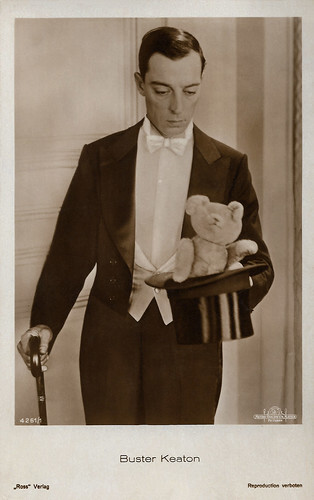
German postcard by Ross Verlag, no. 4261/1, 1929-1930. Photo: Metro-Goldwyn-Mayer. Buster Keaton in Spite Marriage (Edward Sedgwick, Buster Keaton, 1929).
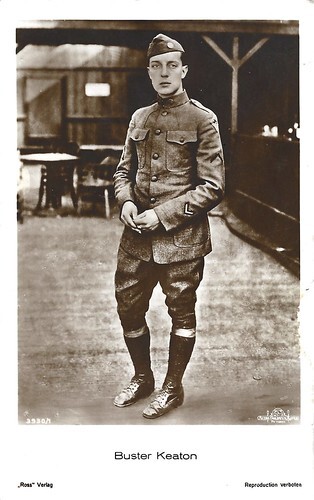
German postcard by Ross Verlag, Berlin, no. 3930/1, 1928-1929. Photo: Metro-Goldwyn-Mayer. The photo of Buster Keaton as a WWI soldier was made in 1918-1919. The card may be intended as publicity for his film Doughboys/Forward March (Edward Sedgwick, 1930).
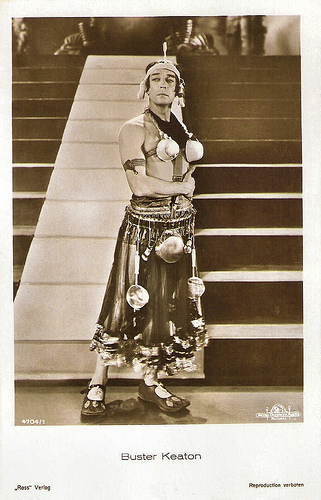
German postcard by Ross Verlag, no. 4704/1, 1929-1930. Photo: MGM. Publicity still for The Hollywood Revue of 1929 (Charles Reisner, 1929) with Keaton as Princess Raja. This performance must have been inspired by the Egyptian dance in The Cook (Roscoe 'Fatty' Arbuckle, 1918).
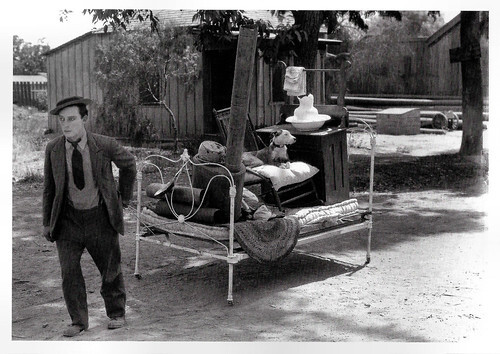
British postcard by Portfolio, London, no. VO 18. Photo: Kobal Collection. Buster Keaton in Go West (Buster Keaton, 1925).
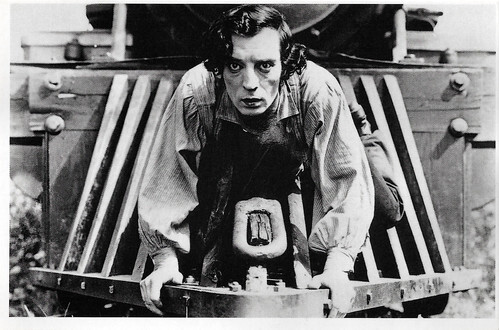
British postcard by World Postcards Inc., no. X283, 1990, no. 9266, 1982. Buster Keaton in The General (Clyde Bruckman, Buster Keaton, 1927).
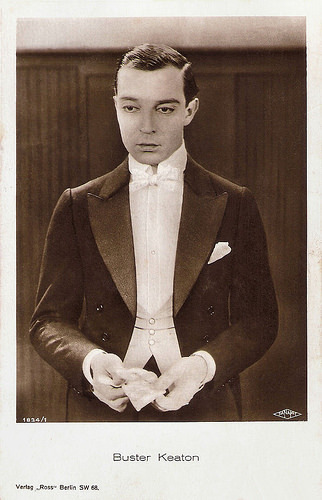
German postcard by Ross Verlag, no. 1834/1, 1927-1928. Photo: Fanamet. Publicity still for Spite Marriage (Edward Sedgewick, Buster Keaton, 1929).
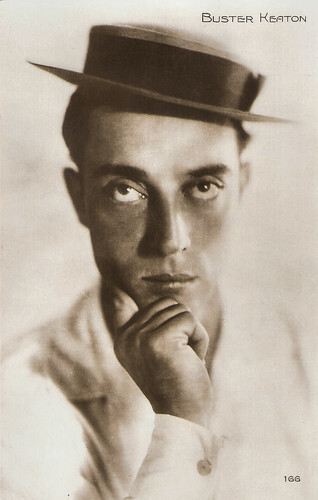
French postcard by Cinémagazine-Édition, Paris, no. 166.
The great stone face
Buster Keaton was born Joseph Frank Keaton in 1895 into a vaudeville family. Keaton was born in Piqua, Kansas, the small town where his mother, Myra Keaton (née Myra Edith Cutler), happened to go into labour. His father was Joseph Hallie 'Joe' Keaton who had a travel'ing show called the Mohawk Indian Medicine Company, which performed on stage and sold patent medicine on the side. According to a frequently repeated story, Keaton acquired the nickname Buster at the age of 18 months. After the child fell down a long flight of stairs without injury, an actor friend named George Pardey remarked, "Gee whiz, he's a regular buster!" After this, Keaton's father began to use the nickname to refer to the youngster.
By the time he was 3, Keaton began performing with his parents in The Three Keatons. He was being thrown around the stage and into the orchestra pit, or even into the audience. His little suits even had a handle concealed at the waist, so Joe could sling him like luggage. "It was the roughest knockabout act that was ever in the history of the theatre," Keaton told the historian Kevin Brownlow. It led to accusations of child abuse, and occasionally, arrest. However, Buster Keaton was always able to show the authorities that he had no bruises or broken bones. Film critic Roger Ebert: "Noticing that his laughing drew fewer laughs from the audience, Keaton adopted his famous deadpan expression whenever he was working. For the rest of his career, Keaton was 'the great stone face', with an expression that ranged from the impassive to the slightly quizzical."
By the time he was 21, his father's alcoholism threatened the reputation of the family act, so Keaton and his mother, Myra, left for New York, where Buster Keaton's career swiftly moved from vaudeville to film. In February 1917, Keaton met Roscoe ‘Fatty’ Arbuckle at the Talmadge Studios in New York City, where Arbuckle was under contract to Joseph M. Schenck. He was hired as a co-star and gagman, making his first appearance in the short The Butcher Boy (Roscoe 'Fatty' Arbuckle, 1917). Keaton appeared in a total of 14 Arbuckle shorts, running into 1920. They were popular and, Keaton and Arbuckle became close friends. Keaton was one of few people to defend Arbuckle's character during accusations that he was responsible for the death of actress Virginia Rappe in 1921.
In The Saphead (Herbert Blaché, Winchell Smith, 1920), Keaton had his first starring role in a full-length feature. It was a success and Schenck gave him his own production unit, Buster Keaton Comedies. He made a series of two-reel comedies, including One Week (Edward F. Cline, Buster Keaton, 1920), The Boat (Edward F. Cline, Buster Keaton, 1921), Cops (Edward F. Cline, Buster Keaton, 1922), and The Paleface (Edward F. Cline, Buster Keaton, 1922). Keaton then moved to full-length features. His first feature, Three Ages (Edward F. Cline, Buster Keaton, 1923), was produced similarly to his short films and was the dawning of a new era in comedic cinema, where it became apparent to Keaton that he had to put more focus on the storylines and characterization.
His most enduring features include Our Hospitality (John G. Blystone, Buster Keaton, 1923), The Navigator (Donald Crisp, Buster Keaton, 1924), Sherlock Jr. (Buster Keaton, 1924), College (James W. Horne, Buster Keaton, 1927), and The General (Clyde Bruckman, Buster Keaton, 1927). My favourite is The General, set during the American Civil War. The film combines physical comedy with Keaton's love of trains, including an epic locomotive chase. Employing picturesque locations, the film's storyline re-enacted an actual wartime incident. Though it would come to be regarded as Keaton's greatest achievement, the film received mixed reviews at the time. It was too dramatic for some filmgoers expecting a lightweight comedy. It was an expensive misfire, and Keaton was never entrusted with total control over his films again. His distributor, United Artists, insisted on a production manager who monitored expenses and interfered with certain story elements.
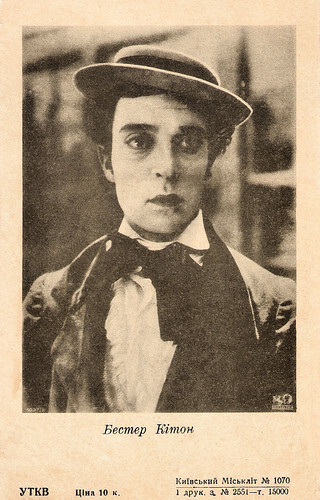
Soviet postcard, no. 1070. Photo: Phoebus Film (Probably the Ross Verlag card, no. 1037/2, was used for this card, produced in Kiev, now Ukraine). Publicity still for Our Hospitality (1923).
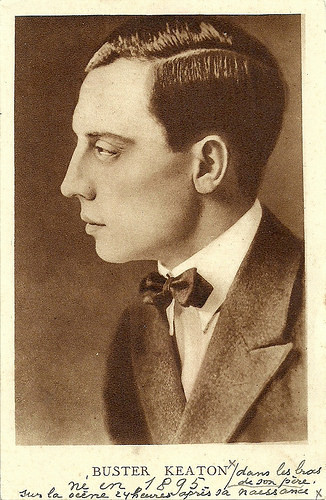
Belgian postcard by Ed. Weekblad Cinema, Antwerpen. French written caption: Buster Keaton, born in 1895, on the stage 24 hours after his birth, in the arms of his father.
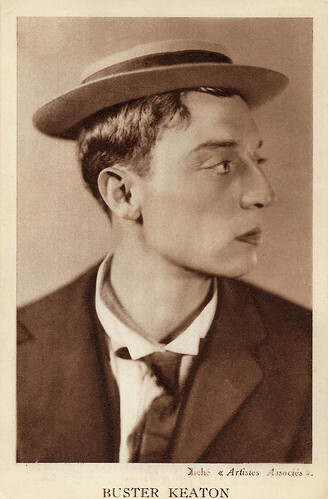
Belgian postcard by Kivou, Vilvoorde. Photo: United Artists.
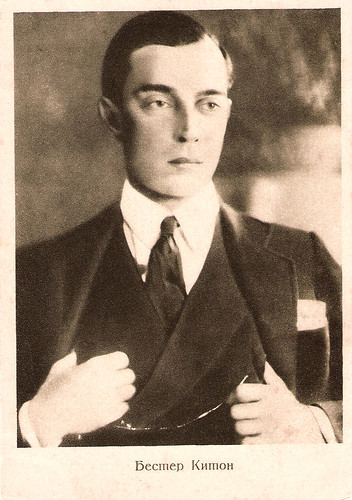
Russian postcard, no. 1725, 1927.
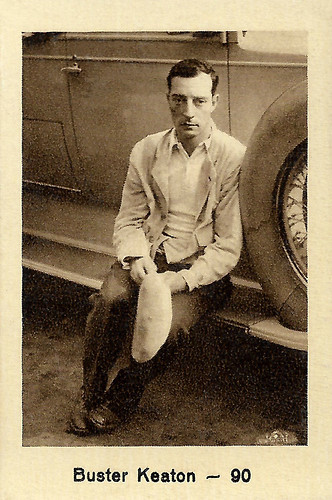
German cigarette card by Monopol Film-Bilder, no. 90.
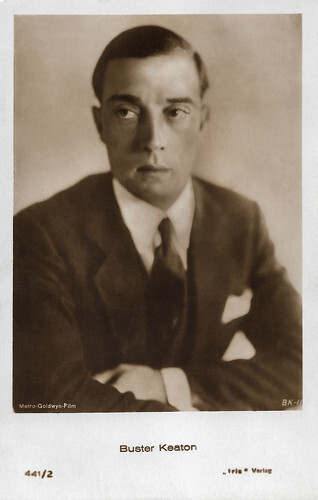
Austrian postcard by Iris Verlag, no. 441/2. Photo: Metro-Goldwyn.
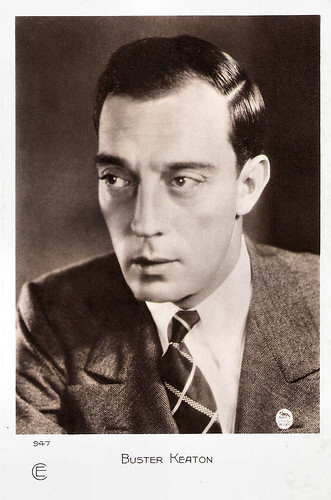
French postcard by Cinémagazine-Edition (CE), Paris, no. 947. Photo: MGM.
The worst decision of his life
Buster Keaton endured this treatment by United Artists for two more feature films, including Steamboat Bill Jr. (Charles Reisner, Buster Keaton, 1928). In Steamboat Bill, Jr. is the famous shot where Keaton stands in front of a house during a cyclone, and a wall falls on top of him. Buster is saved because he happens to be exactly where the window is. There was scant clearance on either side, and you can see his shoulders tighten a little just as the wall lands. He refused to rehearse the stunt because, he explained, he trusted his set-up, so why waste a wall? After this film, he exchnged his independent setup for employment at Hollywood's biggest studio, Metro-Goldwyn-Mayer (MGM). Keaton's loss of independence as a filmmaker coincided with the coming of sound films (although he was interested in making the transition) and mounting personal problems.
In 1921, Keaton married Natalie Talmadge, sister-in-law of his boss, Joseph Schenck, and sister of actresses Norma Talmadge and Constance Talmadge . She co-starred with Keaton in Our Hospitality. The couple had two sons, James (1922-2007) and Robert (1924–2009), but after the birth of Robert, the relationship began to suffer. Influenced by her family, Talmadge decided not to have any more children and this led to the couple staying in separate bedrooms. Her financial extravagance (she would spend up to a third of his salary on clothes) was another factor in the breakdown of the marriage.
Keaton signed with MGM in 1928, a business decision that he would later call the worst of his life. He realized too late that MGM’s studio system would severely limit his creative input. For instance, the studio refused his request to make his early project, Spite Marriage (Edward Sedgwick, Buster Keaton, 1929), as a sound film and after the studio converted, he was obliged to adhere to dialogue-laden scripts.
However, MGM did allow Keaton some creative participation in his last originally developed/written silent film The Cameraman (Edward Sedgwick, Buster Keaton, 1928). which was his first project under contract with them. Keaton was forced to use a stunt double during some of the more dangerous scenes, something he had never done in his heyday, as MGM wanted badly to protect its investment. Some of his most financially successful films for the studio were during this period. MGM tried teaming the laconic Keaton with the rambunctious Jimmy Durante in a series of films, The Passionate Plumber (Edward Sedgwick, 1932), Speak Easily (Edward Sedgwick, 1932), and What! No Beer? (Edward Sedgwick, 1933).
In the first Buster Keaton pictures with sound, he and his fellow actors would shoot each scene three times: one in English, one in Spanish, and one in either French or German. The actors would phonetically memorise the foreign-language scripts a few lines at a time and shoot immediately after. In 1932, Nathalie Talmadge divorced Keaton, taking his entire fortune and refusing to allow any contact between Keaton and his sons, whose last name she changed to Talmadge. Keaton was reunited with them about a decade later when his older son turned 18. With the failure of his marriage and the loss of his independence as a filmmaker, Keaton lapsed into a period of alcoholism.
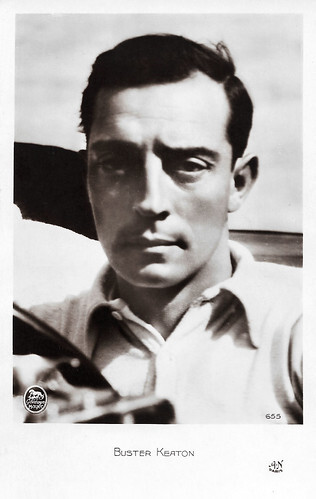
French postcard by A.N., Paris, no. 655. Photo: Metro-Goldwyn-Mayer.
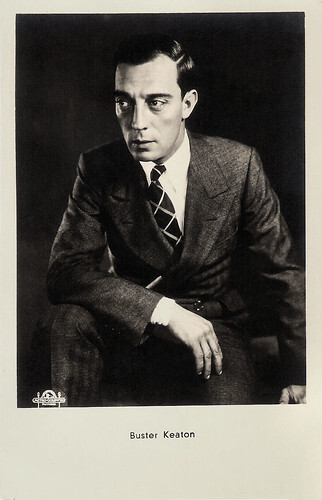
Austrian postcard by Iris Verlag, no. 6256. Photo: Metro Goldwyn Mayer.
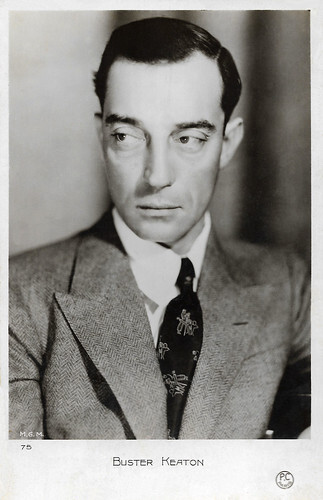
French postcard by P.C., Paris, no. 75. Photo: Metro Goldwyn Mayer.
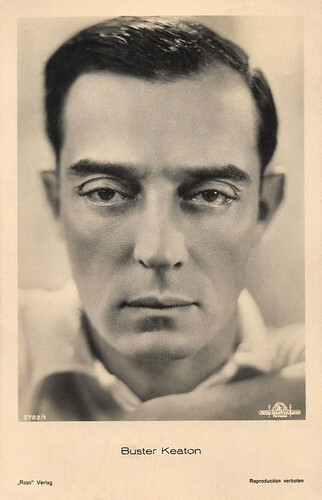
German postcard by Ross Verlag, no. 5782/1, 1930-1931. Photo: MGM.
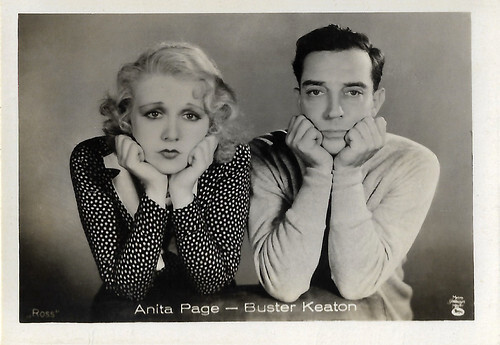
German cigarette card in the Hänsom Filmbilder series, Series V, no. 113 (of 147) by Ross Verlag for Jaszmatzi Cigarettenfabrik G.M.B.H., Dresden. Photo: Metro-Goldwyn-Mayer. Anita Page and Buster Keaton in Free and Easy (Edward Sedgwick, 1930).
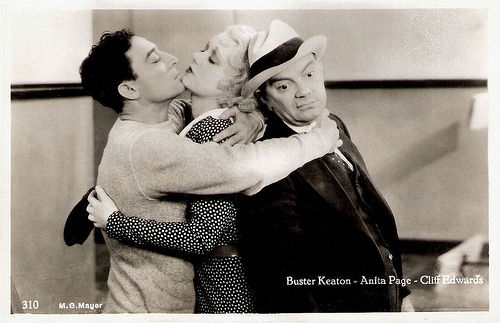
Dutch postcard by JosPe, no. 310. Photo: Metro-Goldwyn-Mayer (MGM). Buster Keaton, Anita Page and Cliff Edwards in Sidewalks of New York (Zion Myers, Jules White, 1931).
The King of the Champs Elysees
Buster Keaton was so demoralised during the production of What! No Beer? (Edward Sedgwick, 1933) that MGM fired him after the filming was complete, despite the film being a resounding hit. In 1933, he married his nurse, Mae Scriven, during an alcoholic binge about which he afterwards claimed to remember nothing. Scriven herself would later claim that she didn't know Keaton's real first name until after the marriage. When they divorced in 1936, it was again at great financial cost to Keaton.
In 1934, Keaton accepted an offer to make an independent film in Paris, Le Roi des Champs-Élysées/The King of the Champs Elysees (Max Nosseck, 1934) with Paulette Dubost . In England, he made another film, The Invader/An Old Spanish Custom (Adrian Brunel, 1936).
Upon Keaton's return to Hollywood, he made a screen comeback in a series of 16 two-reel comedies for Educational Pictures. Most of these are simple visual comedies, with many of the gags supplied by Keaton himself, often recycling ideas from his family vaudeville act and his earlier films. The high point in the Educational series is Grand Slam Opera (Buster Keaton, Charles Lamont, 1936), featuring Buster in his own screenplay as a contestant in a radio amateur hour show hoping to win the first price... by dancing and juggling.
When the series lapsed in 1937, Keaton returned to MGM as a gag writer, including The Marx Brothers films At the Circus (Edward Buzzell, 1939) and Go West (Edward Buzzell, 1940), and providing material for Red Skelton. He also helped and advised Lucille Ball in her comedic work in films and television. In 1939, Columbia Pictures hired Keaton to star in ten two-reel comedies, running for two years. The director was usually Jules White, whose emphasis on slapstick and farce made most of these films resemble White's Three Stooges comedies. Keaton's personal favourite was the series' debut entry, Pest from the West (Del Lord, 1939), a shorter, tighter remake of The Invader (1936). Keaton's Columbia shorts rank as the worst comedies he made.
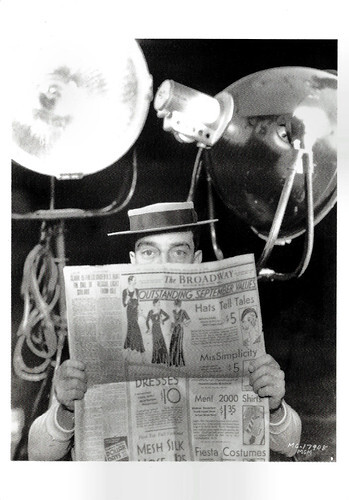
French postcard by Fernand Hazan Editeur, Paris, no. 1654 C. Caption: Buster Keaton, 1929.
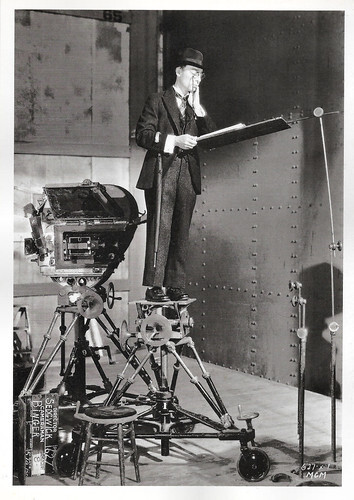
French postcard by Fernand Hazan Éditeur, Paris, no. 1656 C. Photo: MGM. Caption: Buster Keaton, 1930.
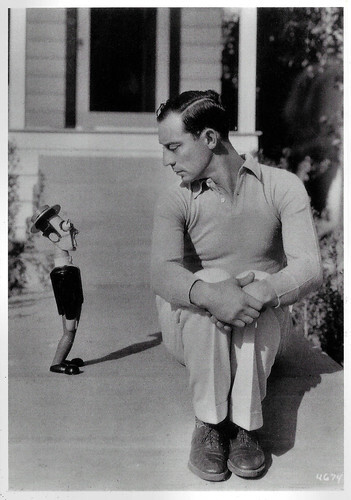
British postcard by Santoro Graphics Ltd, South Yorks, no. BW1666. Photo: Hulton Picture Co.
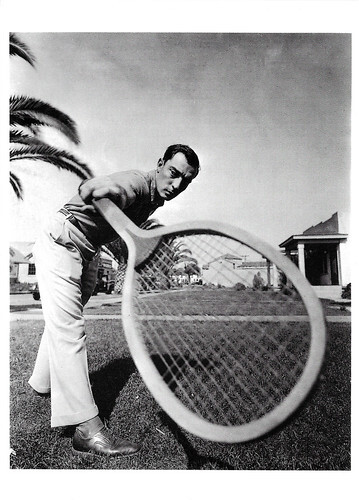
Swiss-German-British postcard by News Productions, Baulmes / Filmwelt Berlin, Bakede / News Productions, Stroud, no. 56550. Photo: MGM / Collection Cinémathèque Suisse, Lausanne.
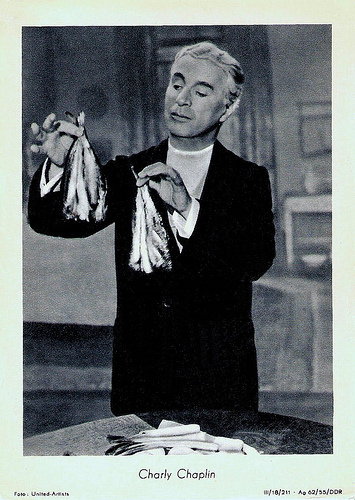
Charlie Chaplin . East-German collectors card, no. III/18/211, 1955. Photo: United Artists. Publicity still for Limelight (1952).
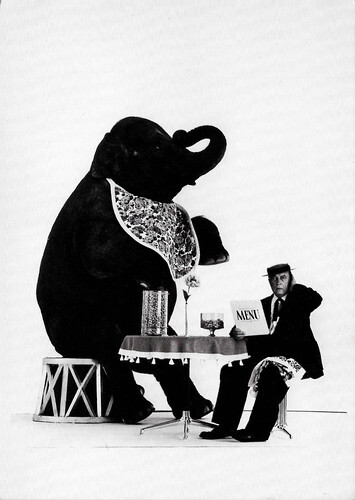
American postcard by Fotofolio, NY, NY, no. P148. Photo: Sid Avery, 1964.

Swiss postcard by News Productions, Baulmes, no. 55207. Photo: Sam Tata. Caption: Buster Keaton, Montreal, 1964. In Canada, Keaton played in the short film The Railrodder (Gerald Potterton, 1965), which Keaton uncredited co-directed.
Another chance at the brass ring
Buster Keaton's personal life stabilised with his 1940 marriage with Eleanor Norris, a 21-year-old dancer. She stopped his heavy drinking and helped to salvage his career. He abandoned Columbia for the less strenuous field of feature films. Throughout the 1940s, Keaton played character roles in features. He made his last starring feature El Moderno Barba Azul/Boom In The Moon (Jaime Salvador, 1946) in Mexico. Critics rediscovered Keaton in 1949. He had cameos in such films as In the Good Old Summertime (Robert Z. Leonard, 1949), Sunset Boulevard (Billy Wilder, 1950), and Around the World in 80 Days (Michael Anderson, 1956), and did innumerable TV appearances. Keaton also appeared in a comedy routine about two inept stage musicians in Charlie Chaplin 's Limelight (1952).
In 1954, Keaton and his wife met film programmer Raymond Rohauer, with whom the couple would develop a business partnership to re-release Keaton's films. Around the same time, after buying the comedian's house, the actor James Mason found numerous cans of Keaton's films. Keaton had prints of the features Three Ages, Sherlock, Jr., Steamboat Bill, Jr., College (missing one reel) and the shorts The Boat and My Wife's Relations, which Keaton and Rohauer transferred to safety stock from deteriorating nitrate film stock. Unknown to them at the time, MGM also had saved some of Keaton's work: all his 1920-1926 features and his first eight two-reel shorts. In 1962 came a retrospective at the Cinematheque Francaise in Paris, and in 1965 a tribute at the Venice Film Festival. "I can't feel sorry for myself," he said in Venice. "It all goes to show that if you stay on the merry-go-round long enough you'll get another chance at the brass ring. Luckily, I stayed on."
In 1960, Keaton returned to MGM for the final time, playing a lion tamer in an adaptation of Mark Twain's The Adventures of Huckleberry Finn (Michael Curtiz, 1960). Later Keaton played a cameo in It's a Mad, Mad, Mad, Mad World (Stanley Kramer, 1963) and starred in four films for American International Pictures: Pajama Party (Don Weis, 1964), Beach Blanket Bingo (William Asher, 1965), How to Stuff a Wild Bikini (William Asher, 1964) and Sergeant Deadhead (Norman Taurog, 1964). As he had done in the past, Keaton also provided gags for the four AIP films.
In 1965, Keaton starred in the short film The Railrodder (Gerald Potterton, Buster Keaton, 1965) for the National Film Board of Canada. Wearing his traditional pork pie hat, he travelled from one end of Canada to the other on a railway motorcar, performing a few stunts similar to those in films he did 50 years earlier. The film was Keaton's last silent screen performance. He also played the central role in Samuel Beckett's Film (Alan Schneider, 1965) and travelled to Italy to play a role in Due Marines e un Generale/War Italian Style (Luigi Scattini, 1965), with Italian comedy duo Franco Franchi and Ciccio Ingrassia.
Buster Keaton's final film was A Funny Thing Happened on the Way to the Forum (Richard Lester, 1966) which was filmed in Spain in September-November 1965. He amazed the cast and crew by doing many of his own stunts. Shortly after completing the film, Keaton died of lung cancer in 1966 at his home in Woodland Hills, California. He was 70. In 1987, the documentary, Buster Keaton: A Hard Act to Follow, directed by Kevin Brownlow and David Gill, won two Emmy Awards.
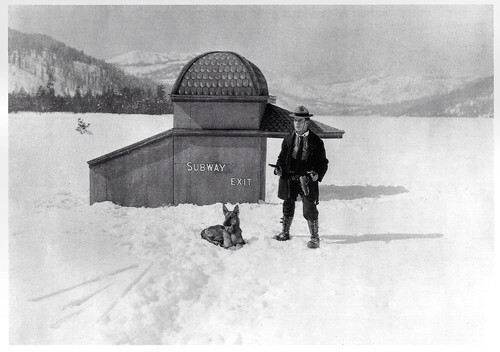
American postcard by The Museum of Modern Art, New York, N.Y., no. 9255, 1988. Photo: The Museum of Modern Art / Film Stills Archive. Buster Keaton in The Frozen North (Edward F. Cline, Buster Keaton, 1922).
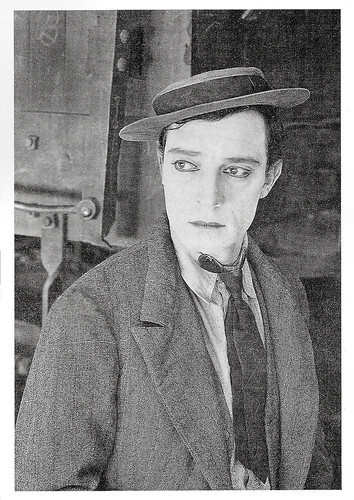
English postcard by Moviedrome, no. M16.
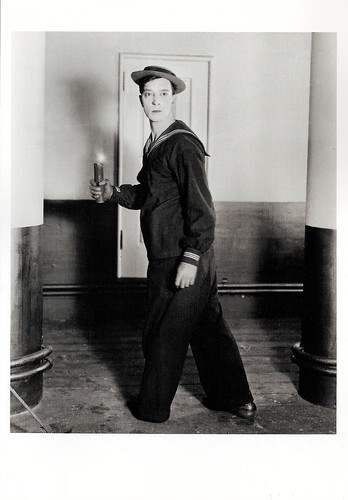
French postcard in the Collection "Portraits de Cinema", Series 3, no. 15, by Editions Admira, Aix-en-Provence, no. PHN 591, 1990. Buster Keaton in The Navigator (Donald Crisp, Buster Keaton, 1924).
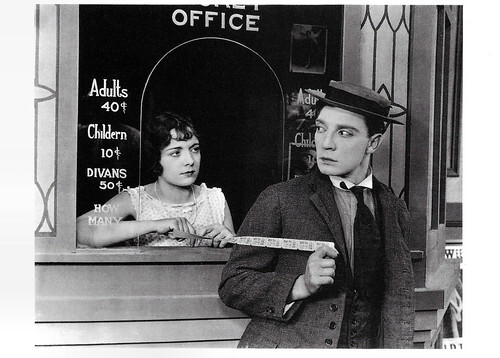
Swiss-German-British postcard by News Productions, Baulmes / Filmwelt Berlin, Bakede / News Productions, Stroud, no. 56545. Photo: MGM / Collection Cinémathèque Suisse, Lausanne. Buster Keaton and Kathryn McGuire in Sherlock Junior (Buster Keaton, 1924).
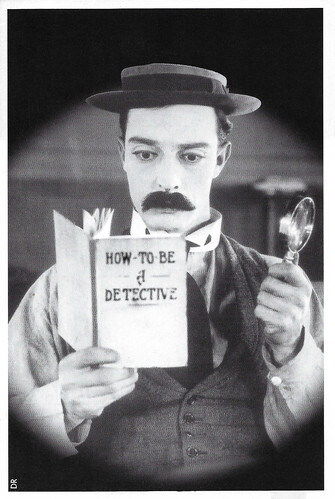
French postcard by DR for a series of Cine-concerts in Département de Val-de-Marne, 2004. Photo: Buster Keaton in Sherlock Junior (Buster Keaton, 1924).
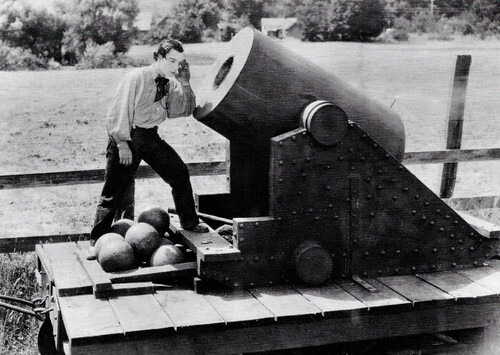
American postcard by The Museum of Modern Art, New York, N.Y., no. 9266, 1982. Photo: The Museum of Modern Art / Film Stills Archive. Buster Keaton in The General (Clyde Bruckman, Buster Keaton, 1927).
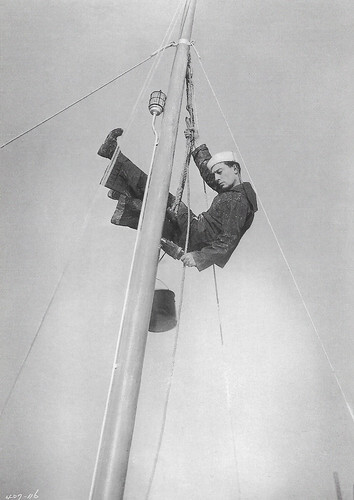
French postcard in the Collection Cinéma series by Editions Art & Scene, Paris, 1994, no. CA 55. Buster Keaton in Spite Marriage (Edward Sedgwick, Buster Keaton, 1929).
Sources: Roger Ebert (Roger Ebert.com), (IMDb), New York Times (page now defunct), Wikipedia, and .

German postcard by Ross Verlag, no. 4261/1, 1929-1930. Photo: Metro-Goldwyn-Mayer. Buster Keaton in Spite Marriage (Edward Sedgwick, Buster Keaton, 1929).

German postcard by Ross Verlag, Berlin, no. 3930/1, 1928-1929. Photo: Metro-Goldwyn-Mayer. The photo of Buster Keaton as a WWI soldier was made in 1918-1919. The card may be intended as publicity for his film Doughboys/Forward March (Edward Sedgwick, 1930).

German postcard by Ross Verlag, no. 4704/1, 1929-1930. Photo: MGM. Publicity still for The Hollywood Revue of 1929 (Charles Reisner, 1929) with Keaton as Princess Raja. This performance must have been inspired by the Egyptian dance in The Cook (Roscoe 'Fatty' Arbuckle, 1918).

British postcard by Portfolio, London, no. VO 18. Photo: Kobal Collection. Buster Keaton in Go West (Buster Keaton, 1925).

British postcard by World Postcards Inc., no. X283, 1990, no. 9266, 1982. Buster Keaton in The General (Clyde Bruckman, Buster Keaton, 1927).

German postcard by Ross Verlag, no. 1834/1, 1927-1928. Photo: Fanamet. Publicity still for Spite Marriage (Edward Sedgewick, Buster Keaton, 1929).

French postcard by Cinémagazine-Édition, Paris, no. 166.
The great stone face
Buster Keaton was born Joseph Frank Keaton in 1895 into a vaudeville family. Keaton was born in Piqua, Kansas, the small town where his mother, Myra Keaton (née Myra Edith Cutler), happened to go into labour. His father was Joseph Hallie 'Joe' Keaton who had a travel'ing show called the Mohawk Indian Medicine Company, which performed on stage and sold patent medicine on the side. According to a frequently repeated story, Keaton acquired the nickname Buster at the age of 18 months. After the child fell down a long flight of stairs without injury, an actor friend named George Pardey remarked, "Gee whiz, he's a regular buster!" After this, Keaton's father began to use the nickname to refer to the youngster.
By the time he was 3, Keaton began performing with his parents in The Three Keatons. He was being thrown around the stage and into the orchestra pit, or even into the audience. His little suits even had a handle concealed at the waist, so Joe could sling him like luggage. "It was the roughest knockabout act that was ever in the history of the theatre," Keaton told the historian Kevin Brownlow. It led to accusations of child abuse, and occasionally, arrest. However, Buster Keaton was always able to show the authorities that he had no bruises or broken bones. Film critic Roger Ebert: "Noticing that his laughing drew fewer laughs from the audience, Keaton adopted his famous deadpan expression whenever he was working. For the rest of his career, Keaton was 'the great stone face', with an expression that ranged from the impassive to the slightly quizzical."
By the time he was 21, his father's alcoholism threatened the reputation of the family act, so Keaton and his mother, Myra, left for New York, where Buster Keaton's career swiftly moved from vaudeville to film. In February 1917, Keaton met Roscoe ‘Fatty’ Arbuckle at the Talmadge Studios in New York City, where Arbuckle was under contract to Joseph M. Schenck. He was hired as a co-star and gagman, making his first appearance in the short The Butcher Boy (Roscoe 'Fatty' Arbuckle, 1917). Keaton appeared in a total of 14 Arbuckle shorts, running into 1920. They were popular and, Keaton and Arbuckle became close friends. Keaton was one of few people to defend Arbuckle's character during accusations that he was responsible for the death of actress Virginia Rappe in 1921.
In The Saphead (Herbert Blaché, Winchell Smith, 1920), Keaton had his first starring role in a full-length feature. It was a success and Schenck gave him his own production unit, Buster Keaton Comedies. He made a series of two-reel comedies, including One Week (Edward F. Cline, Buster Keaton, 1920), The Boat (Edward F. Cline, Buster Keaton, 1921), Cops (Edward F. Cline, Buster Keaton, 1922), and The Paleface (Edward F. Cline, Buster Keaton, 1922). Keaton then moved to full-length features. His first feature, Three Ages (Edward F. Cline, Buster Keaton, 1923), was produced similarly to his short films and was the dawning of a new era in comedic cinema, where it became apparent to Keaton that he had to put more focus on the storylines and characterization.
His most enduring features include Our Hospitality (John G. Blystone, Buster Keaton, 1923), The Navigator (Donald Crisp, Buster Keaton, 1924), Sherlock Jr. (Buster Keaton, 1924), College (James W. Horne, Buster Keaton, 1927), and The General (Clyde Bruckman, Buster Keaton, 1927). My favourite is The General, set during the American Civil War. The film combines physical comedy with Keaton's love of trains, including an epic locomotive chase. Employing picturesque locations, the film's storyline re-enacted an actual wartime incident. Though it would come to be regarded as Keaton's greatest achievement, the film received mixed reviews at the time. It was too dramatic for some filmgoers expecting a lightweight comedy. It was an expensive misfire, and Keaton was never entrusted with total control over his films again. His distributor, United Artists, insisted on a production manager who monitored expenses and interfered with certain story elements.

Soviet postcard, no. 1070. Photo: Phoebus Film (Probably the Ross Verlag card, no. 1037/2, was used for this card, produced in Kiev, now Ukraine). Publicity still for Our Hospitality (1923).

Belgian postcard by Ed. Weekblad Cinema, Antwerpen. French written caption: Buster Keaton, born in 1895, on the stage 24 hours after his birth, in the arms of his father.

Belgian postcard by Kivou, Vilvoorde. Photo: United Artists.

Russian postcard, no. 1725, 1927.

German cigarette card by Monopol Film-Bilder, no. 90.

Austrian postcard by Iris Verlag, no. 441/2. Photo: Metro-Goldwyn.

French postcard by Cinémagazine-Edition (CE), Paris, no. 947. Photo: MGM.
The worst decision of his life
Buster Keaton endured this treatment by United Artists for two more feature films, including Steamboat Bill Jr. (Charles Reisner, Buster Keaton, 1928). In Steamboat Bill, Jr. is the famous shot where Keaton stands in front of a house during a cyclone, and a wall falls on top of him. Buster is saved because he happens to be exactly where the window is. There was scant clearance on either side, and you can see his shoulders tighten a little just as the wall lands. He refused to rehearse the stunt because, he explained, he trusted his set-up, so why waste a wall? After this film, he exchnged his independent setup for employment at Hollywood's biggest studio, Metro-Goldwyn-Mayer (MGM). Keaton's loss of independence as a filmmaker coincided with the coming of sound films (although he was interested in making the transition) and mounting personal problems.
In 1921, Keaton married Natalie Talmadge, sister-in-law of his boss, Joseph Schenck, and sister of actresses Norma Talmadge and Constance Talmadge . She co-starred with Keaton in Our Hospitality. The couple had two sons, James (1922-2007) and Robert (1924–2009), but after the birth of Robert, the relationship began to suffer. Influenced by her family, Talmadge decided not to have any more children and this led to the couple staying in separate bedrooms. Her financial extravagance (she would spend up to a third of his salary on clothes) was another factor in the breakdown of the marriage.
Keaton signed with MGM in 1928, a business decision that he would later call the worst of his life. He realized too late that MGM’s studio system would severely limit his creative input. For instance, the studio refused his request to make his early project, Spite Marriage (Edward Sedgwick, Buster Keaton, 1929), as a sound film and after the studio converted, he was obliged to adhere to dialogue-laden scripts.
However, MGM did allow Keaton some creative participation in his last originally developed/written silent film The Cameraman (Edward Sedgwick, Buster Keaton, 1928). which was his first project under contract with them. Keaton was forced to use a stunt double during some of the more dangerous scenes, something he had never done in his heyday, as MGM wanted badly to protect its investment. Some of his most financially successful films for the studio were during this period. MGM tried teaming the laconic Keaton with the rambunctious Jimmy Durante in a series of films, The Passionate Plumber (Edward Sedgwick, 1932), Speak Easily (Edward Sedgwick, 1932), and What! No Beer? (Edward Sedgwick, 1933).
In the first Buster Keaton pictures with sound, he and his fellow actors would shoot each scene three times: one in English, one in Spanish, and one in either French or German. The actors would phonetically memorise the foreign-language scripts a few lines at a time and shoot immediately after. In 1932, Nathalie Talmadge divorced Keaton, taking his entire fortune and refusing to allow any contact between Keaton and his sons, whose last name she changed to Talmadge. Keaton was reunited with them about a decade later when his older son turned 18. With the failure of his marriage and the loss of his independence as a filmmaker, Keaton lapsed into a period of alcoholism.

French postcard by A.N., Paris, no. 655. Photo: Metro-Goldwyn-Mayer.

Austrian postcard by Iris Verlag, no. 6256. Photo: Metro Goldwyn Mayer.

French postcard by P.C., Paris, no. 75. Photo: Metro Goldwyn Mayer.

German postcard by Ross Verlag, no. 5782/1, 1930-1931. Photo: MGM.

German cigarette card in the Hänsom Filmbilder series, Series V, no. 113 (of 147) by Ross Verlag for Jaszmatzi Cigarettenfabrik G.M.B.H., Dresden. Photo: Metro-Goldwyn-Mayer. Anita Page and Buster Keaton in Free and Easy (Edward Sedgwick, 1930).

Dutch postcard by JosPe, no. 310. Photo: Metro-Goldwyn-Mayer (MGM). Buster Keaton, Anita Page and Cliff Edwards in Sidewalks of New York (Zion Myers, Jules White, 1931).
The King of the Champs Elysees
Buster Keaton was so demoralised during the production of What! No Beer? (Edward Sedgwick, 1933) that MGM fired him after the filming was complete, despite the film being a resounding hit. In 1933, he married his nurse, Mae Scriven, during an alcoholic binge about which he afterwards claimed to remember nothing. Scriven herself would later claim that she didn't know Keaton's real first name until after the marriage. When they divorced in 1936, it was again at great financial cost to Keaton.
In 1934, Keaton accepted an offer to make an independent film in Paris, Le Roi des Champs-Élysées/The King of the Champs Elysees (Max Nosseck, 1934) with Paulette Dubost . In England, he made another film, The Invader/An Old Spanish Custom (Adrian Brunel, 1936).
Upon Keaton's return to Hollywood, he made a screen comeback in a series of 16 two-reel comedies for Educational Pictures. Most of these are simple visual comedies, with many of the gags supplied by Keaton himself, often recycling ideas from his family vaudeville act and his earlier films. The high point in the Educational series is Grand Slam Opera (Buster Keaton, Charles Lamont, 1936), featuring Buster in his own screenplay as a contestant in a radio amateur hour show hoping to win the first price... by dancing and juggling.
When the series lapsed in 1937, Keaton returned to MGM as a gag writer, including The Marx Brothers films At the Circus (Edward Buzzell, 1939) and Go West (Edward Buzzell, 1940), and providing material for Red Skelton. He also helped and advised Lucille Ball in her comedic work in films and television. In 1939, Columbia Pictures hired Keaton to star in ten two-reel comedies, running for two years. The director was usually Jules White, whose emphasis on slapstick and farce made most of these films resemble White's Three Stooges comedies. Keaton's personal favourite was the series' debut entry, Pest from the West (Del Lord, 1939), a shorter, tighter remake of The Invader (1936). Keaton's Columbia shorts rank as the worst comedies he made.

French postcard by Fernand Hazan Editeur, Paris, no. 1654 C. Caption: Buster Keaton, 1929.

French postcard by Fernand Hazan Éditeur, Paris, no. 1656 C. Photo: MGM. Caption: Buster Keaton, 1930.

British postcard by Santoro Graphics Ltd, South Yorks, no. BW1666. Photo: Hulton Picture Co.

Swiss-German-British postcard by News Productions, Baulmes / Filmwelt Berlin, Bakede / News Productions, Stroud, no. 56550. Photo: MGM / Collection Cinémathèque Suisse, Lausanne.

Charlie Chaplin . East-German collectors card, no. III/18/211, 1955. Photo: United Artists. Publicity still for Limelight (1952).

American postcard by Fotofolio, NY, NY, no. P148. Photo: Sid Avery, 1964.

Swiss postcard by News Productions, Baulmes, no. 55207. Photo: Sam Tata. Caption: Buster Keaton, Montreal, 1964. In Canada, Keaton played in the short film The Railrodder (Gerald Potterton, 1965), which Keaton uncredited co-directed.
Another chance at the brass ring
Buster Keaton's personal life stabilised with his 1940 marriage with Eleanor Norris, a 21-year-old dancer. She stopped his heavy drinking and helped to salvage his career. He abandoned Columbia for the less strenuous field of feature films. Throughout the 1940s, Keaton played character roles in features. He made his last starring feature El Moderno Barba Azul/Boom In The Moon (Jaime Salvador, 1946) in Mexico. Critics rediscovered Keaton in 1949. He had cameos in such films as In the Good Old Summertime (Robert Z. Leonard, 1949), Sunset Boulevard (Billy Wilder, 1950), and Around the World in 80 Days (Michael Anderson, 1956), and did innumerable TV appearances. Keaton also appeared in a comedy routine about two inept stage musicians in Charlie Chaplin 's Limelight (1952).
In 1954, Keaton and his wife met film programmer Raymond Rohauer, with whom the couple would develop a business partnership to re-release Keaton's films. Around the same time, after buying the comedian's house, the actor James Mason found numerous cans of Keaton's films. Keaton had prints of the features Three Ages, Sherlock, Jr., Steamboat Bill, Jr., College (missing one reel) and the shorts The Boat and My Wife's Relations, which Keaton and Rohauer transferred to safety stock from deteriorating nitrate film stock. Unknown to them at the time, MGM also had saved some of Keaton's work: all his 1920-1926 features and his first eight two-reel shorts. In 1962 came a retrospective at the Cinematheque Francaise in Paris, and in 1965 a tribute at the Venice Film Festival. "I can't feel sorry for myself," he said in Venice. "It all goes to show that if you stay on the merry-go-round long enough you'll get another chance at the brass ring. Luckily, I stayed on."
In 1960, Keaton returned to MGM for the final time, playing a lion tamer in an adaptation of Mark Twain's The Adventures of Huckleberry Finn (Michael Curtiz, 1960). Later Keaton played a cameo in It's a Mad, Mad, Mad, Mad World (Stanley Kramer, 1963) and starred in four films for American International Pictures: Pajama Party (Don Weis, 1964), Beach Blanket Bingo (William Asher, 1965), How to Stuff a Wild Bikini (William Asher, 1964) and Sergeant Deadhead (Norman Taurog, 1964). As he had done in the past, Keaton also provided gags for the four AIP films.
In 1965, Keaton starred in the short film The Railrodder (Gerald Potterton, Buster Keaton, 1965) for the National Film Board of Canada. Wearing his traditional pork pie hat, he travelled from one end of Canada to the other on a railway motorcar, performing a few stunts similar to those in films he did 50 years earlier. The film was Keaton's last silent screen performance. He also played the central role in Samuel Beckett's Film (Alan Schneider, 1965) and travelled to Italy to play a role in Due Marines e un Generale/War Italian Style (Luigi Scattini, 1965), with Italian comedy duo Franco Franchi and Ciccio Ingrassia.
Buster Keaton's final film was A Funny Thing Happened on the Way to the Forum (Richard Lester, 1966) which was filmed in Spain in September-November 1965. He amazed the cast and crew by doing many of his own stunts. Shortly after completing the film, Keaton died of lung cancer in 1966 at his home in Woodland Hills, California. He was 70. In 1987, the documentary, Buster Keaton: A Hard Act to Follow, directed by Kevin Brownlow and David Gill, won two Emmy Awards.

American postcard by The Museum of Modern Art, New York, N.Y., no. 9255, 1988. Photo: The Museum of Modern Art / Film Stills Archive. Buster Keaton in The Frozen North (Edward F. Cline, Buster Keaton, 1922).

English postcard by Moviedrome, no. M16.

French postcard in the Collection "Portraits de Cinema", Series 3, no. 15, by Editions Admira, Aix-en-Provence, no. PHN 591, 1990. Buster Keaton in The Navigator (Donald Crisp, Buster Keaton, 1924).

Swiss-German-British postcard by News Productions, Baulmes / Filmwelt Berlin, Bakede / News Productions, Stroud, no. 56545. Photo: MGM / Collection Cinémathèque Suisse, Lausanne. Buster Keaton and Kathryn McGuire in Sherlock Junior (Buster Keaton, 1924).

French postcard by DR for a series of Cine-concerts in Département de Val-de-Marne, 2004. Photo: Buster Keaton in Sherlock Junior (Buster Keaton, 1924).

American postcard by The Museum of Modern Art, New York, N.Y., no. 9266, 1982. Photo: The Museum of Modern Art / Film Stills Archive. Buster Keaton in The General (Clyde Bruckman, Buster Keaton, 1927).

French postcard in the Collection Cinéma series by Editions Art & Scene, Paris, 1994, no. CA 55. Buster Keaton in Spite Marriage (Edward Sedgwick, Buster Keaton, 1929).
Sources: Roger Ebert (Roger Ebert.com), (IMDb), New York Times (page now defunct), Wikipedia, and .
Published on November 22, 2024 22:00
November 21, 2024
Keanu Reeves
Keanu Reeves (1964) is a Canadian actor, producer, director and musician. Though Reeves often faced criticism for his deadpan delivery and perceived limited range as an actor, he nonetheless took on roles in a variety of genres, doing everything from introspective art-house fare to action-packed thrillers. His films include My Own Private Idaho (1991), the European drama Little Buddha (1993), Speed (1994), The Matrix (1999) and John Wick (2014).
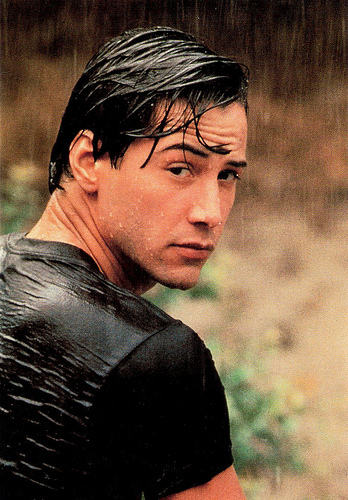
British postcard by Heroes Publishing LTD, London, no. SPC 2581. Photo: publicity still for Point Break (Kathryn Bigelow, 1991).
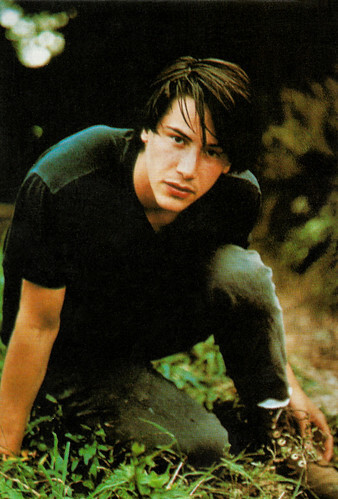
French postcard, no. C 466.
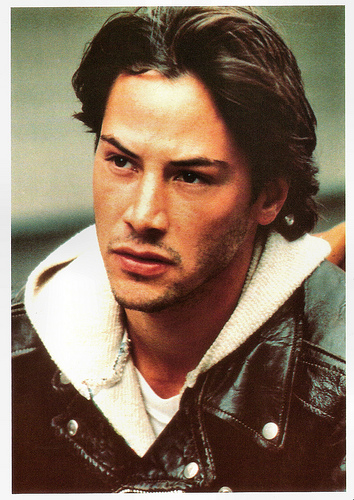
British postcard by Santoro Graphics Ltd., South Yorks, no. C350. Photo: publicity still for My Own Private Idaho (Gus Van Sant, 1991).
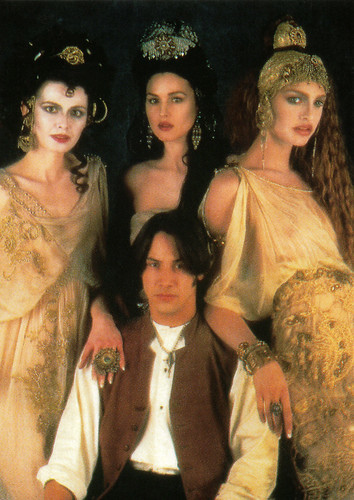
Dutch postcard by Film Freak Productions, Zoetermeer, no. FA 344, 1992. Photo: Columbia Pictures. Keanu Reeves, Michaela Bercu, Monica Bellucci and Florina Kendrick in Dracula (Francis Coppola, 1992).
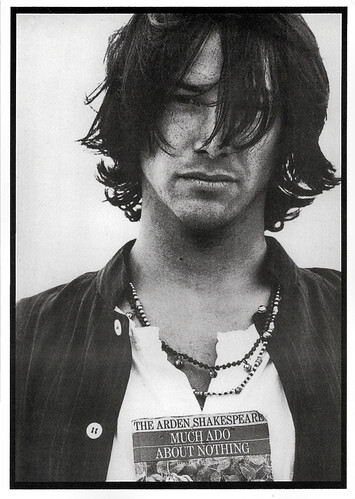
British postcard, no. C035. Caption: Keanu Reeves - Much ado about nothing.
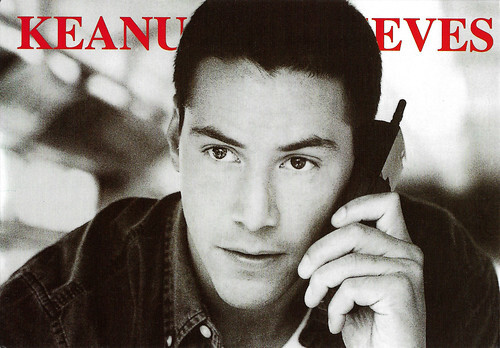
British postcard by Heroes Publishing LTD., no. SPC 2693. Photo: Warner Bros. Keanu Reeves in Speed (Jan de Bont, 1994).
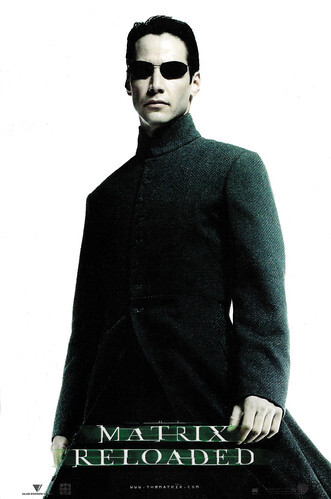
French postcard by Sonis, no. F. 100. Photo: Warner Bros. Keanu Reeves in The Matrix Reloaded (Lana Wachowski, Lilly Wachowski, 2003).
Cool breeze over the mountains
Keanu Charles Reeves was born in 1964, in Beirut, Lebanon. His first name means ‘cool breeze over the mountains’ in Hawaiian. His father, Samuel Nowlin Reeves Jr., was a geologist of Chinese-Hawaiian heritage, and his mother, Patricia Bond (née Taylor), was a British showgirl and later a costume designer for rock stars such as Alice Cooper.
Reeves's mother was working in Beirut when she met his father. Upon his parents’ split in 1966, Keanu moved with his mother and younger sister Kim Reeves to Sydney, to New York and then to Toronto. As a child, he lived with various stepfathers, including stage and film director Paul Aaron. Keanu developed an ardour for hockey, though he would eventually turn to acting. At 15, he played Mercutio in a stage production of Romeo and Juliet at the Leah Posluns Theatre. Reeves dropped out of high school when he was 17.
His film debut was the Canadian feature One Step Away (Robert Fortier, 1985). After a part in the teen movie Youngblood (Peter Markle, 1986), starring Rob Lowe , he obtained a green card through stepfather Paul Aaron and moved to Los Angeles.
After a few minor roles, he gained attention for his performance in the dark drama River's Edge (Tim Hunter, 1986), which depicted how a murder affected a group of adolescents. Reeves landed a supporting role in the Oscar-nominated period drama Dangerous Liaisons (Stephen Frears, 1988), starring Glenn Close and John Malkovich. Reeves joined the casts of Ron Howard's comedy Parenthood (1989), and Lawrence Kasdan's I Love You to Death (1990).
Unexpectedly successful was the wacky comedy Bill & Ted's Excellent Adventure (Stephen Herek, 1989) which followed two high school students (Reeves and Alex Winter) and their time-travelling high jinks. The success led to a TV series and a sequel, Bill & Ted's Bogus Journey (Pete Hewitt, 1991). From then on, audiences often confused Reeves's real-life persona with that of his 'doofy' on-screen counterpart.
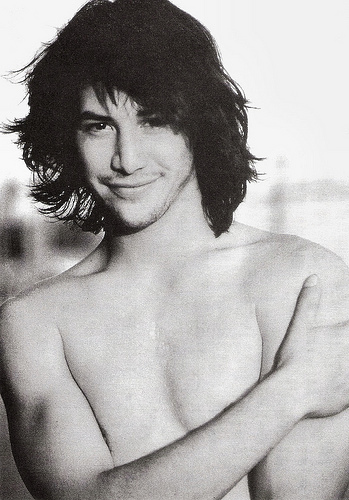
British postcard, no. 1034.
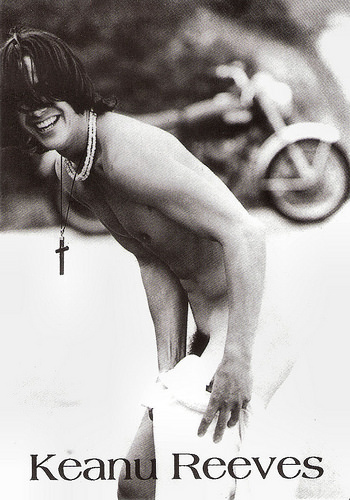
British postcard by Box Office, London, no. BO 007.
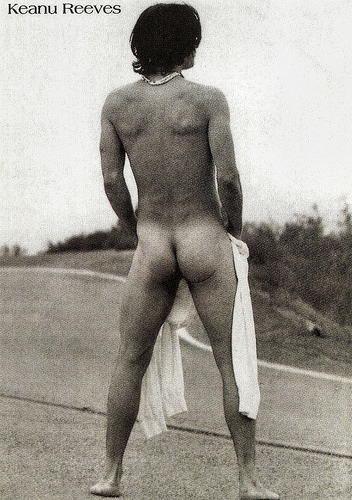
British postcard by Underground, London, no. MM 396.
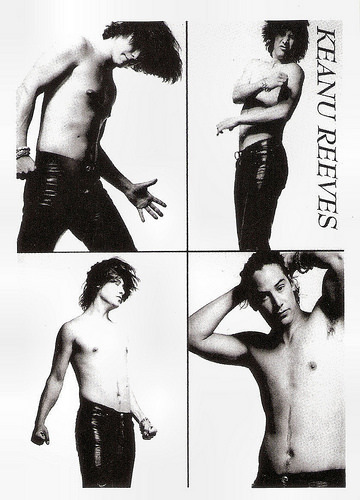
British postcard by Underground, London, no. BO110.
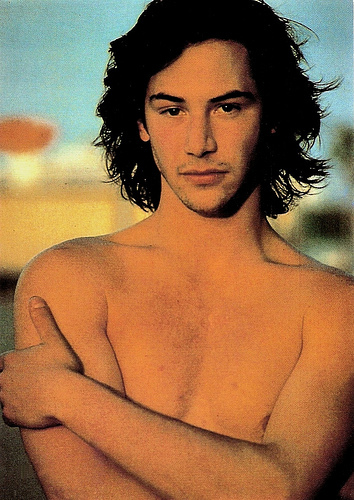
British postcard by Heroes Publishing LTD, London, no. SPC 2621.
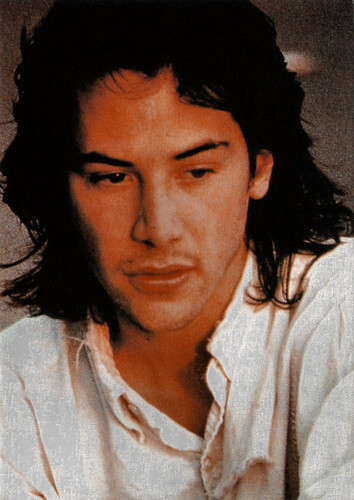
British postcard by Heroes Publishing LTD, London, no. SPC 2897.
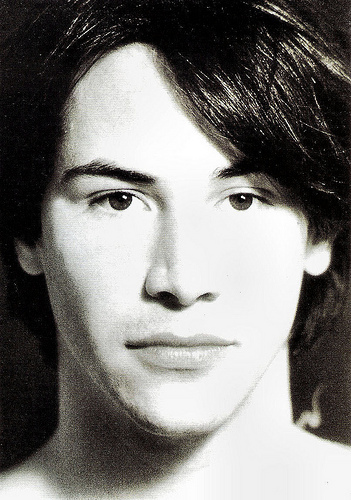
British postcard by Heroes Publishing Ltd., London, no. SPC 3017.
Most desirable male
In the following years, Keanu Reeves tried to shake the Ted stigma. He developed an eclectic film roster that included high-budget action films like the surf thriller Point Break (Kathryn Bigelow, 1991) for which he won MTV's ‘Most Desirable Male’ award in 1992, but also lower-budget art-house films.
My Own Private Idaho (1991), directed by Gus Van Sant and co-starring River Phoenix , chronicled the lives of two young hustlers living on the streets. In Francis Ford Coppola’s adaptation of Bram Stoker’s Dracula (1992), Reeves embodied the calm resolute lawyer Jonathan Harker who stumbles into the lair of Gary Oldman ’s Count Dracula.
In Europe, he played Prince Siddharta who becomes the Buddha in Bernardo Bertolucci’s Italian-French-British drama Little Buddha (1993).
His career reached a new high when he starred opposite Sandra Bullock in the hit action film Speed (Jan de Bont, 1994). It was followed by the romantic drama A Walk in the Clouds (Alfonso Arau, 1995) and the supernatural thriller Devil’s Advocate (Taylor Hackford, 1997), co-starring Al Pacino and Charlize Theron.
At the close of the decade, Reeves starred in a Sci-fi film that would become a genre game changer, The Matrix (Andy and Lana Wachowski, 1999). Reeves played the prophetic figure Neo, slated to lead humanity to freedom from an all-consuming simulated world. Known for its innovative fight sequences, avant-garde special effects and gorgeous fashion, The Matrix was an international hit. Two sequels, The Matrix Reloaded (Andy and Lana Wachowski, 1999) and The Matrix Revolutions (Andy and Lana Wachowski, 1999) followed and The Matrix Reloaded was even a bigger financial blockbuster than its predecessor.
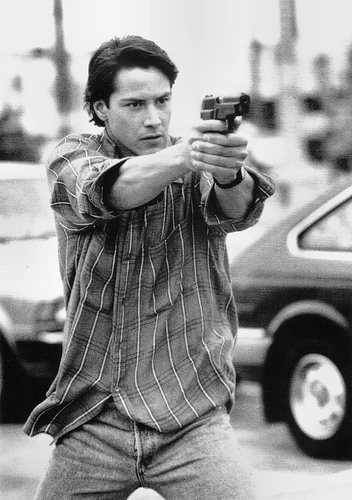
British postcard, no. 1004. Photo: publicity still for Point Break (Kathryn Bigelow, 1991).
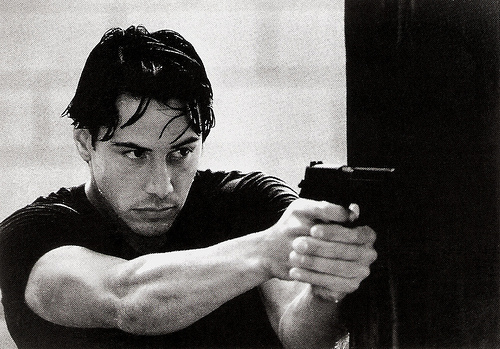
Vintage postcard, no. PP 105. Photo: publicity still for Point Break (Kathryn Bigelow, 1991).
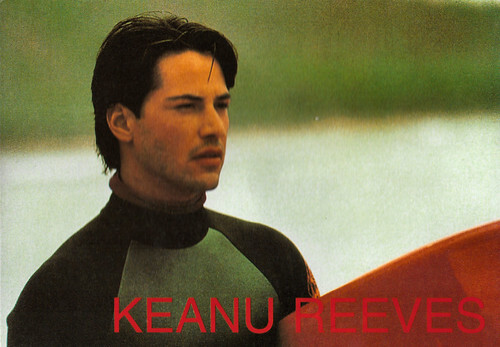
British postcard by Heroes Publishing LTD, London, no. SPC 2691. Keanu Reeves in Point Break (Kathryn Bigalow, 1991).
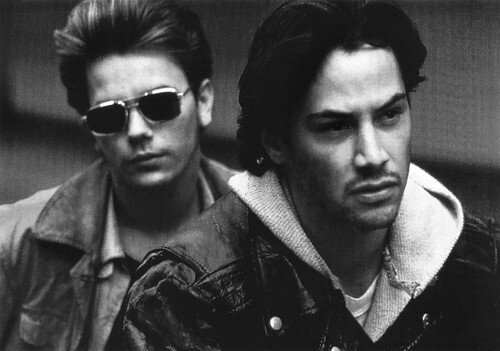
French postcard, no. 1035. Photo: publicity still for My Own Private Idaho (Gus Van Sant, 1991) with River Phoenix.
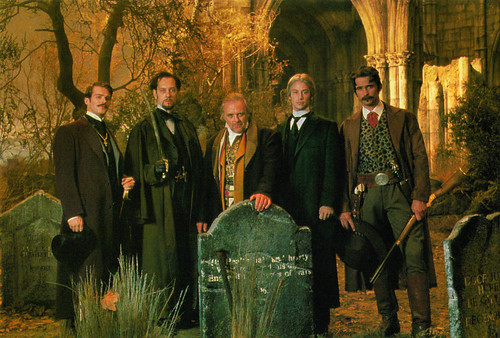
British postcard by Heroes Publishing LTD, London, no. SPC 2581. Photo: Cary Elwes, Richard Grant, Anthony Hopkins , Keanu Reeves, and Billy Campbell in Dracula (Francis Coppola, 1992).
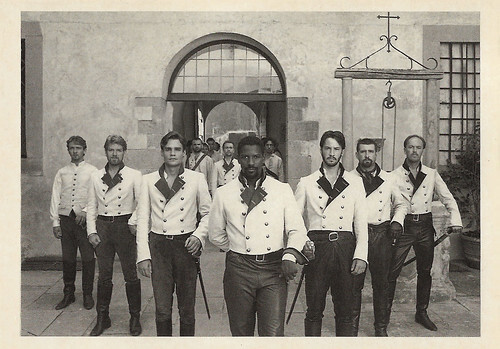
Canadian postcard by Canadian Postcard, no. A-250. Denzel Washington, Keanu Reeves, Robert Sean Leonard and Kenneth Branagh in Much Ado About Nothing (Kenneth Branagh, 1993).
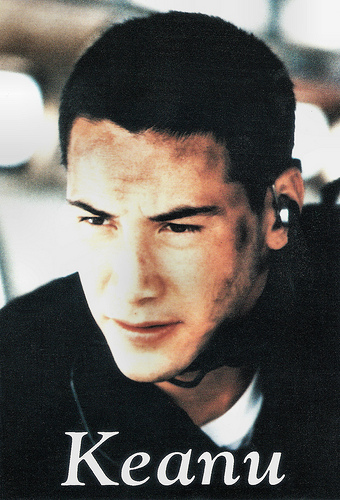
British postcard, no. 2070. Photo: publicity still for Speed (Jan de Bont, 1994).
A major bonafide box office star
Now a major, bonafide box office star, Keanu Reeves continued to work in different genres and both in big-budget as in small independent films. He played an abusive man in the supernatural thriller The Gift (Sam Raimi, 2000), starring Cate Blanchett , a smitten doctor in the romantic comedy Something’s Gotta Give (Nancy Meyers, 2003) opposite Diane Keaton, and a Brit demon hunter in American-German occult detective action film Constantine (Francis Lawrence, 2005).
His appearance in the animated science fiction thriller A Scanner Darkly (Richard Linklater, 2006), based on the novel by Philip K. Dick, received favourable reviews, and The Lake House (Alejandro Agresti, 2006), his romantic outing with Sandra Bullock, was a success at the box office. Reeves returned to Sci-fi as alien Klaatu in The Day the Earth Stood Still (Scott Derrickson, 2008), the remake of the 1951 classic. Then he played a supporting part in Rebecca Miller's The Private Life of Pippa Lee (2009), which starred Robin Wright and premiered at the 59th Berlin International Film Festival.
Reeves co-founded a production company, Company Films. The company helped produce Henry's Crime (Malcolm Venville, 2010), in which Reeves also starred. The actor made his directorial debut with the Chinese-American Martial arts film Man of Tai Chi (2013), partly inspired by the life of Reeves' friend, stuntman Tiger Chen. Martial arts–based themes continued in Reeves's next feature, 47 Ronin (Carl Rinsch, 2013), about a real-life group of masterless samurai in 18th-century Japan who avenged the death of their lord. Variety magazine listed 47 Ronin as one of "Hollywood's biggest box office bombs of 2013".
Reeves returned as a retired hitman in the Neo-Noir action thriller John Wick (Chad Stahelski, David Leitch, 2014). The film opened to positive reviews and performed well at the box office. Three sequels followed, John Wick: Chapter Two (Chad Stahelski, 2017) with Laurence Fishburne and Riccardo Scamarcio , John Wick: Chapter 3 – Parabellum (Chad Stahelski, 2019) with Halle Berry and John Wick: Chapter 4 (Chad Stahelski, 2023) with Donnie Yen. After co-starring with Winona Ryder in the rom-com Destination Wedding (Victor Levin, 2018), Reeves faced a busy 2019 with the release of the Sci-Fi thriller Replicas (), a return to action fare in John Wick 3: Parabellum, a supporting role in the Netflix rom-com Always Be My Maybe (Nahnatchka Khan, 2019) and his entry into a major animated franchise as the voice of stuntman Duke Caboom in Toy Story 4 (Josh Cooley, 2019). He reprised his roles as Ted in Bill & Ted Face the Music (Dean Parisot, 2020) and Neo in The Matrix: Resurrections (Lana Wachowski, 2021).
Keanu Reeves’ artistic aspirations are not limited to film. In the early 1990s, he co-founded the grunge band Dogstar, which released three albums. He also played bass for a band called Becky. Reeves is also a longtime motorcycle enthusiast. After asking designer Gard Hollinger to create a custom-built bike for him, the two went into business together with the formation of Arch Motorcycle Company LLC in 2011. Reported to be one of the more generous actors in Hollywood, Reeves helped care for his sister during her lengthy battle with leukaemia and has supported such organisations as Stand Up To Cancer and PETA. In January 2000, Reeves's girlfriend, Jennifer Syme, gave birth eight months into her pregnancy to Ava Archer Syme-Reeves, who was stillborn. The strain put on their relationship by their grief resulted in Reeves and Syme's breakup several weeks later. In 2001, Syme died after a car accident.
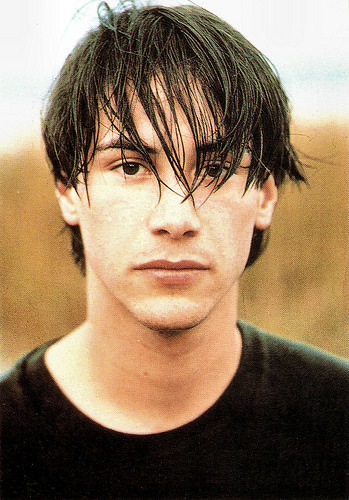
Vintage postcard, no. C 445.
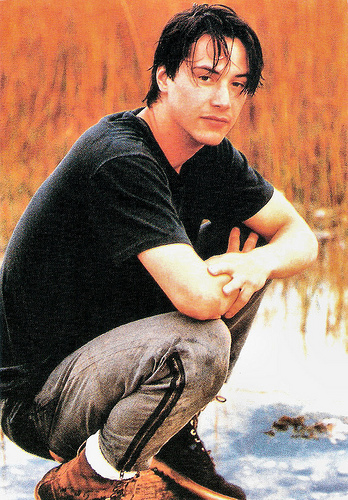
British postcard, no. MM373.
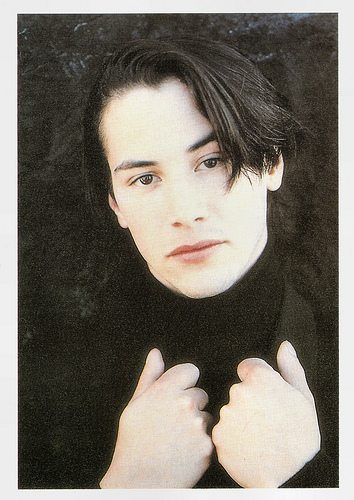
Spanish postcard by Coleccion Estrellas Cinematograficas, Cacitel, no. 73.
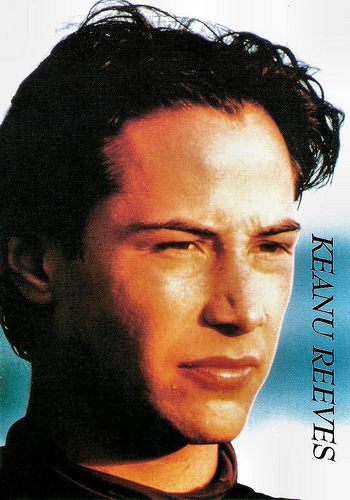
British postcard, no. MM371.

French postcard, no. 1027.
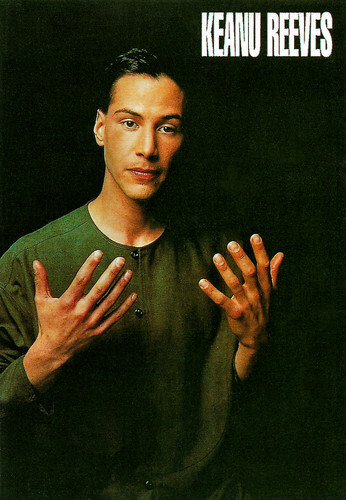
French postcard, no. Ref. 1109.
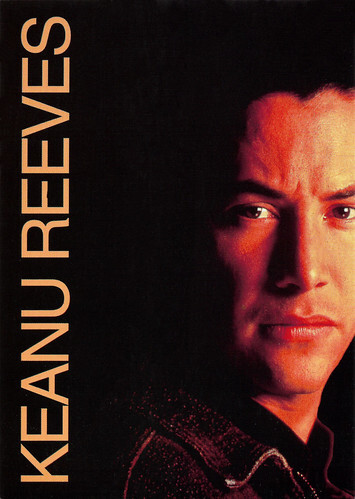
British postcard by Heroes Publishing LTD, London, no. SPC 2580.
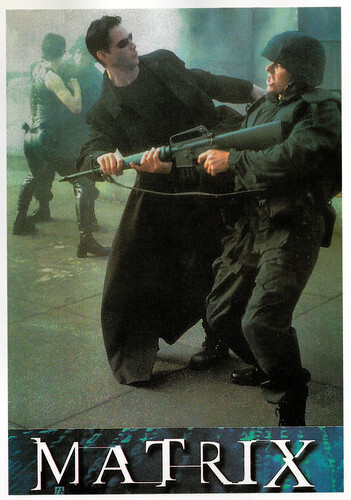
British postcard by Memory Card, no. 712. Lobby Card: Warner Bros. Keanu Reeves in The Matrix (Lana Wachowski, Lilly Wachowski, 1999).
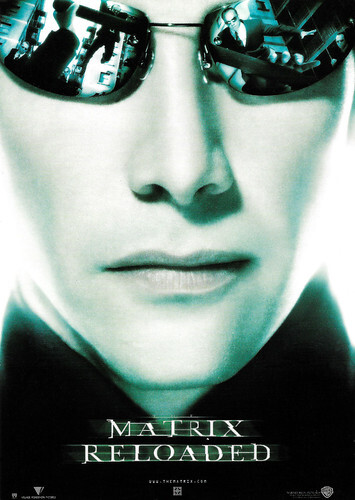
French postcard by Sonis, no. F. 112. Photo: Warner Bros. Keanu Reeves in The Matrix Reloaded (Lana Wachowski, Lilly Wachowski, 2003).
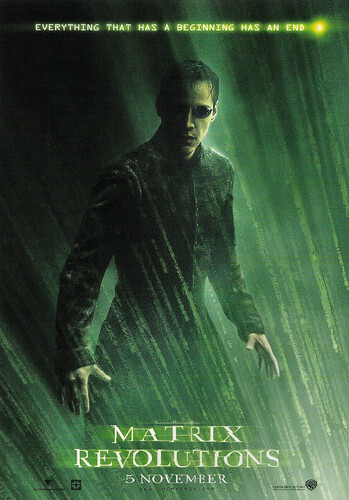
Dutch freecard by Boomerang, no. P22-03. Photo: Warner Bros. Keanu Reeves in The Matrix Revolutions (Lana Wachowski, Lilly Wachowski, 2003).
Trailer Bill & Ted's Excellent Adventure (1989). Source: Movieclips Trailer Vault (YouTube).
Trailer Point Break (1991). Source: Adam Jackson (YouTube).
Trailer Speed (1994). Source: 4thMealisGood (YouTube).
Trailer Little Buddha (1993). Source: vijay kumar (YouTube).
Trailer John Wick (2014). Source: Movieclips Trailers (YouTube).
Sources: Biography.com, Wikipedia and .

British postcard by Heroes Publishing LTD, London, no. SPC 2581. Photo: publicity still for Point Break (Kathryn Bigelow, 1991).

French postcard, no. C 466.

British postcard by Santoro Graphics Ltd., South Yorks, no. C350. Photo: publicity still for My Own Private Idaho (Gus Van Sant, 1991).

Dutch postcard by Film Freak Productions, Zoetermeer, no. FA 344, 1992. Photo: Columbia Pictures. Keanu Reeves, Michaela Bercu, Monica Bellucci and Florina Kendrick in Dracula (Francis Coppola, 1992).

British postcard, no. C035. Caption: Keanu Reeves - Much ado about nothing.

British postcard by Heroes Publishing LTD., no. SPC 2693. Photo: Warner Bros. Keanu Reeves in Speed (Jan de Bont, 1994).

French postcard by Sonis, no. F. 100. Photo: Warner Bros. Keanu Reeves in The Matrix Reloaded (Lana Wachowski, Lilly Wachowski, 2003).
Cool breeze over the mountains
Keanu Charles Reeves was born in 1964, in Beirut, Lebanon. His first name means ‘cool breeze over the mountains’ in Hawaiian. His father, Samuel Nowlin Reeves Jr., was a geologist of Chinese-Hawaiian heritage, and his mother, Patricia Bond (née Taylor), was a British showgirl and later a costume designer for rock stars such as Alice Cooper.
Reeves's mother was working in Beirut when she met his father. Upon his parents’ split in 1966, Keanu moved with his mother and younger sister Kim Reeves to Sydney, to New York and then to Toronto. As a child, he lived with various stepfathers, including stage and film director Paul Aaron. Keanu developed an ardour for hockey, though he would eventually turn to acting. At 15, he played Mercutio in a stage production of Romeo and Juliet at the Leah Posluns Theatre. Reeves dropped out of high school when he was 17.
His film debut was the Canadian feature One Step Away (Robert Fortier, 1985). After a part in the teen movie Youngblood (Peter Markle, 1986), starring Rob Lowe , he obtained a green card through stepfather Paul Aaron and moved to Los Angeles.
After a few minor roles, he gained attention for his performance in the dark drama River's Edge (Tim Hunter, 1986), which depicted how a murder affected a group of adolescents. Reeves landed a supporting role in the Oscar-nominated period drama Dangerous Liaisons (Stephen Frears, 1988), starring Glenn Close and John Malkovich. Reeves joined the casts of Ron Howard's comedy Parenthood (1989), and Lawrence Kasdan's I Love You to Death (1990).
Unexpectedly successful was the wacky comedy Bill & Ted's Excellent Adventure (Stephen Herek, 1989) which followed two high school students (Reeves and Alex Winter) and their time-travelling high jinks. The success led to a TV series and a sequel, Bill & Ted's Bogus Journey (Pete Hewitt, 1991). From then on, audiences often confused Reeves's real-life persona with that of his 'doofy' on-screen counterpart.

British postcard, no. 1034.

British postcard by Box Office, London, no. BO 007.

British postcard by Underground, London, no. MM 396.

British postcard by Underground, London, no. BO110.

British postcard by Heroes Publishing LTD, London, no. SPC 2621.

British postcard by Heroes Publishing LTD, London, no. SPC 2897.

British postcard by Heroes Publishing Ltd., London, no. SPC 3017.
Most desirable male
In the following years, Keanu Reeves tried to shake the Ted stigma. He developed an eclectic film roster that included high-budget action films like the surf thriller Point Break (Kathryn Bigelow, 1991) for which he won MTV's ‘Most Desirable Male’ award in 1992, but also lower-budget art-house films.
My Own Private Idaho (1991), directed by Gus Van Sant and co-starring River Phoenix , chronicled the lives of two young hustlers living on the streets. In Francis Ford Coppola’s adaptation of Bram Stoker’s Dracula (1992), Reeves embodied the calm resolute lawyer Jonathan Harker who stumbles into the lair of Gary Oldman ’s Count Dracula.
In Europe, he played Prince Siddharta who becomes the Buddha in Bernardo Bertolucci’s Italian-French-British drama Little Buddha (1993).
His career reached a new high when he starred opposite Sandra Bullock in the hit action film Speed (Jan de Bont, 1994). It was followed by the romantic drama A Walk in the Clouds (Alfonso Arau, 1995) and the supernatural thriller Devil’s Advocate (Taylor Hackford, 1997), co-starring Al Pacino and Charlize Theron.
At the close of the decade, Reeves starred in a Sci-fi film that would become a genre game changer, The Matrix (Andy and Lana Wachowski, 1999). Reeves played the prophetic figure Neo, slated to lead humanity to freedom from an all-consuming simulated world. Known for its innovative fight sequences, avant-garde special effects and gorgeous fashion, The Matrix was an international hit. Two sequels, The Matrix Reloaded (Andy and Lana Wachowski, 1999) and The Matrix Revolutions (Andy and Lana Wachowski, 1999) followed and The Matrix Reloaded was even a bigger financial blockbuster than its predecessor.

British postcard, no. 1004. Photo: publicity still for Point Break (Kathryn Bigelow, 1991).

Vintage postcard, no. PP 105. Photo: publicity still for Point Break (Kathryn Bigelow, 1991).

British postcard by Heroes Publishing LTD, London, no. SPC 2691. Keanu Reeves in Point Break (Kathryn Bigalow, 1991).

French postcard, no. 1035. Photo: publicity still for My Own Private Idaho (Gus Van Sant, 1991) with River Phoenix.

British postcard by Heroes Publishing LTD, London, no. SPC 2581. Photo: Cary Elwes, Richard Grant, Anthony Hopkins , Keanu Reeves, and Billy Campbell in Dracula (Francis Coppola, 1992).

Canadian postcard by Canadian Postcard, no. A-250. Denzel Washington, Keanu Reeves, Robert Sean Leonard and Kenneth Branagh in Much Ado About Nothing (Kenneth Branagh, 1993).

British postcard, no. 2070. Photo: publicity still for Speed (Jan de Bont, 1994).
A major bonafide box office star
Now a major, bonafide box office star, Keanu Reeves continued to work in different genres and both in big-budget as in small independent films. He played an abusive man in the supernatural thriller The Gift (Sam Raimi, 2000), starring Cate Blanchett , a smitten doctor in the romantic comedy Something’s Gotta Give (Nancy Meyers, 2003) opposite Diane Keaton, and a Brit demon hunter in American-German occult detective action film Constantine (Francis Lawrence, 2005).
His appearance in the animated science fiction thriller A Scanner Darkly (Richard Linklater, 2006), based on the novel by Philip K. Dick, received favourable reviews, and The Lake House (Alejandro Agresti, 2006), his romantic outing with Sandra Bullock, was a success at the box office. Reeves returned to Sci-fi as alien Klaatu in The Day the Earth Stood Still (Scott Derrickson, 2008), the remake of the 1951 classic. Then he played a supporting part in Rebecca Miller's The Private Life of Pippa Lee (2009), which starred Robin Wright and premiered at the 59th Berlin International Film Festival.
Reeves co-founded a production company, Company Films. The company helped produce Henry's Crime (Malcolm Venville, 2010), in which Reeves also starred. The actor made his directorial debut with the Chinese-American Martial arts film Man of Tai Chi (2013), partly inspired by the life of Reeves' friend, stuntman Tiger Chen. Martial arts–based themes continued in Reeves's next feature, 47 Ronin (Carl Rinsch, 2013), about a real-life group of masterless samurai in 18th-century Japan who avenged the death of their lord. Variety magazine listed 47 Ronin as one of "Hollywood's biggest box office bombs of 2013".
Reeves returned as a retired hitman in the Neo-Noir action thriller John Wick (Chad Stahelski, David Leitch, 2014). The film opened to positive reviews and performed well at the box office. Three sequels followed, John Wick: Chapter Two (Chad Stahelski, 2017) with Laurence Fishburne and Riccardo Scamarcio , John Wick: Chapter 3 – Parabellum (Chad Stahelski, 2019) with Halle Berry and John Wick: Chapter 4 (Chad Stahelski, 2023) with Donnie Yen. After co-starring with Winona Ryder in the rom-com Destination Wedding (Victor Levin, 2018), Reeves faced a busy 2019 with the release of the Sci-Fi thriller Replicas (), a return to action fare in John Wick 3: Parabellum, a supporting role in the Netflix rom-com Always Be My Maybe (Nahnatchka Khan, 2019) and his entry into a major animated franchise as the voice of stuntman Duke Caboom in Toy Story 4 (Josh Cooley, 2019). He reprised his roles as Ted in Bill & Ted Face the Music (Dean Parisot, 2020) and Neo in The Matrix: Resurrections (Lana Wachowski, 2021).
Keanu Reeves’ artistic aspirations are not limited to film. In the early 1990s, he co-founded the grunge band Dogstar, which released three albums. He also played bass for a band called Becky. Reeves is also a longtime motorcycle enthusiast. After asking designer Gard Hollinger to create a custom-built bike for him, the two went into business together with the formation of Arch Motorcycle Company LLC in 2011. Reported to be one of the more generous actors in Hollywood, Reeves helped care for his sister during her lengthy battle with leukaemia and has supported such organisations as Stand Up To Cancer and PETA. In January 2000, Reeves's girlfriend, Jennifer Syme, gave birth eight months into her pregnancy to Ava Archer Syme-Reeves, who was stillborn. The strain put on their relationship by their grief resulted in Reeves and Syme's breakup several weeks later. In 2001, Syme died after a car accident.

Vintage postcard, no. C 445.

British postcard, no. MM373.

Spanish postcard by Coleccion Estrellas Cinematograficas, Cacitel, no. 73.

British postcard, no. MM371.

French postcard, no. 1027.

French postcard, no. Ref. 1109.

British postcard by Heroes Publishing LTD, London, no. SPC 2580.

British postcard by Memory Card, no. 712. Lobby Card: Warner Bros. Keanu Reeves in The Matrix (Lana Wachowski, Lilly Wachowski, 1999).

French postcard by Sonis, no. F. 112. Photo: Warner Bros. Keanu Reeves in The Matrix Reloaded (Lana Wachowski, Lilly Wachowski, 2003).

Dutch freecard by Boomerang, no. P22-03. Photo: Warner Bros. Keanu Reeves in The Matrix Revolutions (Lana Wachowski, Lilly Wachowski, 2003).
Trailer Bill & Ted's Excellent Adventure (1989). Source: Movieclips Trailer Vault (YouTube).
Trailer Point Break (1991). Source: Adam Jackson (YouTube).
Trailer Speed (1994). Source: 4thMealisGood (YouTube).
Trailer Little Buddha (1993). Source: vijay kumar (YouTube).
Trailer John Wick (2014). Source: Movieclips Trailers (YouTube).
Sources: Biography.com, Wikipedia and .
Published on November 21, 2024 22:00
Paul van Yperen's Blog
- Paul van Yperen's profile
- 13 followers
Paul van Yperen isn't a Goodreads Author
(yet),
but they
do have a blog,
so here are some recent posts imported from
their feed.



